
MAKING AN IMPACT
First-generation ranchers find success marketing Brahman beef directly to consumers.
GREATER ACCURACY
How DNA testing and genomically enhanced EPDs inform progress in commercial cow-calf herds.



First-generation ranchers find success marketing Brahman beef directly to consumers.
How DNA testing and genomically enhanced EPDs inform progress in commercial cow-calf herds.

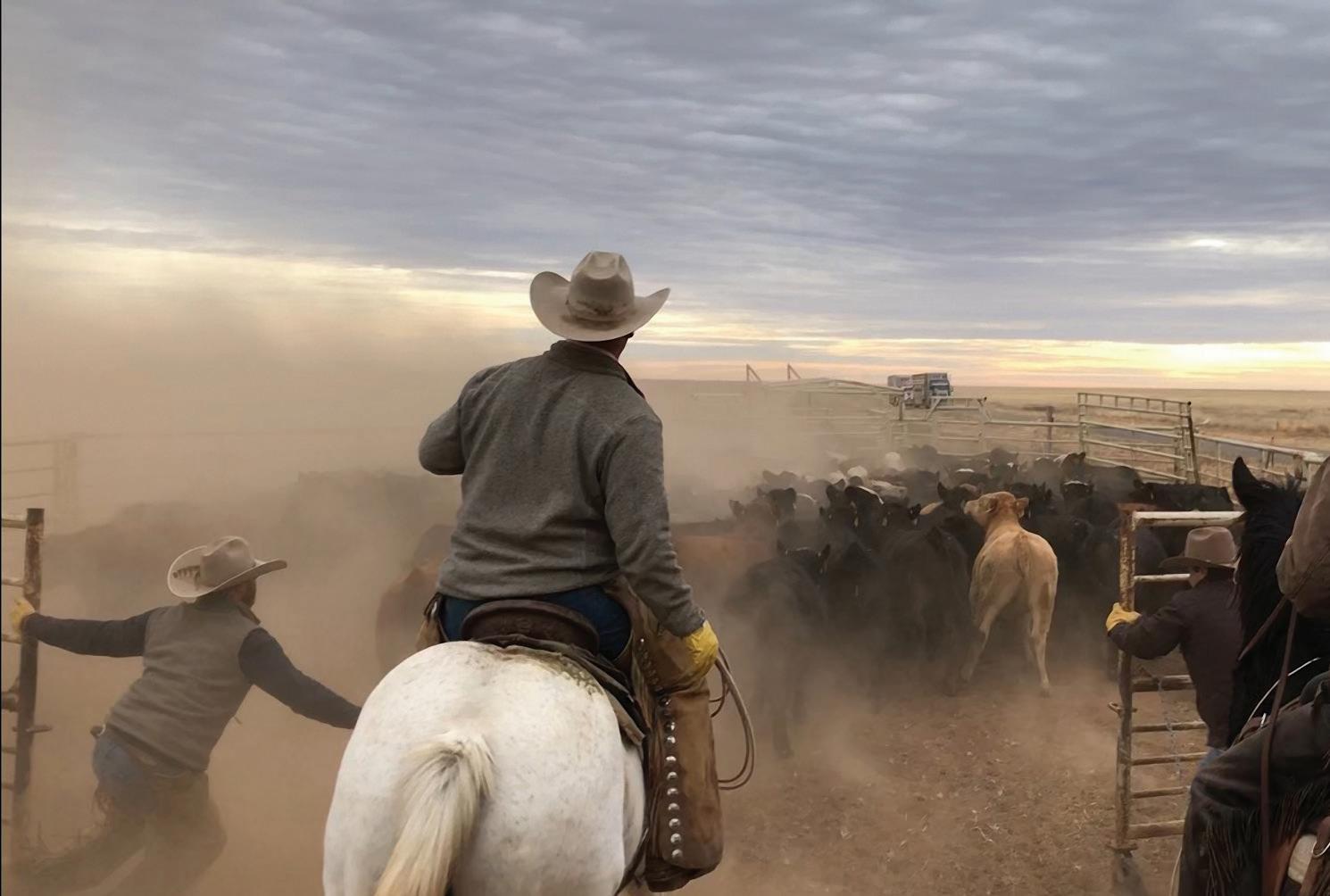

Birdwell Plainview, TX (806) 681-3667
Griffin Atoka, OK (580) 271-1333
Johnson Dallas, TX (214) 384-2653
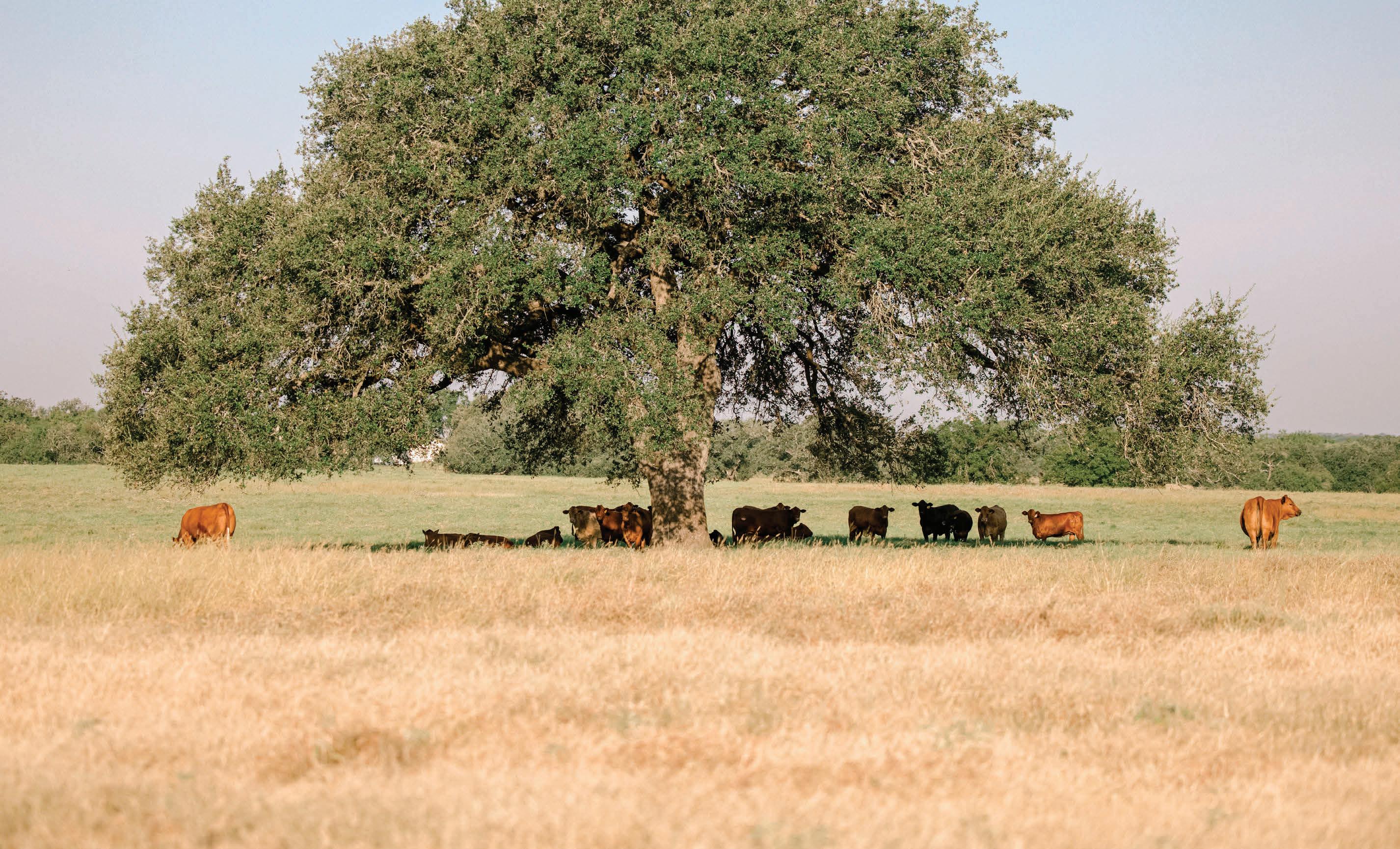
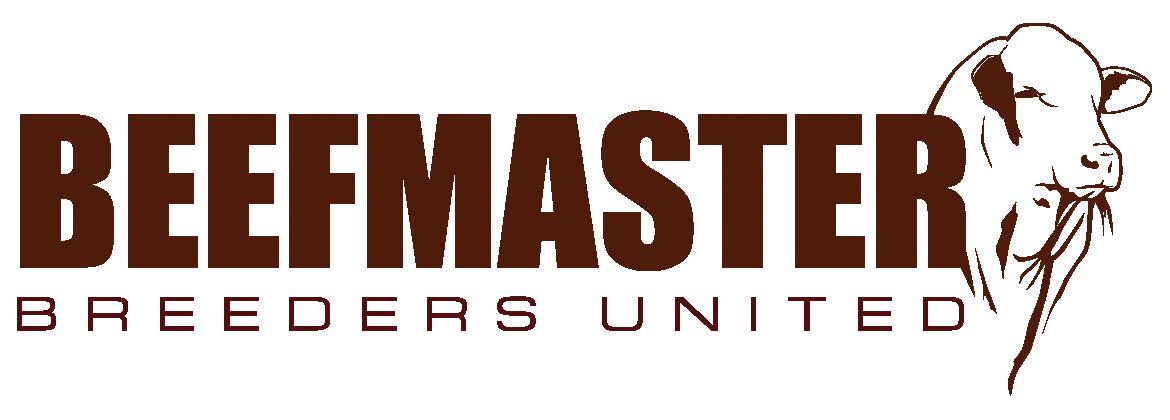

How the Gonzalez family is proving Brahman genetics belong in the carcass quality conversation.
By Shelby Kirton

A look into how genomic data informs progress in commercial herds.
By Jena McRell

Texas A&M Beef Cattle Short Course panelists: Plan now to minimize impact if NWS crosses the border.
A conservation easement helps the Cornelius family keep their Matagorda County ranch intact.
(Artemisia filifolia)
A Business Approach to Bull Buying Investments made today will shape the herd tomorrow.

As a Texas & Southwestern Cattle Raisers Association member, October means one thing: The Cattleman Bull Buyer’s Guide. It is a wellknown tradition that brings excitement to those on the hunt for their next herd sire.
Our annual Bull Buyer’s Guide is jam-packed with sales featuring the latest genetics and programs that are drumming up excitement throughout the Southwest.
The largest magazine of the year, this issue features more than just great ads. Our writers also explore the science and genetics that are shaping the future of the beef industry, from DNA testing and genomically enhanced EPDs to the role of artificial intelligence.
We will also introduce you to a family who is finding success in new and unexpected ways. The Gonzalez family raise Brahman cattle and market their beef through a growing direct-to-consumer business. In the feature story starting on page 10, we explore the latest research on Brahman genetics and discover how this resilient breed can meet modern consumer tastes and preferences.
This story is also unique as the Gonzalez family are recipients of the Texas & Southwestern Cattle Raisers
Association’s Leadership Development Foundation Working Grant Program, which helps future land and livestock stewards expand their beef businesses. Just as genetics build stronger herds, the program builds stronger generations of cattle raisers.
The fall application window for grants opens Nov. 1. Learn more about how the association is helping new cattle raisers grow and expand their role in the beef supply chain, and how you can help support the program and these efforts on page 18.
Wishing everyone a successful sale season and hope you enjoy the latest issue of The Cattleman T C

Jaclyn Roberts Parrish Executive
Director of Communications, Marketing & Partnerships/Editor-in-Chief, The Cattleman jaclyn@tscra.org • 817-916-1794

October 2025 / / Vol. CXII, No. 5
Published by Texas & Southwestern Cattle Raisers Association
P.O. Box 101988, Fort Worth, Texas 76185 Phone: 817.332.7064 • Fax: 817.394.1864 tscra.org
EDITORIAL
Editor-in-Chief Jaclyn Roberts Parrish
Managing Editor Jena McRell
Associate Editor
Shelby Kirton
Copy Editors Kayla Jennings, Elyssa Foshee Sanders
Graphic Designer Ryan Barten
ADVERTISING
Director of Sales Jacob Snyder
EXECUTIVE DIRECTORS
Executive Vice President/CEO Jason Skaggs
Communications, Marketing & Partnerships Jaclyn Roberts Parrish
Events, Education & Leadership Development Emily Lochner
Finance & Human Resources Megan Wills
Government Relations Melissa Hamilton
Law Enforcement, Brand & Inspection Services Clay McKinney
Membership & Operations Lisa Walker
OFFICE LOCATIONS
Fort Worth
2813 S. Hulen St., Suite 150 Fort Worth, Texas 76109 Austin 919 Congress Ave., Suite 750 Austin, Texas 78701
Subscription Inquiries: tscra@tscra.org or 800-242-7820
Advertising Sales: sales@tscra.org or 817-332-7064

Stepping out with a group of Santa Gertrudis bulls near Hondo.
Changing seasons means changing landscapes on the ranch.
Photos by Kayla Jennings
The Bull Buyer’s Guide, starting on page 61, is a special advertising section filled with upcoming sales and private treaty opportunities.
Photo by Emily McCartney
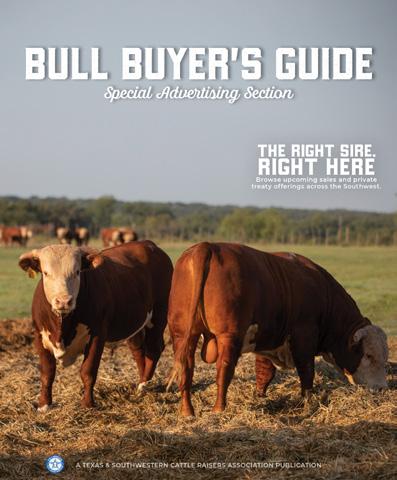
The
Texas 76185, 817-332-7064, FAX 817-394-1864. All members of Texas & Southwestern Cattle
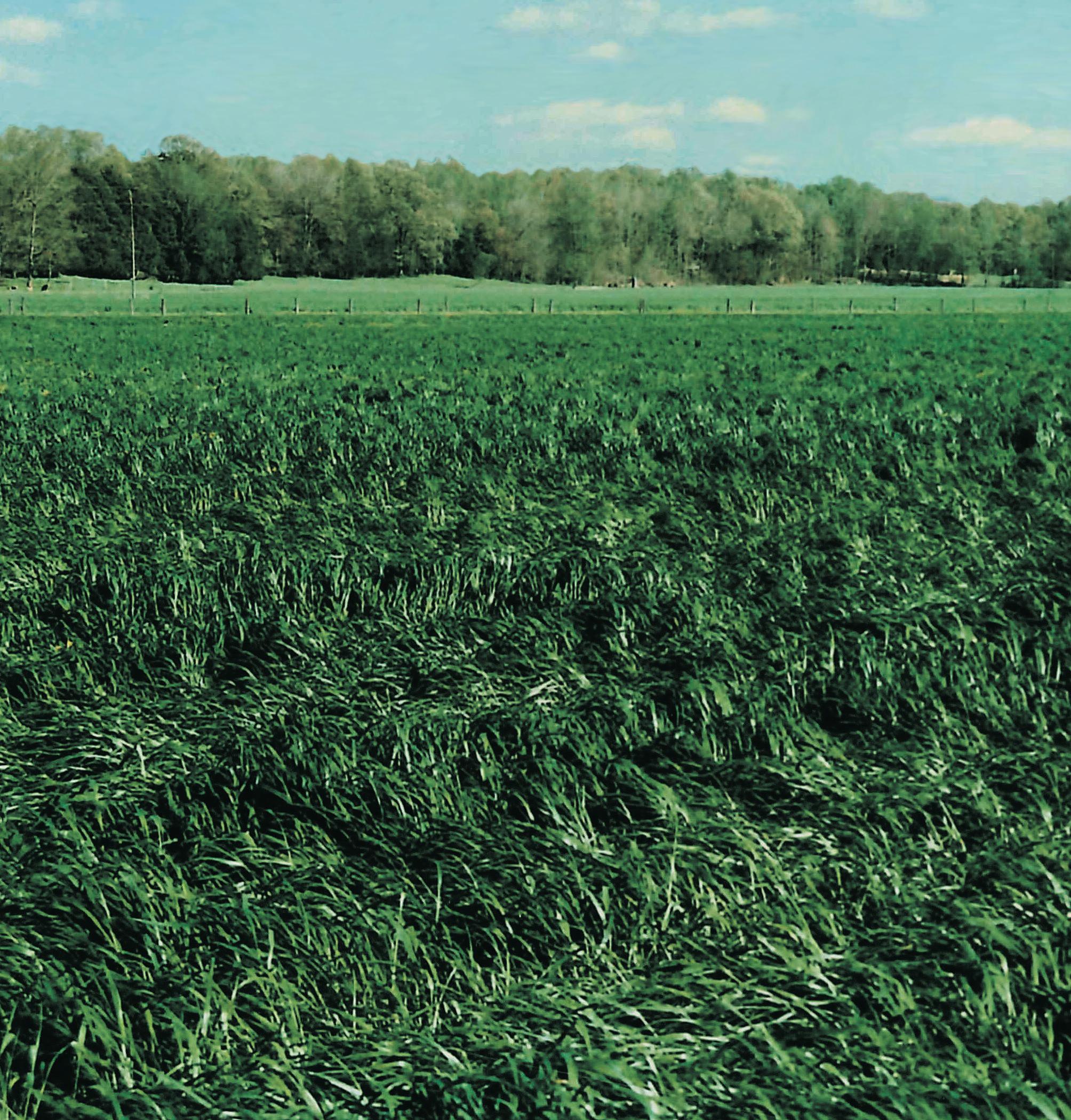
“ WAX Genuine Marshall ryegrass is my choice of ryegrass … been planting ryegrass for more than 20 years for grazing and hay. Majority of the time I have used WAX Marshall, but also try some of the new ryegrasses to see how they compare to my standard… WAX Marshall… I am still a WAX Marshall ryegrass man!
I have tried the “Generic Marshall” from my local co-op. In short, it did not come close to production or have the carrying capacity like WAX Marshall… it looked more like Gulf… it did not have the vigor and fast recovery like WAX Marshall.
Every year is different and full of unexpected surprises, but from all my years with WAX Marshall, I feel confident in the outcome. The “Generic” just did not produce. Planting 700 acres of ryegrass, I do not need any surprises for myself or my cattle.
There has only been one consistent ryegrass for me for over 20 years… WAX Marshall ryegrass.
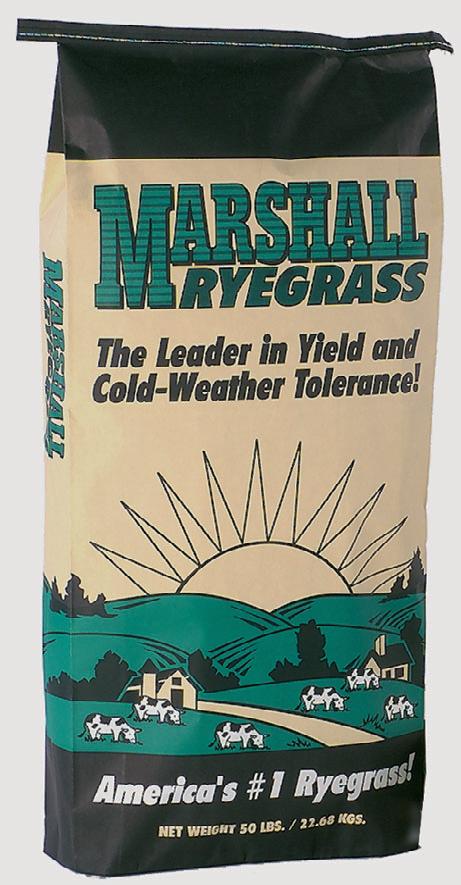
If you want real Marshall ryegrass, make sure you ask for WAX Genuine Marshall… I do! ”


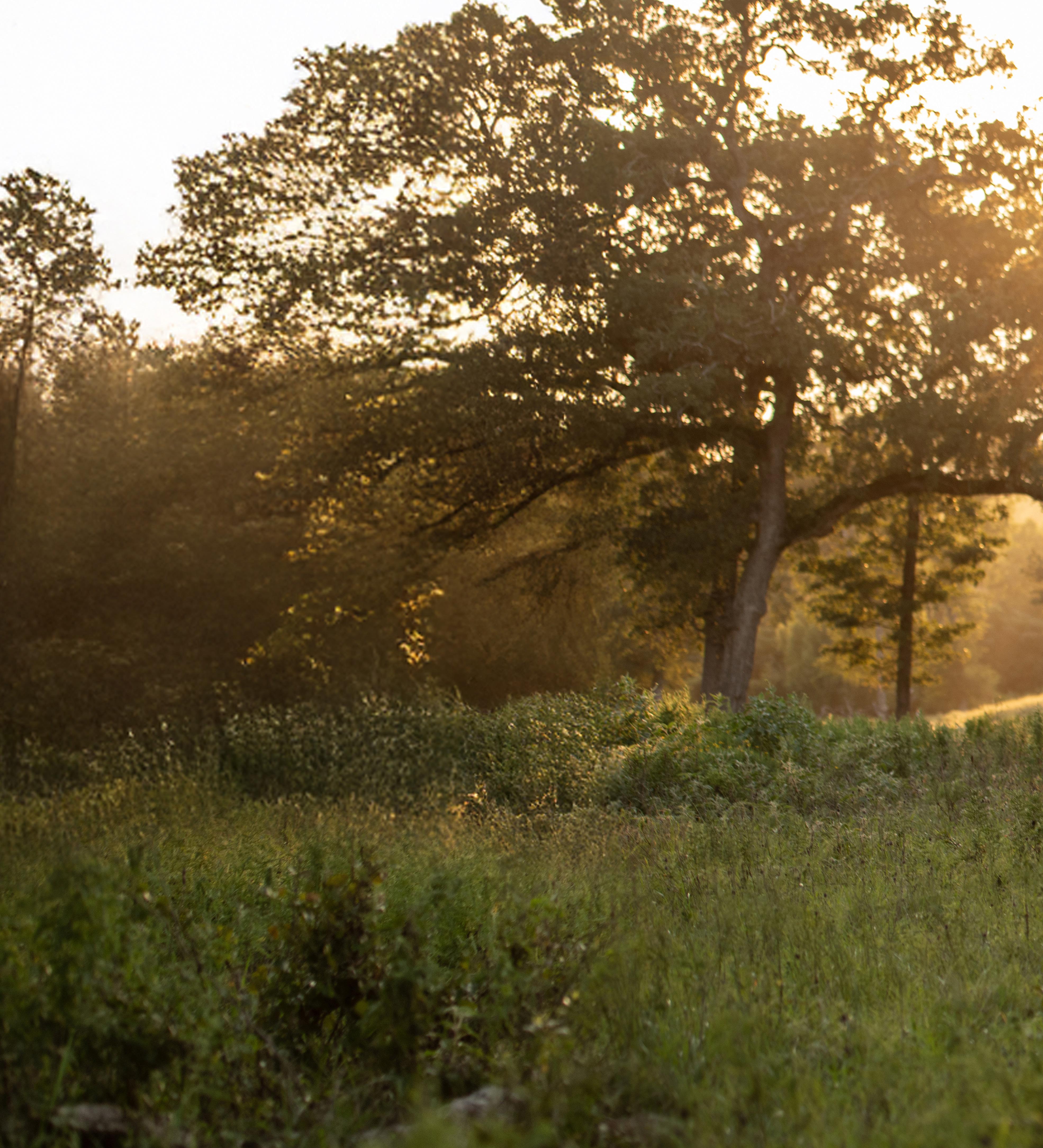

Todd Thrift, Ph.D., beef cattle Extension specialist and professor at the University of Florida, agrees Brahman and Brahman-influenced cattle have a history to overcome when it comes to carcass traits. “A lot of the perception about Bos indicus beef quality is based on genetics from 30-40 years ago,” he says. “Today’s Brahman genetics are a whole different story.”
The Brahman breed was originally introduced into the U.S. for their adaptability in hot, humid and parasite-heavy environments. In the Southeast and Southwest, where British breeds tended to struggle, Brahmans thrived. But their heat tolerance came with a catch: leaner carcasses, lower marbling and sometimes less tender beef.
“In the 1970s and ’80s, when a lot of that data was being collected, Brahman cattle hadn’t been selected with carcass traits in mind,” Thrift shares for perspective. “They were being selected for survival. But just like Angus and Hereford have been improved over the years, so have Brahmans. The science and the cattle are both different now.”
Results from the Florida Fed Beef Challenge, which was conducted by Thrift from 2019 to 2023 on around 615 head, found cattle with Brahman influence averaged just under low Choice, with about half grading Choice or higher, and had tenderness scores nearly identical to retail Choice beef. Steers with less than or equal to 50% Brahman influence were no less tender than cattle with 0% Brahman, showing that using a half-blood cow provides adaptability while still producing highly acceptable beef.
On a national scale, American Brahman Breeders Association is dedicated to measuring improvements in carcass quality, adding selection tools like the $BULL index, which was launched in 2023 and prioritizes endproduct merit, carcass traits and genomically enhanced EPDs for marbling and tenderness.
Science is catching up with the story cattle raisers like the Gonzalezes are living every day. Ultimately, their family’s goal is to produce cattle that grade Choice and higher, and data is part of that process.
In the last few years, they have improved from less than 60% grading Choice to about 85% today, progress they credit to carcass scans, closely tracking bloodlines and intentional breeding decisions that emphasize both feed efficiency and beef quality.
That growth has been supported in part by the Texas & Southwestern Cattle Raisers Association’s Leadership Development Foundation Working Grant Program, which awarded funding to the Gonzalez family.
The program is designed for beginning or expanding ranchers looking to grow a beef industry business. The grant allowed them to purchase equipment critical for safely working their cattle and collecting performance data, which Amber says has elevated their operation.
“It took a financial weight off our shoulders. I am forever grateful to anybody who had a part in giving that to us,” she says. “It’s one thing to raise pretty cattle, but if they don’t eat well, that’s not the future.”

“Today’s Brahman genetics are a whole different story.”
— Todd Thrift, University of Florida

Better tools are helping producers everywhere hit higher marks at a faster pace.
Thrift echoes how these advancements in technology now make it possible to select for heat tolerance and carcass quality at the same time, something that was not achievable a decade ago. Selection indexes, for example, now incorporate adaptation and carcass traits. Other tools, like genomic testing, ultrasound scans and carcass EPDs, make for smarter selection decisions.
“You don’t have to sacrifice adaptation to get quality; you can have both,” Thrift assures.
“That means a producer in Texas or Florida can produce animals that thrive in heat and humidity but also have strong marbling genetics. Crossbreeding is really the key. Brahmans have always been a crossbreeding common denominator.”
The cow herd at La Estancia Ranch is a testament to having the best of both worlds. Gonzalez explains their program is built around balance, with emphasis on fertility, mothering ability, performance and carcass
quality. This approach produces cattle that perform in challenging conditions while maintaining health, tolerating heat and converting feed efficiently.
Crossbreeding is another piece of the puzzle. “We’ve used crossbreeding to hit different markets, but Brahman influence is always at the core,” Amber says. “Everything gets better when you breed it with a Brahman.”
Thrift points to examples like crossbreeding Brahman and Angus to combine heat tolerance, fertility and carcass quality. He says Brahman-influenced cattle generally perform well in warm climates during the stocker phase, where stress often hinders other cattle. In the feedlot, with proper selection and management, they are also able to reach the same carcass endpoints as other breeds.
This combination of health, efficiency and adaptability is becoming more critical as shifting weather patterns put new pressures on beef production. “With climate change and rising heat stress, Bos indicus genetics will only become more valuable,” he adds.
To showcase what the breed can offer in terms of beef quality, the Gonzalez family leverages a direct-toconsumer market for their Brahman-centered cattle.
Brahman Darlin’ Beef raises resilient, efficient cattle that serve up tender and flavorful beef. Their cattle are processed just 20 minutes down the road at Legacy in La Grange, allowing the family to stay closely connected to how their beef is handled from pasture to plate.
Marketing their beef directly to consumers allows the Gonzalezes to connect with buyers firsthand, often challenging their expectations about Brahmaninfluenced beef.
Their customer base is mostly in the Austin area and includes food enthusiasts, fitness-minded individuals and families. Amber says that while the fitness crowd appreciates the leanness, almost everyone admits they didn’t expect the beef to taste as good as it does.
“Our customers come back saying it’s tender, it’s flavorful, it’s different,” she says. “And I think that surprises people.”
She recalls one customer’s reaction, who shared, “‘This can’t be Brahman. It’s too tender!’” Amber laughs, “That’s the best compliment we can get.”
Thrift says consumer taste panels show the same phenomenon. He observes when consumers don’t know what they’re eating, Brahman-influenced beef often performs just as well as other breeds.

“Our customers come back saying it’s tender, it’s flavorful, it’s different.”
— Amber Gonzalez, Brahman Darlin’ Beef

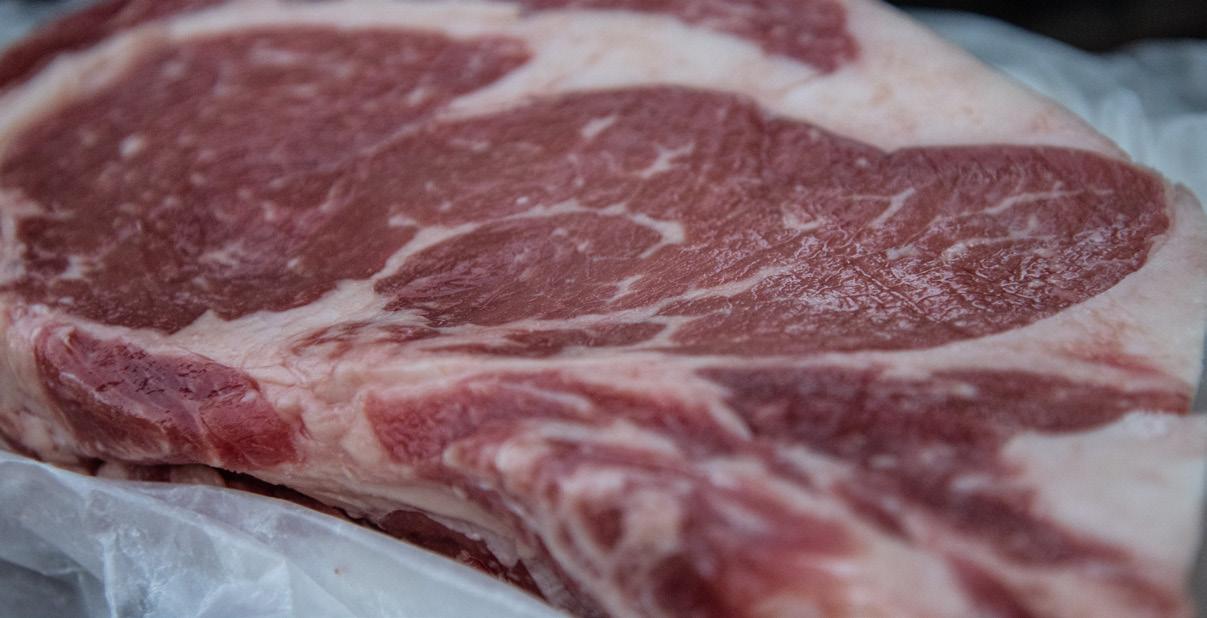
From pasture to plate, here’s how
Lean into the story.
“People want to know who raised their beef and why. When they hear ‘Brahman,’ they lean in — it’s unique,” she says.
Focus on flavor.
Consumers aren’t always looking for marbling scores; they’re looking for an eating experience.
“The bold flavor of Brahman beef keeps our customers coming back.”
Educate with every box.
Customers often think Brahman beef is tough — until they taste it. Amber includes cooking tips and information cards with every order.
Think outside the steak.
Tallow skincare, bones for broth and organ meats open doors to new audiences and minimize waste.
Stay consistent. Reliable communication, packaging and delivery are some of the most effective ways to build trust in a brand.
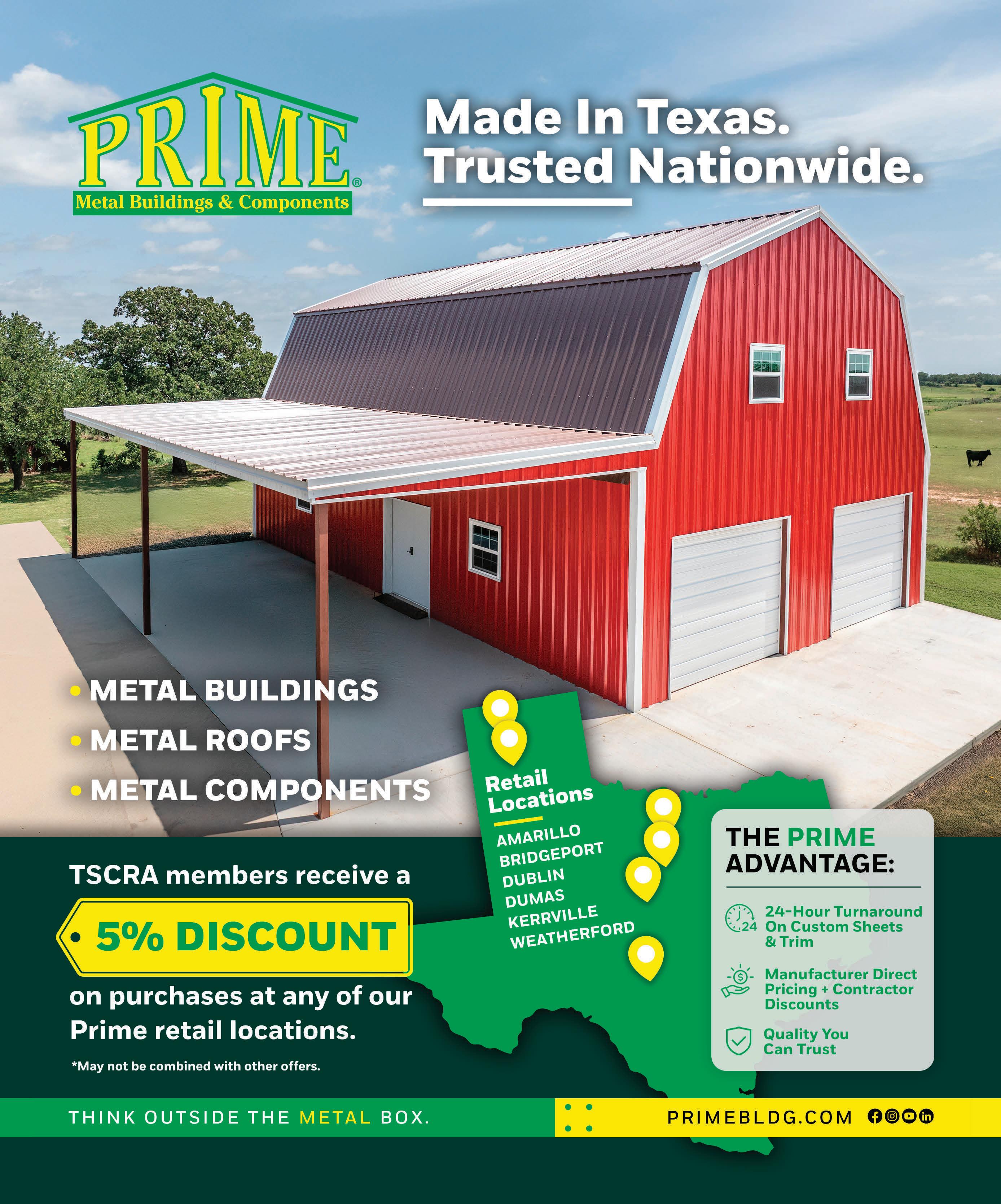

Shifting consumer perception can be more challenging than changing Brahman-based beef itself, but the adaptability on the ranch and in the market reflects the nature of the cattle.
“Brahmans have always been about adaptability,” Thrift says. “Now we’re just adapting the narrative, too.”
For the Gonzalez family, education is part of the mission to rewrite the breed’s story. Direct marketing gives them the opportunity to frame Brahman beef differently. When Amber interacts with customers, she shares the history and adaptability of the breed.
“It’s not just beef — it’s heritage, it’s sustainability, it’s something unique,” she says. “People love the idea of eating a steak that comes from a breed built for Texas conditions. Once they taste the beef, the story sticks.”
The appeal of Brahman beef isn’t limited to Texas. Around the world, consumers in Latin America, Asia and the Gulf Coast regions heavily value Bos indicus cattle. According to Thrift, many countries regard Brahman as synonymous with quality because of its adaptability. “The U.S. has an opportunity to tap into those export markets by branding Brahman beef not as a compromise, but as a premium product,” he says.
Amber sees the same opportunity, too. “We’ve had customers from other countries who tell us, ‘This is what we grew up eating.’ For them, it’s not new — it’s nostalgia, and that’s powerful.”
Looking ahead, Brahman Darlin’ Beef isn’t stopping at steaks and ground beef. They’ve launched a line of skincare products using beef tallow. “It’s just another way these cattle provide for us,” Amber says.
Most importantly, she sees Brahmans as part of her family’s legacy.
She says the hope is Brahman Darlin’ Beef is not just a business, but a way of life that can sustain future generations. That vision, which blends heritage, hard work and a commitment to better beef, is what keeps the family pushing forward even when the challenges seem steep.
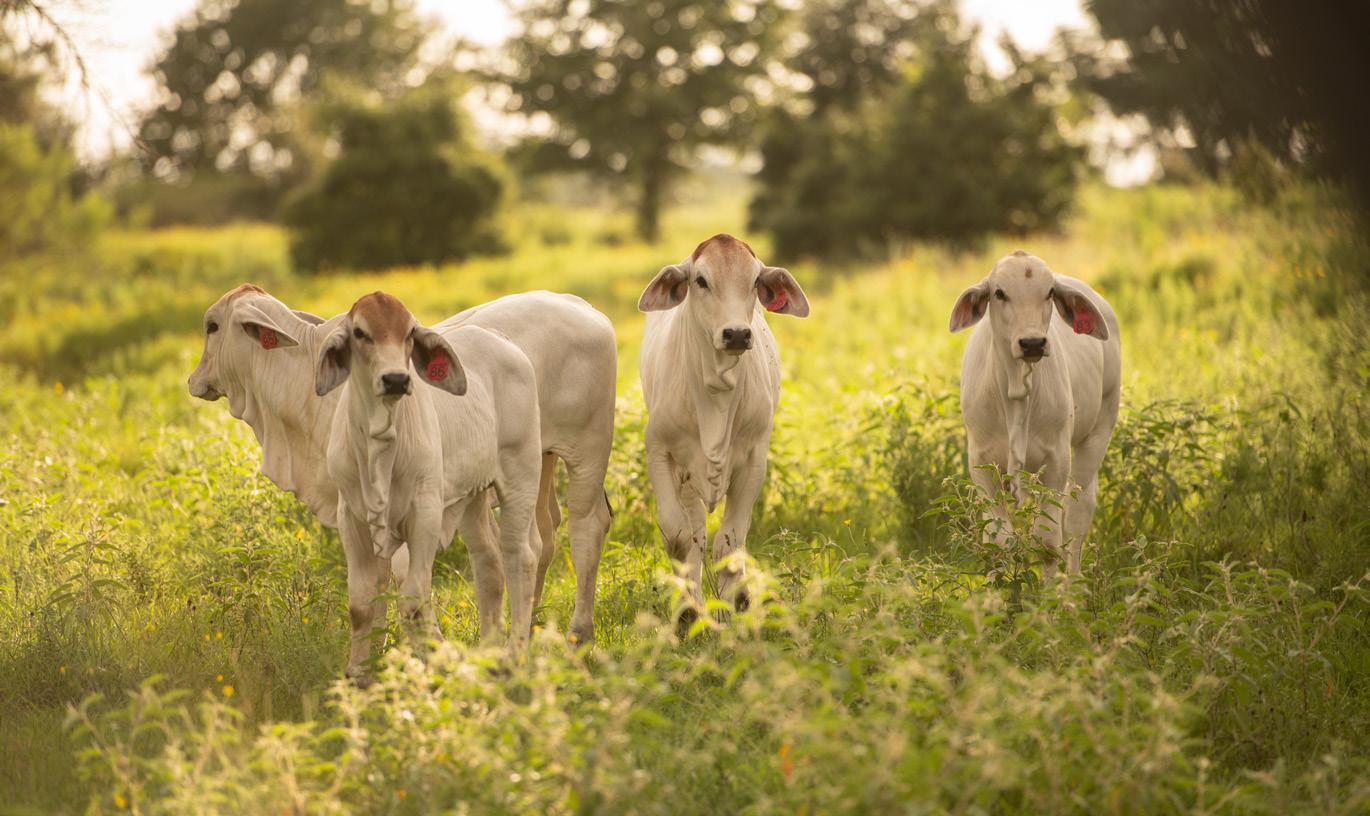

When it comes to ranching, farming and agri-business, there’s no single solution—except for insurance. Cattle Raisers Insurance and Higginbotham have teamed up to bring you tailored coverage, competitive rates and ser vice that speaks your language.


From your land and livestock to the health of your employees and family, we’ ve got you covered with:
• Custom policies for ranching and agriculture
• Affordable health plans designed to suppor t you and your team
• Exclusive discounts for TSCRA members
• Local exper tise backed by national buying power
• Boots-on-the -ground ser vice you can count on
Together, we’re your par tner in protecting your proper ty, people, livelihood and legacy.
Learn how this par tnership works for you at higginbotham.com
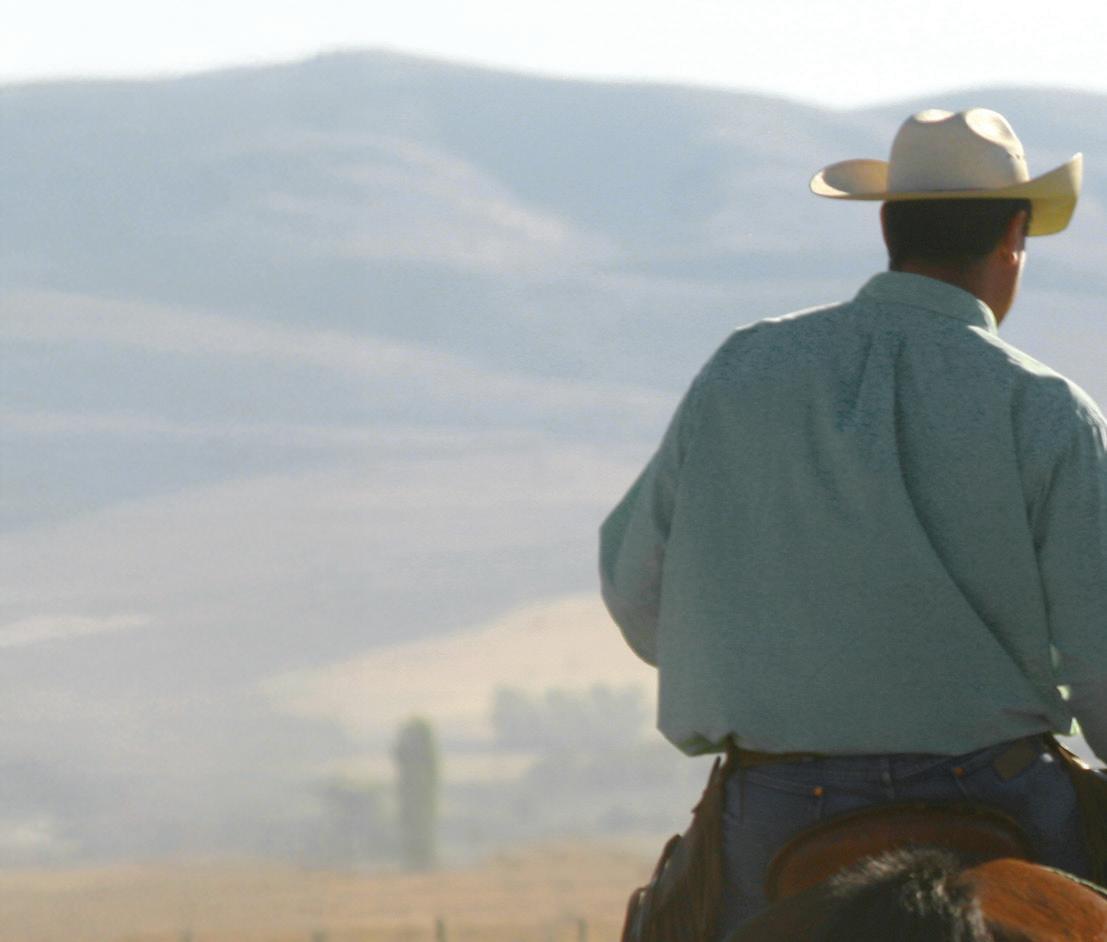

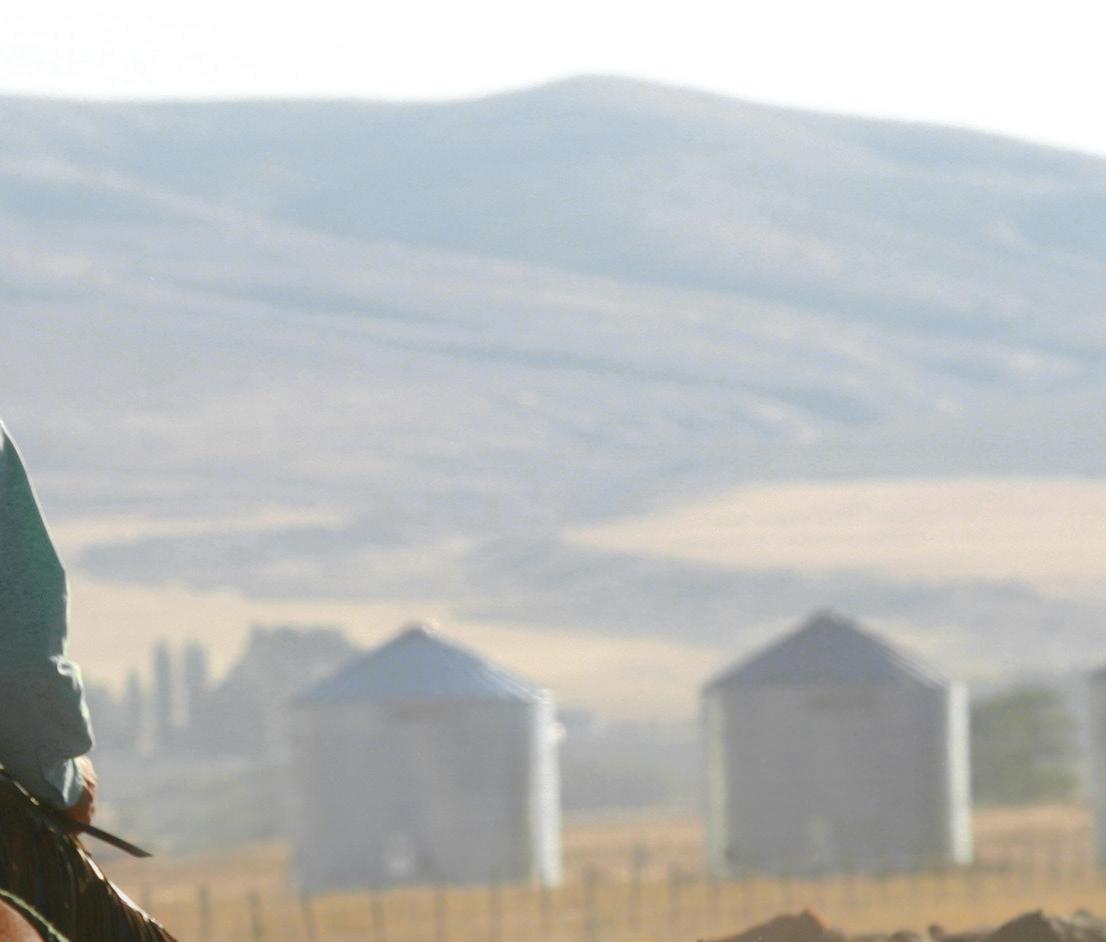





Adam Gonzalez, the family’s oldest son, is already charting a future in ranching. He recently started his senior year of high school and has his sights set on enrolling in Texas Christian University’s Ranch Management program. Reagan, the younger brother but equally invested, is growing up with cattle work as second nature.
“We’re putting blood, sweat and tears into everything now to build a legacy for our kids, our grandkids and beyond,” Amber says. “We want to show the next generation that Brahmans are the future, not the past.” T C




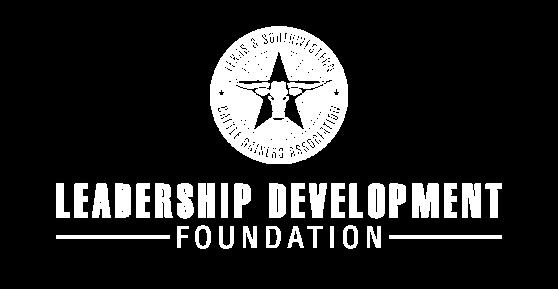
The Gonzalez family, in their efforts to grow La Estancia Ranch and Brahman Darlin’ Beef, has been supported in part by the Texas & Southwestern Cattle Raisers Association’s Leadership Development Foundation Working Grant Program.
Launched in 2024, the program is designed to put financial capital into the hands of young and emerging leaders in the cattle business.
• Who it helps: Entrepreneurs who have a vested interest in a part of the beef value chain — from cow-calf operations and stocker programs to direct-to-consumer beef ventures.
• Where it’s targeted: Applicants must operate in economically challenged or blighted areas of Texas or Oklahoma.
• What it supports: Grants can fund projects that otherwise might not receive conventional financing, giving ranchers and entrepreneurs the chance for innovation in their businesses.
• Why it matters: By supporting people, like the Gonzalez family, Texas & Southwestern Cattle Raisers Association is ensuring the cattle industry thrives for many generations to come.
Learn more or apply at tscra.org/leadershipdevelopment-foundation.
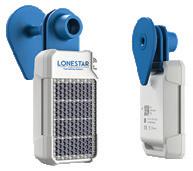





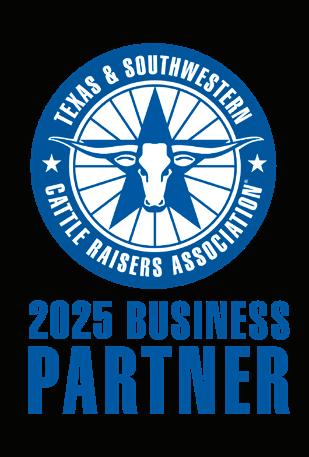



A
look into how genomic data informs progress in commercial herds.
By Jena McRell
If past is precedent, the beef cattle industry is entering another revolutionary chapter guided by technology, genetic progress and precision.
Andrew Conley, of GKB Cattle, says advancements made over the last two decades prove that the future holds extraordinary potential. From the rise of DNA testing and genomically enhanced EPDs in the seedstock sector to commercial genomic applications for cow-calf producers, the speed of genetic progress has never been faster.
“Keep yourself aware and at the edge of your seat, because I think the entire beef supply chain is headed for a new frontier,” says Conley, who manages the Brangus herd and the GKB Cattle Desdemona location.

With many years of first-hand experience using sophisticated breeding technology to make realworld improvements, he knows the right genetic pairing can make all the difference to a producer’s bottom line. DNA tests and genomic data provide powerful insight into both potential profitability and overall efficiency of the herd.
In a market where all classes of cattle are bringing record-high prices, he reminds producers to keep the productivity side of the equation in clear focus.
“We all, as an industry, need to be cognizant of that,” Conley says. “The end goal is to have the most efficient, most profitable cow. Not just a profitable one.”

The adoption of technology is not the only uncharted territory the beef business is facing. Texas A&M University Animal Science Professor Andy Herring says today’s record-high cattle prices are generating more income per animal, and those who invest returns into genetic improvements will be better poised for market shifts.
“Cattle prices are not going to stay this way, but they’re going to be pretty high for the next couple of years,” Herring says. “The more people understand about their animals and what they’re producing in their herd, they will be better positioned to manage and market those animals more precisely.”
Verifying parentage is among the most basic and beneficial use of genomic information in commercial cow-calf herds. Doing that alone, Herring says, can help producers identify more profitable animals and which bulls are working for their operation.
Studies conducted in crossbred cattle at Texas A&M AgriLife Research McGregor Station in Central Texas have shown a level of variability anywhere from three to 40 calves per bull at weaning. In today’s market, that is a huge swing in profit potential. In multi-sire herds, lower performers can be easily identified through DNA parentage tests.
On the maternal side, Herring says calves can sometimes be mixed up and there is no way to know the correct dam without testing them. “Sometimes cows are raising another cow’s calf, and you don’t ever know,” he says. “We assume that since a cow is nursing a calf that it is hers, but that’s not always the case, especially on those first-calf heifers.”
In addition to managing the existing cow herd, having access to enhanced genomic predictions helps shed light on decisions at weaning. Weighing the potential genetic outcomes for carcass quality, maternal traits and other economic indicators — along with available pasture resources and current market signals — allows for more informed and profitable decisions.
“If we are able to identify those cattle that are not going to meet that threshold earlier in their life, then that gives us the flexibility to make those cattle for a terminal cross or to eliminate those cattle from our herd altogether,” Conley says.
The added layer of DNA verification, whether on the next herd bull or calf crop, allows for more specialized decision making that’s unique to each rancher’s breeding strategy and goals. Conley says environmental considerations should top the list. For instance, a cowcalf producer developing replacement females in East Texas will have a different range of considerations than someone raising feeder steers in the Panhandle.

Commercial bull buyers have grown accustomed to poring over genomically enhanced EPDs on prospective sires. They have also seen the value of incorporating the same predictive power on their own calves, by charting an earlier course for potentialreplacement heifers, terminal animals or specialized marketing opportunities.
Andy Herring, Ph.D.
“DNA should help us identify cattle that will be more sustainable in a particular environment, and it depends on what the bull buyer is needing for his herd,” he says.
The ability to access genomically enhanced EPDs for key traits including birth weight, weaning weight, marbling, calving ease or heifer pregnancy, to name a few, adds a sophisticated layer of precision for cattle raisers when making breeding decisions.
“Being able to enhance those EPDs and have higher accuracies on unproven, non-parent animals takes the guesswork out of buying genetics and implementing them in your herd,” Conley says.

For cattle breeders getting started with DNA testing, Conley advises to first become familiar with the entire process — from collection to interpreting and applying genomic data within the herd.
He says this involves teamwork with everyone involved from the breed association to seedstock provider and the genomics company to the rancher. Most breed associations work with companies that provide specialized genomic tests for commercial herds, including options for maternal or terminal calves.
The most common way to collect DNA today is with an ear punch, Herring explains. These samples are collected with a tissue applicator that operates like an ear tag, capturing the tissue sample at the

same time a calf is tagged. The sample goes into a tube filled with fluid that can be stored at room temperature.
Depending on the test ordered, it takes about two to four weeks to receive results after submitting a sample. After that comes the task of fully evaluating the
information — traditional EPDs, GE-EPDs, pedigrees and specific indexes related to herd goals.
“The more information you have, the more potential you have to be more efficient,” Herring says. “The caveat with that is we can get information overload, and so we have to try to stay focused on what’s the most important thing for us.”
He encourages cattle raisers to consider these two questions: Which traits make you the most money? Which traits cost you the most money? “If you want to know the answers to both of these, genomic data will help you answer that,” he says.
When it comes to making individual herd management and breeding decisions, Herring stresses balance is key. Every breed experiences genetic variation, he says, and the same animal does not have the same value in different operations.
In the case of replacement heifers, for example, it is possible to breed in more milk-producing ability in cows than what the environment will support. In parts of West Texas or eastern New Mexico, the environment may not offer adequate feed resources for a high-milking cow to express her true genetic potential.
“If that’s true,” Herring says, “you’re not ever going to capture on that increased genetic value — and the increased genetic value may actually increase her maintenance cost for you.”
It is also important to note that genomic data relies on the time-tested practice of collecting measures and reporting performance information to breed associations. Herring cautions against the idea that DNA tests replace these traditional methods. Genomic information helps produce better animals, but it doesn’t fully replace what buyers are looking at when cattle enter the ring on sale day.
Even so, he says there can be increased marketing potential for specialized feeder calf or replacement female sales for animals backed with genomic profiles.
“We cannot forget about what our future buyers, whoever they are and whatever role they play, want from a desirable animal,” he says.
With customers across the country, Conley says GKB Cattle has seen the far-reaching benefit of genomic technology in both commercial and seedstock herds. The generational impact of more precise matings and management decisions is huge, he says, both for individual herds and the collective beef industry.
“If we can do this generationally with higher accuracy, in the long run — 10 to 20 years down the road — we will have built a cow base that is much more efficient,” he says.
As someone deeply rooted in day-to-day cattle management, Conley views efficiency as synonymous with sustainability. The more maintenance-free cattle are, the less management they are going to require because of the bred-in improvements for economically relevant traits.
“The more we can do with less, the more efficient and sustainable we are going to be,” Conley says.
The application of artificial intelligence, the next AI to greatly influence the beef cattle industry, is expected to start a new era of precision breeding. Conley says as accuracy and predictability of genomic information and tools continues to improve, there is great potential to incorporate AI into how data is collected and used.
“It is knocking at the door,” he says. “I see genomics and AI allowing the industry to evaluate efficiencies on a whole new perspective. Whether it be reproductive, feed intake or health efficiencies, once we can utilize DNA and enhance it with AI, we are going to have metrics that we’ve never seen.”
Even with greater advancements on the horizon, Herring reminds producers of the importance of fundamental practices around accurate recordkeeping, animal identification and capturing weights.
“We have more tools and capability now than I ever thought about, and yet, some things never go away,” Herring says. “We cannot lose sight of the whole picture.”
With today’s record-high beef demand and tight cattle supplies, leading to high-level prices back to cow-calf producers, Herring says to stay focused on herd goals, where the business would like to go, producing a quality product for consumers, and enjoying all the benefits this lifestyle brings along the way.
“Try to keep things in balance, and don’t be afraid of change,” he says. “We don’t all have to do the same thing, but we need to know what works for us and we need to do something that’s part of our business that’s fun. Otherwise, it’s hard to stay with it.”

FROM COW TO CALF, BUILT FOR THE LONG HAUL BORN TO THRIVE WHERE OTHERS JUST SURVIVE.
Brahman cattle have been proven in the world’s most challenging environments. From the Gulf Coast to the high tropics, they’re built to stay healthy, breed back, and raise calves year after year creating $
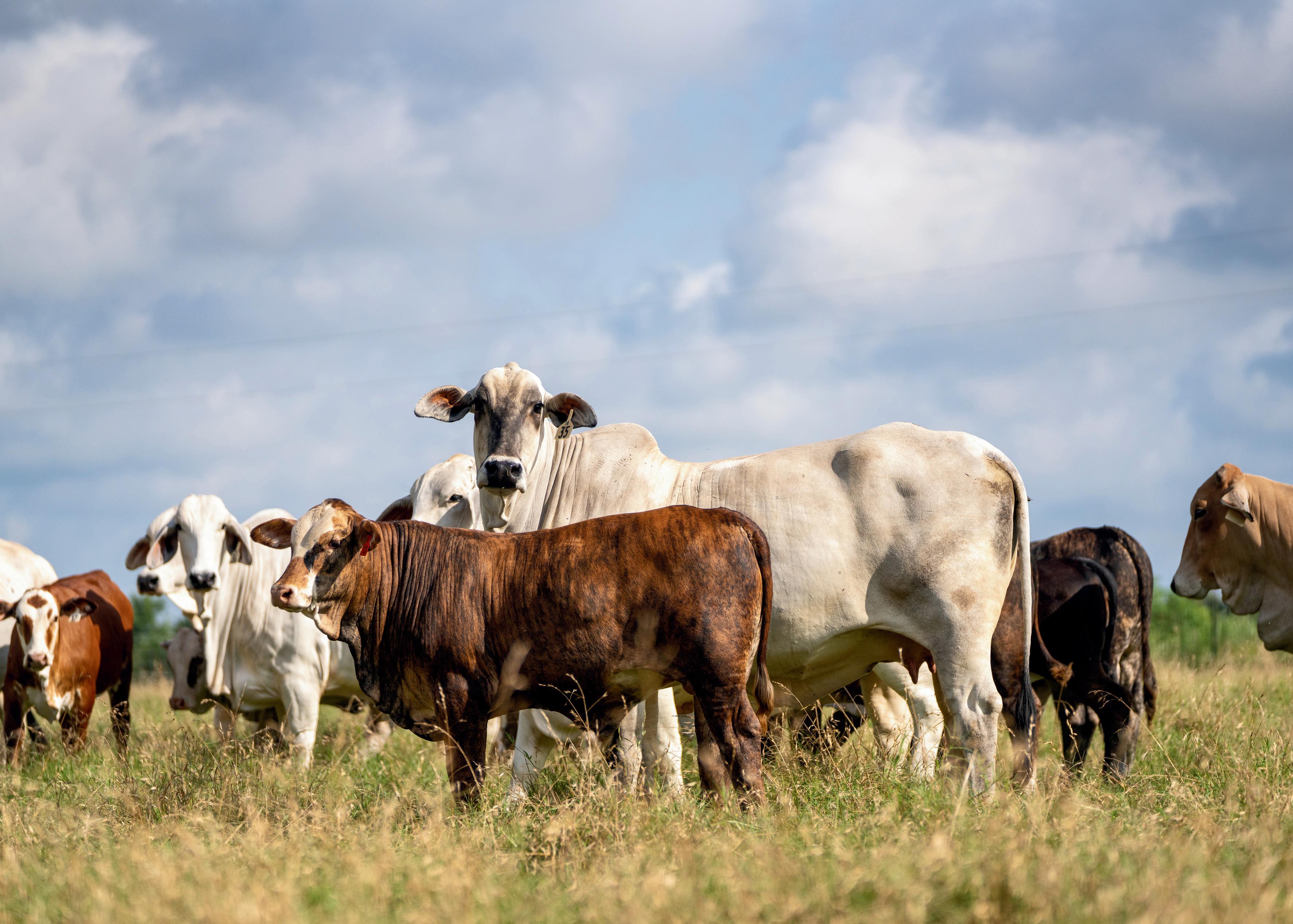



— Andrew Conley, GKB Cattle




When making bull buying decisions this fall, here are some common genomically enhanced EPDs lining sale books.
Growth and carcass-oriented GE-EPDs:
• Birth Weight (BW): Predicts calving ease; critical for heifers.
• Weaning Weight (WW): Indicates calf performance and market weight at weaning.
• Yearling Weight (YW): Measures post-weaning growth potential.
• Calving Ease Direct (CED): Especially important for commercial bull buyers who are breeding heifers.
• Carcass Weight (CW): Relates to finished animal profitability.
• Marbling (MARB): Strongly tied to beef quality and grid premiums.
• Ribeye Area (REA): Reflects muscling, often linked to yield grade.
• Fat Thickness (FAT): Tied to carcass composition and efficiency.
Maternal GE-EPDs:
• Calving Ease Maternal (CEM): Predicts daughters’ calving ease.
• Milk (M): Estimates maternal milk production — important but needs to fit environment.
• Heifer Pregnancy (HPG): Increasingly popular for replacement-focused buyers.
• Stayability (STAY): Used in some breeds to predict longevity of daughters.
Breed associations also offer indexes, or composite GE-EPDs, that balance multiple factors rather than individual traits. Go online or contact breed representatives to learn more. T C


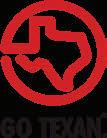
Lightweight - Strong Easy to Clean - Easy to Install Extends the Life of Your Trailer
PolyCleat Flooring weighs 2.8 lbs/ ft and is less than half the weight of rubber based flooring (7.4 lbs/ft) and also lighter than wood (4.9 lbs/ft).

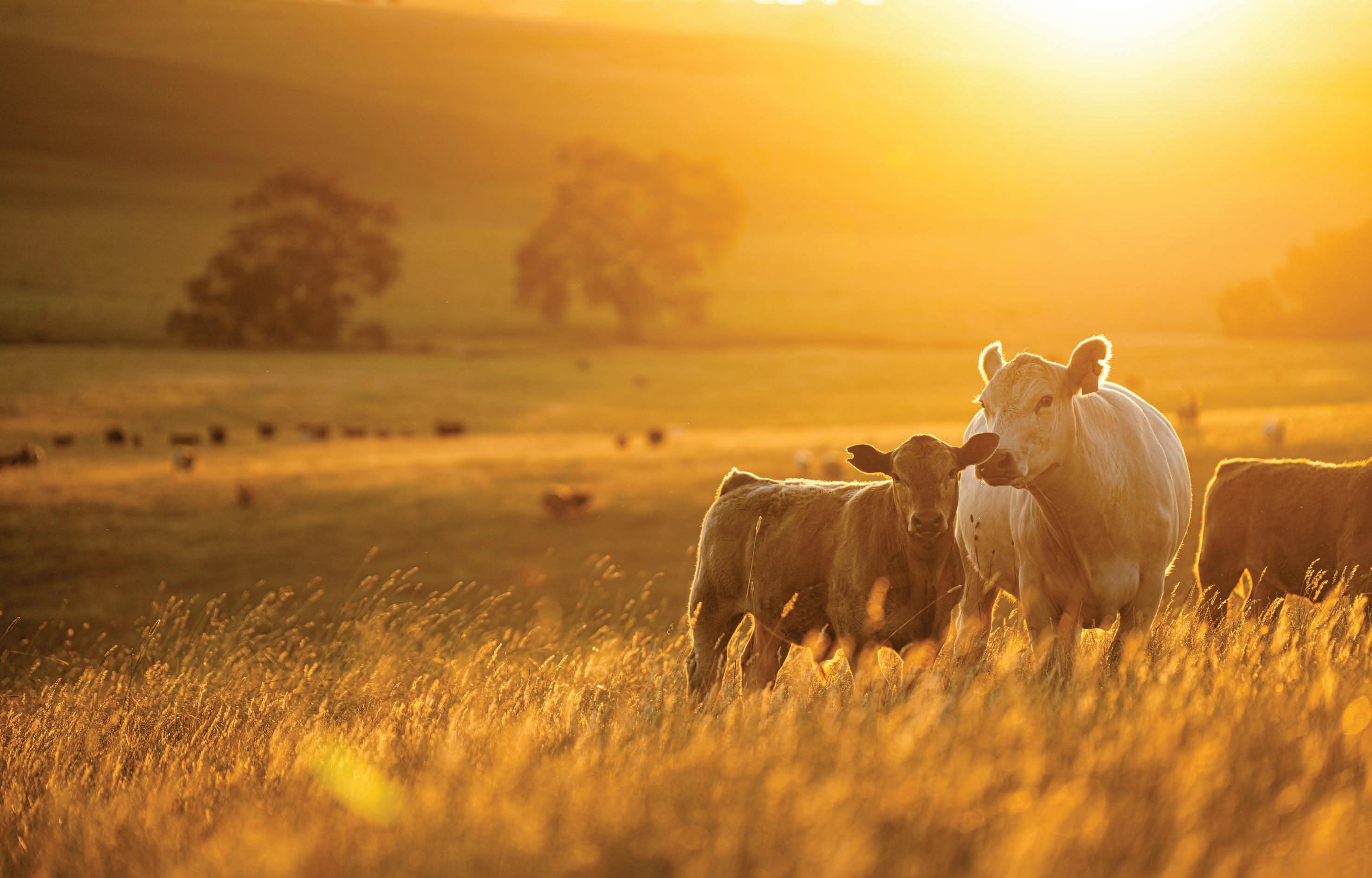


By James H. Dudley IV
American cattle raisers were recognized during negotiations for the One Big Beautiful Bill Act signed by President Donald Trump in July. Passage of the legislation includes provisions crucial to the longevity of our industry. Notably, it also excludes controversial measures like the sale of public lands or expanded eminent domain.
If you have done your own research on the bill, it’s possible there are some provisions you may not fully stand behind. However, the bulk of this legislation is beneficial to production agriculture and considered a win for the industry.
Before the bill was signed, the death tax exemption was set at $13.99 million per individual or $27.98 million per couple and set to expire Dec. 31. The new legislation permanently increases the death tax exemption to $15 million per individual or $30 million per couple, adjusted annually for inflation. The annual gift tax exclusion remains unchanged at $19,000 per giver per recipient.
This means beginning Jan. 1, if the value of your ranch plus equipment, cattle and other assets is less than $15 million individually or $30 million jointly, you will pay no death tax. In the past, this requirement has forced cattle raisers to sell off generational land, equipment or cattle to make the payment. Texas & Southwestern Cattle Raisers Association supports fully eliminating the death tax, but until then, this increased threshold is a victory.
The small business tax deduction, also known as a qualified business income deduction, is made permanent at 20% by this bill. Section 199A allows small businesses,
like ranches, to deduct 20% of business income, helping us save more of our hard-earned dollars.
The Immediate Expensing of New Business Assets, Section 179, allows small businesses to deduct the cost of equipment, rather than depreciate, on qualifying property. Thanks to the One Big Beautiful Bill Act, cattle raisers will now be able to deduct up to $2.5 million in qualified equipment expenses. The phaseout threshold for this deduction is increased to $4 million and these limits will be adjusted annually for inflation.
Bonus depreciation allows small business owners to deduct the cost of equipment in the year of purchase, rather than deduct depreciation over several years. Under this bill, 100% bonus depreciation is made permanent, beginning Jan. 19, for depreciable property like machinery.
In addition, disaster-related casualty loss was amended to permanently extend itemized deductions for personal casualty losses resulting from federally declared disasters such as fires, storms or theft. This is an extension of the Federal Disaster Tax Relief Act enacted December 2024.
The 2018 Farm Bill, officially known as the Agriculture Improvement Act of 2018, was extended through September as part of the American Relief Act of 2025. However, the One Big Beautiful Bill offered some farm bill provisions for cattle raisers ahead of the expiration.
The legislation increased to two monthly payments for the Livestock Forage Disaster Program and allows payments to start after four consecutive weeks of drought, rather than the previous eight consecutive weeks.
The bill also funds indemnity payments through the Livestock Indemnity Program at 100% of the market value for livestock losses due to predation and 75% of market value for losses due to adverse weather. Additionally, payments will be made for the loss of unborn livestock.
Funding for several voluntary conservation programs has also been secured for the next six years, including $18.5 billion for the Environmental Quality Incentives Program; $8.1 billion for the Conservation Stewardship Program; $4.1 billion for the Agricultural Conservation Easement Program; and $2.7 billion for the Regional Conservation Partnership Program.
The bill also increases annual funding for animal disease prevention and cattle health to $233 million per year. This funding goes toward the three-legged stool programs supported by Texas & Southwestern Cattle Raisers Association, including: $153 million per year for the National Animal Vaccine and Veterinary Countermeasures
Bank, which houses the foot-and-mouth disease vaccine and test kits; $70 million for the National Animal Health Laboratory Network; and $10 million per year for the National Animal Disease Preparedness and Response Program.
While no piece of legislation is perfect, the One Big Beautiful Bill represents a significant step forward for those of us in production agriculture.
These changes help preserve the legacy of ranching families and give us more tools to remain resilient in an ever-changing economic and environmental landscape. It’s important that we stay engaged, informed and unified as we continue advocating for policies that protect and strengthen our livelihoods. T C
James H. Dudley IV is an attorney and rancher based in Horseshoe Bay. He currently serves as chair of Texas & Southwestern Cattle Raisers Association’s property rights and tax committee.
Mike Johnson is the 56th Speaker of the U.S. House of Representatives and a Republican member of Congress serving Louisiana’s Fourth District. On Oct. 25, 2023, he was elected unanimously by his House Republican colleagues to serve as Speaker. Johnson was first elected to Congress on Dec. 10, 2016, and is currently serving his fifth term.
With two decades of experience in Constitutional law, Johnson served on the House Judiciary Committee, as chairman of its Subcommittee on the Constitution and Limited Government. He also served as a leader on the Select Committee on the Weaponization of the Federal Government, the House Natural Resources Committee and the House Armed Services Committee.

U.S. Rep.
Mike Johnson
that are foundational to America. A standout achievement in his tenure as Speaker was the successful passage of landmark legislation that provides critical support to family ranches, the One Big Beautiful Bill Act. By addressing rising input costs, unpredictable weather and volatile markets, the bill offers real, lasting solutions for cattle raisers facing mounting pressures. Thanks to his determined leadership, extensive preparation and negotiation, Speaker Johnson ensured the bill reached the president’s desk right on the Independence Day deadline.
He has dedicated his career to fighting for the fundamental freedoms and traditional values
Johnson earned his undergraduate degree in business administration from Louisiana State University in 1995 and his Juris Doctorate from the Paul M. Hebert Law Center at Louisiana State University in 1998. He and his family reside in Bossier Parish, Louisiana. T C

Hosted by Texas & Southwestern Cattle Raisers Association Leadership Development Foundation and presented by Texas Tech University, Cattle Raisers Roundup offers high school students a hands-on, gate-to-plate look at ranching and land stewardship through a curriculum-based experience. This year, 16 campers traveled to the Texas Panhandle for an impactful week of learning about the beef industry.
Texas & Southwestern Cattle Raisers Association Gilly Riojas Memorial Interns were also part of the program. From helping plan and coordinate travel to working on the ground and behind the scenes, interns had a front-row seat. In the following paragraphs, this year’s summer interns share standout moments from the 2025 Cattle Raisers Roundup.
“To say planning Cattle Raisers Roundup was a group effort is an understatement. As an intern helping with the process, I felt lucky to witness how each person’s personalities and strengths came together to make the event a success.
“Throughout the week, we planned industry tours like visiting West Texas A&M University’s meat lab, Bayer Crop Science, Livestock Nutrition Center, the FiberMax
Center for Discovery and Caviness Beef Packers. These visits allowed students to apply their prior education and classroom concepts to real-world operations across the cattle and agriculture industries. Touring meat labs and processing facilities provided a full-circle moment for students looking to pursue careers in agriculture, especially in the cattle industry.
“The experience of planning Cattle Raisers Roundup not only gave me more insight into event coordination, but also opened my eyes to the value of industry connections. More than 40 industry professionals poured into young minds through tours, sponsorships and educational programming.
“Talking with coordinators for the tour stops, like the Texas Tech University School of Veterinary Medicine, and hearing about the amazing hands-on opportunities they planned to provide the students, built such excitement for the week. We also planned some fun by scheduling a visit to the Texas play in Palo Duro Canyon, a favorite stop for campers.
“Watching our plans come to life was the ultimate reward. Seeing campers fully engaged, asking thoughtful questions and forming lasting connections reminded us why every detail mattered.”
—
Sarah Mullens, Flower Mound

Participants in the 2025 TSCRA Cattle Raisers Roundup are pictured, left to right, as follows.
Top row: Cotton Coleman, Clayton Diebel, Buddy Lansford and Jayce Lindsey. Second row: Wyatt Blase, Hudson Thigpen and Peyton White. Third row: Thomas Keller, Levi Coleman and James Colten. Fourth row: Cayle Canon, Kate Martin, Cadence Ellis and Emily Valicek. Front row: Avery Nelius and Micah Fisher.
“At Texas & Southwestern Cattle Raisers Association, everyone is dedicated to preparing the next generation of cattle raisers, no matter their backgrounds.
“Some Cattle Raisers Roundup participants grew up in urban centers, while others were raised in rural areas, small ranches or large family operations. There was one student, in particular, who mentioned her passion for agriculture but felt she was at a disadvantage in becoming a successful agriculturalist because her family stepped away from the industry.
“This is a common misconception among young people all over. I believe Cattle Raisers Roundup showed her that you do not have to grow up on a ranch to be successful in this industry. All you need is a spark to light the fire. Passion is contagious and these students inspired us as interns in so many ways.
“We also had a student who grew up on his family ranch and said that was all he knew. He expressed his discomfort when giving the required end-of-the-week speech, but he quickly lit up as he talked about his passions. He spoke about his personal experiences on his family’s operation and what he learned and planned to apply from Cattle Raisers Roundup at home.
“I knew I had witnessed a pivotal moment in this boy’s life. Not only did he gain confidence in his own voice, but he also learned the power of telling his own story.
“Overall, this experience showed me and my fellow interns the power of personal growth. As we came home and reflected on the week, we felt inspired.”
— Kara Tifft, Sulphur Springs
“What I witnessed at this year’s Cattle Raisers Roundup was more than a group of students visiting historic ranches and learning the ins and outs of the cattle industry, it was a glimpse into a promising, valuedriven future.
“What struck me most wasn’t only the students’ curiosity, but also their eagerness to connect with the places we visited, professionals they met and, most importantly, one another.
“On long bus rides, I would glimpse back to check in on the students and what I saw was amazing. Instead of burying their heads in their phones, they leaned into conversation, asking each other questions, trading stories and forming bonds that stretched beyond hometowns and fencelines.
“The energy didn’t die when the day’s agenda ended. Even after long hours in the heat, these students weren’t rushing to bed. They filled their nights with domino games, Tombstone watch parties, and
laughter by the pool. There was a spirit of shared joy and camaraderie that you don’t see often. More impressively, they supported one another by teaching roping tricks, explaining livestock terminology or helping someone feel at home in an unfamiliar environment. You could feel mutual respect growing by the hour.
“As part of the programming, campers were asked to share their experiences with our sponsors for thank you notes. They leaned into this opportunity. Campers asked for more thank you cards so they could personally acknowledge the people who had impacted them. That level of intentionality and grace doesn’t just happen; it is rooted in the kind of character this industry has long valued.
“Even at the end of a full day, returning late from the Texas play, the students weren’t asleep on the bus, they were singing and dancing to country classics and American anthems, a spontaneous celebration of who they are and what they’re becoming. That moment, watching them united, joyful and proud, felt like watching the next chapter of our industry unfold.
“This is the future of the American cattle raiser. And from what I saw, we’re in good hands.”
— Hunter Royer, New Richmond, Indiana
“At the beginning of Cattle Raisers Roundup, one student expressed he didn’t plan to return to his family’s ranch. He couldn’t see a future in it and, truthfully, he didn’t see a point in trying.
“But over the course of the week-long experience, something changed. He shook hands with industry leaders, toured operations that sparked new ideas and asked hard questions prompting real answers.
“He said the turning point came after the group visited with Joe Leathers at the 6666 Ranch. With everyone gathered around a table, Leathers shared two simple yet powerful words: ‘Dream big.’
“Something clicked for that young man. By the end of the week, he handed me a handwritten thank you note. As the interns reviewed the notes before mailing them, we came across his message to Leathers. He was dreaming big.
“He wrote that he was going back to his family’s ranch, to build it back up and make it stronger. After one morning spent at the 6666 Ranch, it seemed something inside him had been stirred. His passion for cattle, land and legacy had been reignited, and he was ready to take the first steps forward.
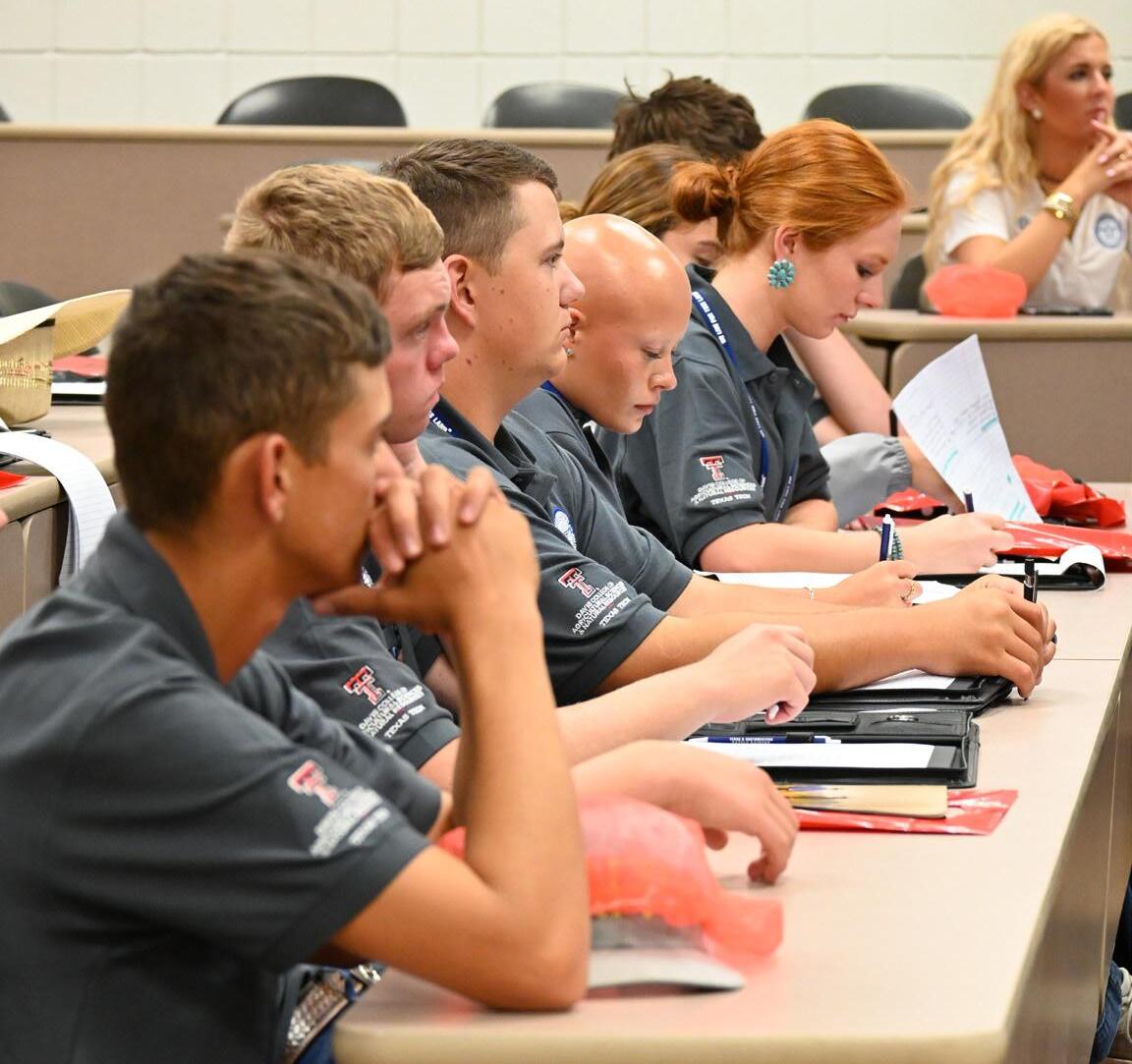

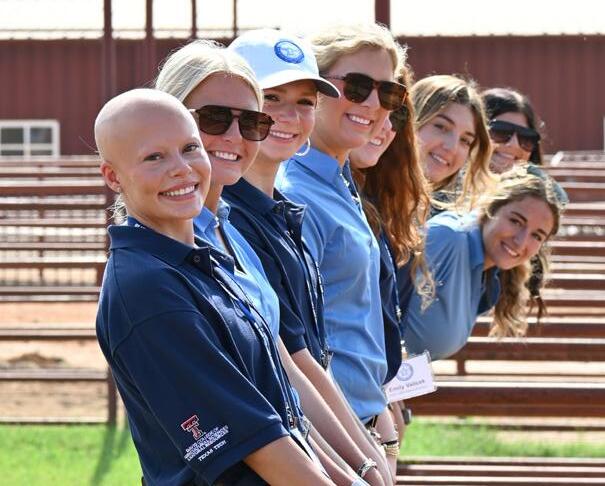

From the classroom to the ranch, Cattle Raisers Roundup attendees gain a boots-on-the-ground perspective of the beef supply chain — and their future place within it.
This year’s Cattle Raisers Roundup was made possible through the generous support of the presenting sponsor, the Texas Tech University System, including the Davis College of Agricultural Science and Natural Resources, National Ranching Heritage Center, and Texas Tech School of Veterinary Medicine. Additional sponsors — Big Bend Trailers, Capital Farm Credit, Livestock Nutrition Center, Mix 30, South Plains Implement and Trans Ova Genetics — also played a vital role in ensuring students had a first-class experience.
“That moment was a powerful reminder of why this work matters. It proved that a single connection and an honest conversation can shift someone’s perspective and potentially preserve a way of life for generations. That’s the purpose of Cattle Raisers Roundup, to ignite a spark, broaden students’ vision and equip them to carry on the legacy that sustains our world.”
—
Zoe Carmichael, Graham
“Cattle Raisers Roundup is designed to inspire young people, but it thrives because of an industry that shows up, invests in them and believes in what comes next.
“Before students stepped off the bus at each stop, there were ranchers reviewing schedules, professors prepping labs and professionals clearing their schedules to speak with the next generation of cattle raisers.
“At each stop, every industry professional not only shared valuable information, but also came with the intention of creating meaningful interaction. From West Texas A&M University’s Paul Engler College of Agriculture and Natural Sciences to Texas Tech University’s School of Veterinary Medicine, staff welcomed the group with enthusiasm and a passion to share their knowledge.
“Capital Farm Credit staff members sat down with students one-on-one to instill practical financial knowledge they can carry into the future. Capital Farm Credit’s financial education initiative, It’s Your Money Program, is designed to teach young people the basics of budgeting, credit and money management, helping them build a foundation for responsible financial decision-making.
“The professionals treated students not as kids passing through, but as the next generation of leaders worthy of investment. This reflects the importance of the people behind the day-to-day work of the agriculture industry.
“Cattle Raisers Roundup not only showcased the strength of our industry; it also highlighted those who will one day lead it. This generation isn’t waiting for students to ask for a seat at the table, but rather, pulling up chairs and engaging them with passion.
“Participants came with eagerness and left with a deeper understanding of the cattle industry and their place within it.”
—
Haley Bryand, Arp T C
Cattle Raisers Roundup is made possible through the TSCRA Leadership Development Foundation. More information on the 2026 event will be available in the spring.
Join or renew your membership today.
Member benefits include the support of TSCRA Special Rangers, government relations advocacy, educational programs, networking and social events, member-only discounts, The Cattleman magazine and phone app, and insurance services.

To learn more about membership, scan the code above or visit TSCRA.org.
Companies whose values and mission align with Texas & Southwestern Cattle Raisers Association are invited to join the organization and engage directly with our 28,000+ members. As a TSCRA Business Partner Member, your company will be part of a community that shares a commitment to advancing the cattle industry and its future.
to nine memberships
printed copy of The Cattleman
Exclusive sponsorship opportunities and discounts







to the TSCRA Business Partner logo

30% OFF at Cabela's and Bass Pro Shop
10% OFF CattleMax Software
15% OFF Ranchbot products John Deere Rewards upgrade
20% OFF at Boot Barn (in-store only) Ford X-Plan vehicle pricing


U.S. Secretary of Agriculture Brooke Rollins and Texas Gov. Greg Abbott together announced an investment of $850 million to combat the threat of New World screwworm, a pest that is endemic in Central and South America. The federal funding provides up to $750 million for a domestic sterile fly production facility at Moore Airfield Base in Edinburg, as well as additional research dollars. The new sterile fly production facility will have a capacity of 300 million flies per week.
Texas & Southwestern Cattle Raisers Association attended the mid-August announcement to show the association’s support and emphasize the importance of protecting U.S. agriculture.
“Texas & Southwestern Cattle Raisers Association cannot overstate the significance of funding a domestic sterile fly production facility,” said President Carl Ray Polk Jr. “Thank you to Secretary Rollins and the Trump administration for spearheading this effort, and thank you to Gov. Abbott and the Texas New World Screwworm Response Team for continually positioning Texas for success against the threat of NWS.”
Ranchers, landowners and agri-businesses across Texas and the Southwest now have access to a first-of-itskind partnership between Cattle Raisers Insurance and
Higginbotham Insurance and Financial Services, offering a single-source insurance solution for ranch, property and liability coverage, as well as health benefits for employees and families.
Through this expansion, Cattle Raisers Insurance moves beyond its traditional service areas of Texas, Oklahoma and New Mexico and can now write policies nationwide. Customers gain access to a full suite of commercial, personal and employee benefit solutions delivered in partnership with Higginbotham, the largest independent insurance firm in Texas. Both companies remain independent providers.
As part of the expanded services, Cattle Raisers Insurance policyholders will gain access to Higginbotham’s Employee Response Center, where specialists help individuals navigate carriers, understand their health plans and locate in-network providers. Policyholders will also benefit from annual risk reviews and educational resources designed to support ranching operations beyond policy placement.
This announcement builds on the partnership launched earlier this year, which included exclusive member discounts for Texas & Southwestern Cattle Raisers Association. Qualified members currently receive a 10% discount on Travelers property insurance, with additional discounts expected soon.
Texas & Southwestern Cattle Raisers Association Sept. 2 announced the appointment of Clay McKinney as executive director of law enforcement, brand and inspection services. McKinney has been serving in this role on an interim basis since earlier this year.
In his position, McKinney oversees daily operations for the association’s special rangers and brand inspectors across Texas and Oklahoma.
Texas & Southwestern Cattle Raisers Association Special Rangers are law enforcement officers commissioned through the Texas Department of Public Safety or the Oklahoma State Bureau of Investigation who specialize in investigating livestock theft and agricultural crimes.
The department also manages market inspectors who document brands and other identifying marks on millions of cattle sold annually at nearly 100 Texas livestock markets.
McKinney has served Texas & Southwestern Cattle Raisers Association as a special ranger for District 18 since 2018, covering the Trans-Pecos region of Texas.
Before joining the association, he served as an investigator for the 143rd District Attorney’s Office, a narcotics investigator for the Reeves County Sheriff’s Office, and spent more than 20 years as chief of police for the Pecos Police Department.
Five interns joined the Texas & Southwestern Cattle Raisers Association team Aug. 19 for a fall internship experience. Sam Coleman, Sydney Lofland, Grant Mastin and Sierra Williams are based in the Fort Worth office and work across all departments. Jose Diego Chapa continues in his role as the policyfocused intern in Austin.
Coleman is a sophomore at Texas Christian University’s Neeley School of Business, majoring in finance with interests in real estate and ranching. A fourth-generation Texan from a Beefmaster breeding family, Coleman grew up working on the ranch, handling cattle care, land management and conservation projects. He has assisted with operations for a residential investment property through Hypnotoad Properties LLC, gaining experience in real estate, asset stewardship and ranching.
Lofland is a recent graduate of Stephen F. Austin State University, earning a master’s degree in agriculture and a bachelor’s degree in animal science. Originally from Fort Worth, she has a strong passion for the beef cattle industry and is dedicated to advocating for its future by educating the next generation. Her graduate research is focused on using silvopasture systems to mitigate heat stress in beef cattle.
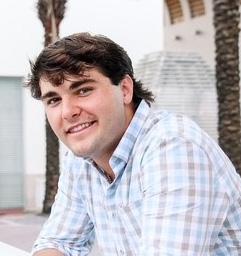

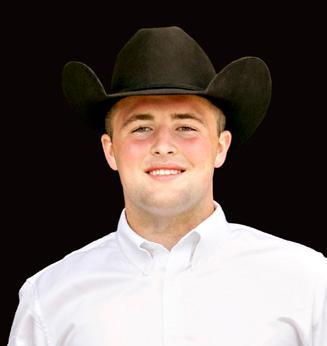

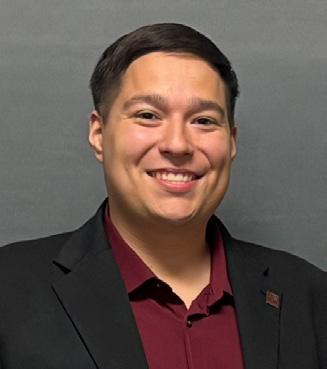
Mastin is a senior at Texas Christian University, pursuing a dual degree in finance and political science through the Neeley Fellows Honors Program. Raised in rural southeastern Ohio, he is passionate about policies that support agriculture and rural communities. He has interned for U.S. Sen. Ted Cruz and the Ohio House of Representatives. After graduation, Mastin plans to attend law school. He also interned with Texas & Southwestern Cattle Raisers Association last fall.
Williams is a recent graduate of Prairie View A&M University with a bachelor’s degree in agriculture, specializing in animal and food science. She has a deep passion for agriculture and a strong interest in agricultural policy. Her goal is to bridge the gap between science and
policy to promote sustainable practices and support rural and underserved communities. Williams is excited to gain hands-on experience and contribute to meaningful agricultural work with the association.
Chapa is a recent graduate of Texas A&M University, where he received his bachelor’s degree in agricultural economics. He has experience in the international produce trade sector with Owyhee Produce and served as a Texas & Southwestern Cattle Raisers Association government relations intern during the 89th Texas Legislative Session.
The Texas & Southwestern Cattle Raisers Association Leadership Development Foundation, a 501(c)(3) organization dedicated to fostering the next generation of land and livestock stewards and leaders, has opened applications for the TSCRA Leadership Development Foundation Working Grant Program.
The initiative provides financial capital to business owners with a vested interest in the beef value chain. Entrepreneurs in Texas and Oklahoma are encouraged to apply. The online application is open Nov. 1 to Dec. 31, with grantees expected to be announced by February.
In September, Texas & Southwestern Cattle Raisers Association announced a new partnership with Prime Metal Buildings & Components, giving its members exclusive savings with one of the nation’s leading steel building companies.
Through the partnership, association members will receive a 5% discount on all of Prime Metal Buildings & Components’ full range of metal building products including wall and roofing panels, trim, red iron, kit buildings, and accessories. The discount is available at all six of Prime’s Texas retail branches (Dublin, Dumas, Bridgeport, Kerrville, Amarillo and Weatherford), where teams provide design consultations and full-service construction support.
Prime Metal Buildings & Components is a Texas born, family owned and operated company that has become a national leader in commercial, residential, agricultural, aviation and equestrian building solutions. The company operates a structural steel fabrication shop, purlin shop, and a complete pre-engineered metal building design department, delivering custom project solutions.
Current Texas & Southwestern Cattle Raisers Association members in good standing can claim their 5% discount by presenting their membership card or number for verification when working with Prime Metal Buildings & Components. The discount may not be combined with other offers. T C
The Ranching Heritage Association will honor two working cowboys with this year’s annual RHA Working Cowboy Award. The eastern division recipient is Tom Moorhouse, of Benjamin. The western division recipient is Jeff Bilberry, of Kenna, New Mexico.
The RHA Working Cowboy Awards will be presented during the annual National Golden Spur Award Honors Oct. 4 at the Lubbock Memorial Civic Center.
“The RHA Working Cowboy Award is designed to recognize outstanding individuals who make their living primarily on horseback, caring for livestock on a daily basis,” said Jim Bret Campbell, executive director of the Ranching Heritage Association and the National Ranching Heritage Center.
The awards, which honor working cowboys skilled in all aspects of ranch work and who are respected by the ranch crew and ranching community, are presented annually by six of the nation’s leading ranching and livestock organizations: American Quarter Horse Association; National Cattlemen’s Beef Association; Ranching Heritage Association; Texas Cattle Feeders Association; Texas Farm Bureau; and Texas & Southwestern Cattle Raisers Association.
Honored as the eastern division recipient, Tom Moorhouse, a fifth-generation rancher and cowboy, has dedicated his life to the land and livestock of West Texas.
His longstanding commitment to stewardship, horsemanship and traditional cowboy values makes him a fitting recipient of this prestigious award. Moorhouse’s career spans decades of work on historic ranches, including the famed Moorhouse Ranch, where he has played an instrumental role in preserving ranching practices that have shaped the region’s cultural and economic legacy.
“Because of Tom’s dedication and skill in his trade, he has unintentionally done more than almost anyone to preserve the ‘working cowboy’ way of life,” said John Welch, vice president of the Ranching Heritage Association and retired CEO of Spade Ranches. “He was pure cowboy when ‘cowboy’ wasn’t cool. Who has done more to preserve the working cowboy way of life than Tom Moorhouse just by living it?”
From a young age, Moorhouse was immersed in the cowboy lifestyle, developing exceptional skills in horsemanship and cattle management. His dedication to the craft led him to work on several prominent Texas ranches, including the Tongue River Ranch and the 6666 Ranch. Moorhouse’s expertise in training and handling horses has earned him numerous accolades, notably being named All-Around Cowboy twice at the Texas Ranch Roundup in Wichita Falls. In 2005, Moorhouse was inducted into the Texas Cowboy Hall of Fame, a testament to his significant contributions to the ranching industry. He is a current honorary director for Texas & Southwestern Cattle Raisers Association.
Moorhouse has played a pivotal role in preserving and advancing ranching practices. Alongside his family, he continues to operate the Moorhouse Ranch Company, maintaining cow-calf, farming and stocker operations across West and Central Texas. His dedication to the land and livestock, coupled with his willingness to embrace progressive techniques, his status as a respected leader in the ranching community.

Tom Moorhouse, a fifth-generation rancher and cowboy, is the recipient of the 2025 RHA Working Cowboy Award, representing the eastern division. Photo by Ross Hecox.
Jeff Bilberry, a lifelong cowboy and respected leader in the ranching industry, will receive the prestigious RHA Working Cowboy Award, representing the western division. A fourth-generation rancher whose legacy runs as deep as the roots of the land he stewards, Bilberry exemplifies the time-honored values of integrity, service and a life spent horseback.
For more than 30 years, Bilberry has served as the general manager of the Bojax, Augua Verde and Lobo divisions of Singleton Ranches, one of the largest ranching operations in the nation, encompassing more than one million acres across New Mexico and California. Additionally, for the past eight years he has overseen three of the ranches in California. As vice president of Singleton Ranches, he continues to work cattle from the saddle, sharing his experience with young cowboys and leading by example in every corner of the outfit.
“Although Jeff’s current responsibilities include ranch management, he still saddles up more often than not and continues to doctor cows, brand calves and do anything necessary to ride for the brand,” said Pat Boone, a New Mexico rancher.
For more than half a century, TCU’s renowned Ranch Management program has given students an edge in agricultural resource success. This unique nine-month intensive program equips graduates with real-world strategies as producers and land stewards in changing times.
Space is limited. Visit ranch.tcu.edu or call 817-257-7145.

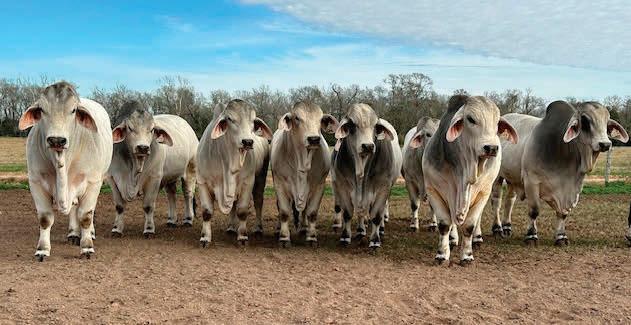
Thick muscled, good bone, with eye appeal and light birth weights.
Give us a call for all your Brahman needs. We invite you to drop by the ranch and inspect these bulls at any time.


Bilberry’s commitment to the ranching lifestyle is matched only by his dedication to community and faith. He has served as a Chaves County Commissioner, Elida School Board president, and held leadership roles with the New Mexico Cattle Growers Association and the New Mexico Agriculture Board.
Born into a family whose cowboy roots stretch back to an 1881 cattle drive to the legendary LFD Ranch, Bilberry carries that legacy with pride, perseverance and humility. With his wife, Cheree, at his side, the Bilberries and their children continue the family tradition. He is living proof that the cowboy way of life is alive and well.


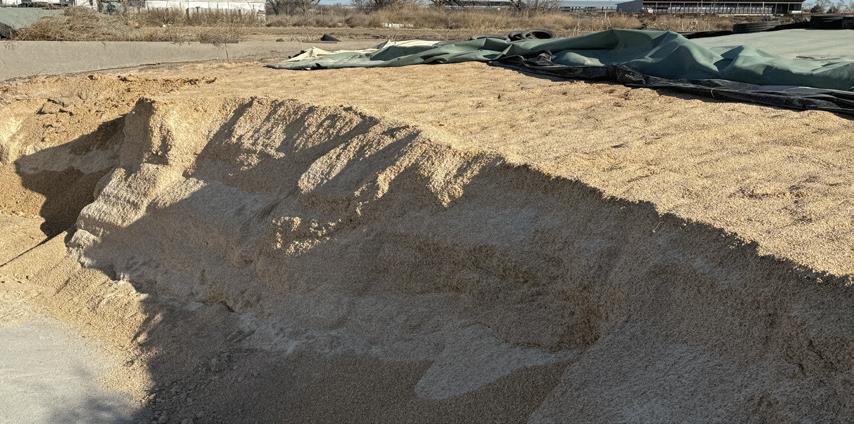
U.S. beef export volume in June was the lowest in five years, due in part to China’s failure to renew registrations for most U.S. plants. That’s according to data released by USDA and compiled by U.S. Meat Export Federation.
Beef exports totaled 93,928 metric tons in June, down 15% from a year ago and the lowest since June 2020. Export value was $769 million, down 18% and the lowest in 17 months. Shipments to Korea and Mexico were steady with year-ago levels, while exports increased sharply to Central and South America, and variety meat demand strengthened in Egypt and in several emerging markets in Africa. But these gains did not fully offset the steep decline in exports to China and lower shipments to Japan.
For January through June, beef exports were 6.5% below last year’s pace at 602,221 metric tons, while value fell 6% to $4.92 billion.
Lack of access to China not only results directly in lost business and missed opportunities, but the U.S. beef industry is also losing the premiums generated when Chinese buyers compete for cuts that are especially popular throughout Asia, such as short plate, top blade, chuck rolls and short ribs. Without exports to China, U.S. Meat Export Federation estimates the U.S. beef industry’s lost opportunity at $150 to $165 per head of fed slaughter, or about $4 billion annually.
“The June export results really underscore the urgent need to resolve this impasse with China,” said U.S. Meat Export Federation President and CEO Dan Halstrom. “China’s tariff rate on U.S. beef is currently 32%, which is too high, but not insurmountable. The problem is, with only a few plants eligible to ship to China, the tariff rate becomes irrelevant. Consistent and transparent plant approvals, without expiration, were among the most important components of the 2020 Phase One Agreement with China, and it’s time for China to return to those commitments.”
At time of press, the federation reported that it remains hopeful access to China will be restored soon, but the situation highlights the importance of diversification and further development of emerging markets such as Central America and Southeast Asia. T C




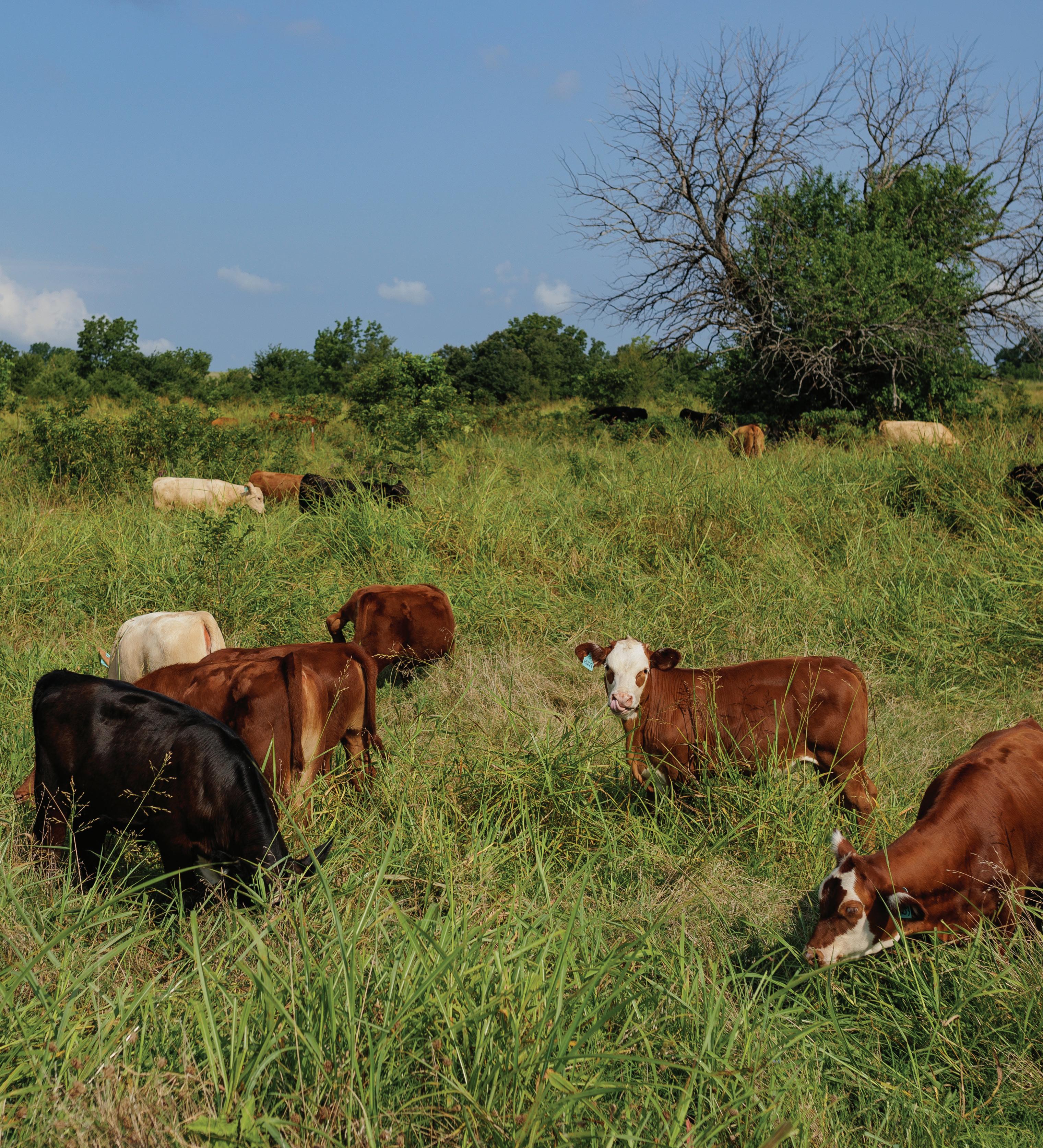

Upcoming Ranching 101 covers how to detect and treat common illnesses.
Join Texas & Southwestern Cattle Raisers Association for the next Ranching 101 webinar at 1 p.m., Tuesday, Oct. 21. The hourlong Zoom session will explore how to protect herd health, reduce losses and safeguard long-term profitability.
Recognizing and responding early to disease is one of the most important skills a cattle raiser can develop. Illness can quickly impact growth, reproduction and overall herd performance, but timely detection and proper management can prevent major setbacks.
Whether the goal is to limit the spread of contagious diseases, improve treatment success or strengthen the herd’s immune defenses, understanding the signs of illness and implementing effective health protocols is essential for protecting cattle and the bottom line.
Ranching 101 webinars provide participants with practical, sound guidance on the tools and equipment needed to get started in ranching or land ownership. The webinars are available online on the third Tuesday of every month.
Registration is complimentary for any association member. Visit tscra.org to learn more. T C








MINNIE LOU BRADLEY, 93, of Childress, died Aug. 5.
Born in Hinton, Oklahoma, she was the first female student in the animal husbandry program at Oklahoma A&M College. She was also the first female member of the livestock judging team and was named High Individual at the International Livestock Judging Contest during the 1952 International Fat Stock Show in Chicago. She graduated in 1953 with a degree in animal husbandry and a minor in agriculture journalism.
Bradley began her career with Texas Angus Association until she married Billy Jack Bradley on March 5, 1955. They moved immediately to the recently purchased ranch in Childress County that became known as Bradley 3 Ranch in 1955.
Bradley was the first female elected to the American Angus Association board of directors in 1998 and is still the only female to have served as their president and chair of the board in 2005.
She was inducted as a member of the National Cowgirl Hall of Fame in 2006 and the National Saddle & Sirloin Portrait Gallery in 2014.
She is survived by her husband, Bill; daughter, Mary Lou Bradley-Henderson, a Texas & Southwestern Cattle Raisers Association honorary director, and her husband, James Henderson, an association director; grandson, Raymond Jack Bradley; granddaughter, Mandy Ann Popejoy; brother, Ted Ottinger; sister, Linda Pike; five great-grandchildren, a niece and three nephews, along with countless friends across the nation.
BLACKWELL DURHAM, 62, of Henrietta, died Aug. 2.
Before settling in Henrietta, Durham lived in Hammond, Louisiana, and Kilgore. While in Kilgore, he owned Durham Chevrolet from 1986 to 2006. He later started a business selling horse trailers called Durham Trailer Ranch.
In 1997, he met Heidi Trey while selling her a vehicle, much to the surprise of his salespeople since they had not seen him negotiate a vehicle sale in years. Later,
during the test drive, he found the courage to ask her out. They married on March 31, 2007.
After moving to Henrietta, Durham started his dream job of ranching. He also bought an oil field cement business called Oilfield Partners.
He was a member of Texas & Southwestern Cattle Raisers Association, Ducks Unlimited, National Rifle Association, Rocky Mountain Elk Foundation and U.S. Team Roping Association.
He is survived by his wife; children, Ella Durham, Richard (Danielle) Durham and Brittany (Jay) Senn; three grandchildren, Stella Durham, Addison and Declan Senn; mother, Eleanor Flippen; stepmother, Mercedes Harvey; mother and father-in-law, Doug and Melody Hartz; five siblings; two sisters-in-law; and several nieces and nephews.
JOHN W. GALLOWAY SR., 85, of Beeville, died July 21.
A lifelong resident of Beeville, his roots run deep in Bee County with his Galloway ancestors having settled in Skidmore in 1882 after their journey to America from Scotland. His grandfather founded the Galloway Mortuary in 1919, and since 1974, he managed Galloway & Sons Funeral Home with dedication and compassion.
From an early age, Galloway was deeply involved in community affairs, starting with his times at A.C. Jones High School. He served as mayor of Beeville from 1970 to 1980, and in 1972, he developed the Western Week organization serving as its president for three years. He was appointed by Governors Perry and Abbott to serve on the Nueces River Authority.
Galloway established Bids for Kids to raise funds to purchase FFA and 4-H exhibitors’ projects. He also awarded champion belt buckles at the Bee County Junior Livestock Show and the Live Oak County Fair for more than 50 years.
He is survived by his wife of 63 years, Elizabeth Ann; his sons, John Wilbur (Terri) Galloway Jr. and Charles Andrew (Nicole) Galloway; his daughter, Mary Beth (Steve) Atzenhoffer; his grandchildren, JW Galloway III, Maggie Galloway, Hanna (Matt) Galloway-Hillestad, Chase Galloway, Jake Galloway, Julia (Donald) Mobley and Jane Hunt; two great-grandchildren; two cousins; and several nieces and nephews. T C
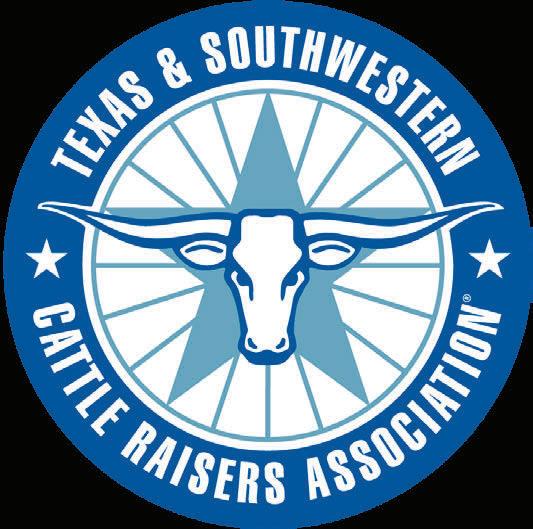
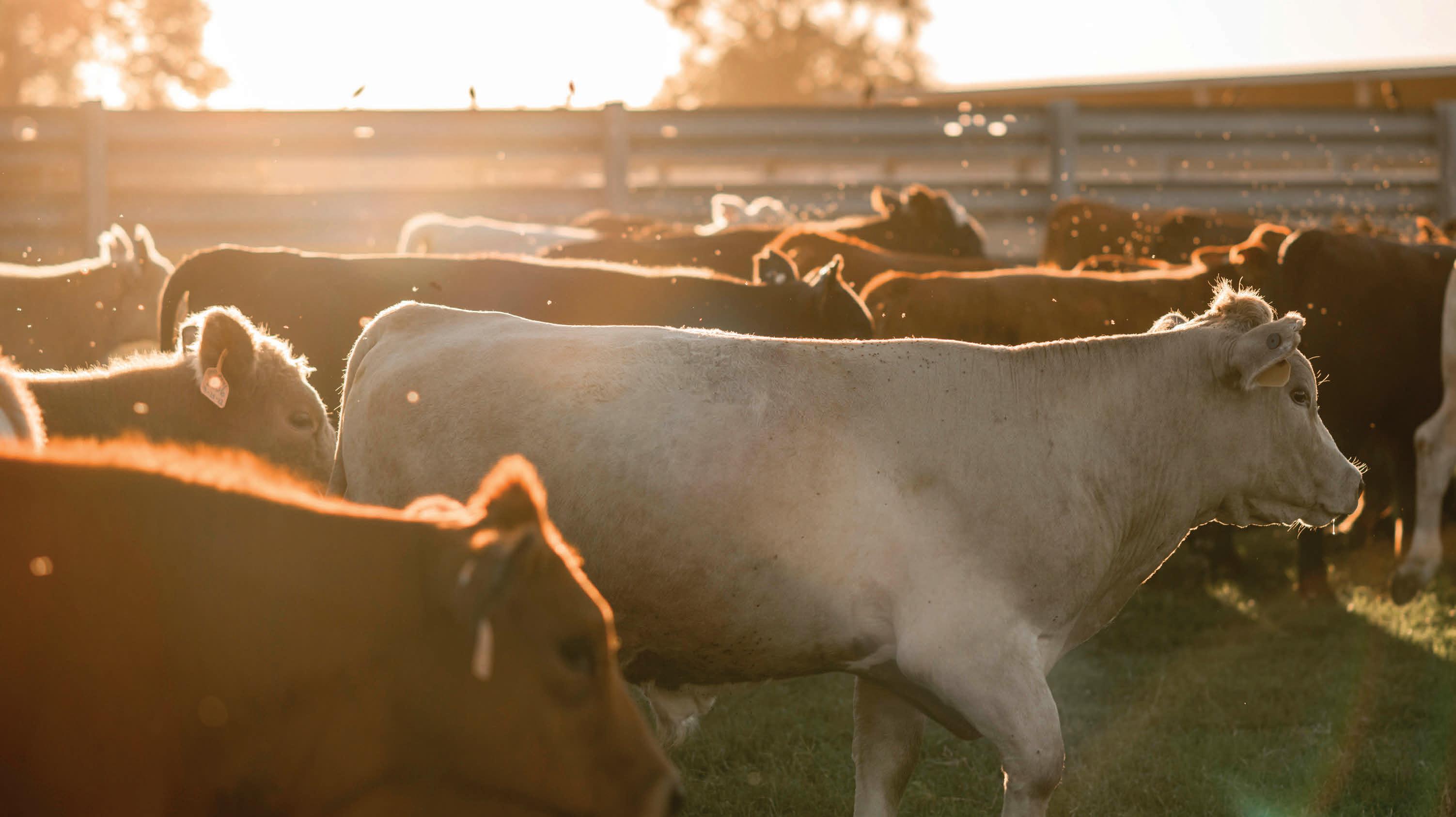

Protect your herd from the threat of New World screwworm. Learn identification, prevention and response strategies from veterinarians, producers and industry experts, and hear the latest updates from leading agencies.
This event is free to attend, and lunch will be provided. To ensure there’s plenty of food for everyone, please be sure to register.
Producers Cooperative Main Location 1800 North Texas Avenue, Bryan, TX 77803 Thursday, October 2 6 - 8 PM
For more information or to register, email education@tscra.org or call 800-242-7820. Scan to Register
Four Texas livestock sale barns were returned $93,500 following an investigation for hot checks led by Texas & Southwestern Cattle Raisers Association Special Ranger Kenny Murchison.
On Aug. 17, Murchison was notified by a sale barn that a $36,000 check was returned for insufficient funds. Through his investigation, Murchison discovered another sale barn had also been targeted, with a $29,000 check from the same individual returned for insufficient funds.
Murchison initiated an investigation and learned some of the cattle from these transactions were possibly on a
property in the Travis County Manor area. Upon locating the property, Murchison spoke to individuals who led him to the location of seven head of cattle that had been purchased from these two sale barns.
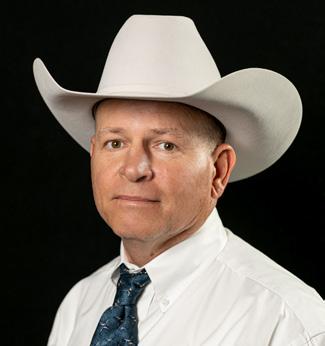
While there, Murchison also learned 35 head of cattle had been shipped to an area auction to be sold. He contacted the auction barn and discovered they, too, had recently received a $10,000 check from the same individual, which was returned due to insufficient funds.
During further conversations, Murchison learned the individual also purchased cattle at a fourth Central Texas auction and paid with a $18,500 check that was returned.
In total, $93,500 in unpaid receipts were identified.
Seven head of cattle were seized in Travis County, and a hold was placed on the 35 head of cattle at the third sale barn. Murchison then contacted the individual associated with the unpaid accounts, who assured him the barns would be paid in full within 24 hours.
By Aug. 18, all sale barns confirmed they had received full payments, and all associated livestock were released.



Cactus Feedyard
Matthew Turney, Manager
Cactus, TX
office: (806) 966-5151 cell: (806) 282-7077
Centerfire Feedyard
Adam Gerrond, Manager
Ulysses, KS office: (620) 356-2010 cell: (806) 390-9034
When Our Folks Drive Through the Gate They Think and Act Like Owners Because They Are Owners - They Have a Vested Interest in the Cattle They Care For
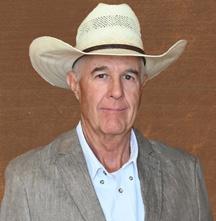


Frontier Feedyard
Jon Vanwey, Manager Spearman, TX office: (806) 882-4251 cell: (719) 251-2381
Stratford Feedyard
Pistol Audrain, Manager Stratford, TX office: (806) 396-5501 cell: (806) 753-7133

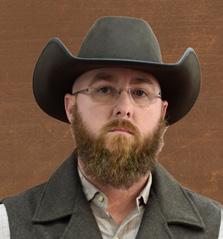

Southwest Feedyard
Kacey Graham, Manager Hereford, TX office: (806) 364-0693 cell: (806) 316-8799
Hale Center Feedyard
Rusty Jackson, Manager
Hale Center, TX
office: (806) 879-2104 cell: (806) 773-9457
Ulysses Feedyard
Adam Gerrond, Manager Ulysses, KS office: (620) 356-1750 cell: (806) 390-9034
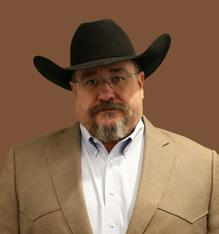



Wolf Creek Feedyard
Keith Brinson, Manager Perryton, TX office: (806) 435-5697
cell: (806) 282-7588
Wrangler Feedyard
Randy Shields, Manager Tulia, TX
office: (806) 583-2131 cell: (806) 290-0559
Syracuse Feedyard
Phil Moreman, Manager
Syracuse, KS
office:

(806) 371-4715


Red Beefmaster bull missing in Red River County. Texas & Southwestern Cattle Raisers Association Special Ranger Bo Fox reports a registered red Beefmaster bull missing from a property off County Road 1245 in Detroit. The 2.5-year-old bull is branded with “lazy S” on his left side and “3622” on his left hip. The bull was last seen in May and discovered missing July 26. Anyone with information on this case is urged to contact Fox at 903-348-9638.
Reward offered for information on stolen tractor in Rusk County.
Texas & Southwestern Cattle Raisers Association Special Ranger Larry Hand reports a stolen 2009 green John Deere 6115D tractor with a cab, front-end loader and bucket stolen from a property off FM Road 225, north of the Laneville community in Rusk County. The tractor’s VIN is No. P06115D001550. The model 563 frontend loader’s VIN is No. W00563D003193. The tractor was discovered stolen July 25.
The owner is offering a $4,000 reward for information leading to the return of the stolen tractor or the arrest and/or grand jury indictment of the person(s) responsible for the felony theft of this tractor. Texas & Southwestern Cattle Raisers Association Special Rangers are working to support the Rusk County Sheriff’s Office and the East Texas Auto Theft Task Force in this case.
Reward offered for information on stolen tractor in Rusk County.
Hand also reports a stolen 2013 green John Deere 5100E tractor with a tinted cab, front-end loader and bucket stolen from a property off FM Road 225, north of the Laneville community in Rusk County. The tractor’s VIN is No. 1LV5100EEDY140025. The model 540M front-end loader’s VIN is No. 1P0540MXCJD049630. The tractor was discovered stolen July 25.
The owner is offering a $4,000 reward for information leading to the return of the stolen tractor or the arrest and/or grand jury indictment of the person(s) responsible for the felony theft of this tractor. Texas & Southwestern Cattle Raisers Association Special Rangers are working to support the Rusk County Sheriff’s Office and the East
Texas Auto Theft Task Force in this case. Anyone with information on these cases is urged to contact Hand at 903-571-3488.
Two mares missing in DeWitt County.
Texas & Southwestern Cattle Raisers Association Special Ranger Robert Fields reports two mares missing from a property off FM 1447 in Cuero. The missing horses are described as a 21-year-old red dun mare with a white stripe on its face, and a 4-year-old bay mare with black points and a small white star on its forehead. The red dun mare is branded on the left thigh with the Rancho El Ojival Ranch brand, shaped like a clover with 90-degree angles between the rounded points. On July 23, the suspect(s) cut the property fence to steal the horses. Anyone with information on this case is urged to contact Fields at 361-207-5207.
Angus cow-calf pairs missing in Mason County.
Texas & Southwestern Cattle Raisers Association Special Ranger Todd Jennings reports nine black Angus cow-calf pairs missing from a property off U.S. 377. The cows are branded with a “lazy connected JD” on their left hip and a yellow ear tag in their right ear. The calves have a halfcrop and a half-swallow fork notch in their right ear. They were last seen July 4.
Angus bull calves missing in McCulloch County.
Jennings also reports 18 black Angus bull calves missing from a property west of Brady off County Road 106. The calves are nine to 11 months old and weigh 700-800 pounds. The cattle have the following ear tag numbers in their left ear: 1W, 127, 128, 131, 136, 605, 611, 622, 624, 631, 635, 641, 644, 651, 676, 688, 704 and 755. They have an under-bit notch and a fly tag in their right ear. They were last seen July 3. Anyone with information about these cases is urged to contact Jennings at 830-997-7585. T C
TSCRA offers a cash reward for information leading to the arrest and/or grand jury indictment of individuals for theft of livestock or related property. Anonymity is guaranteed. To provide information, call the Operation Cow Thief tip line at 817-916-1775.













Special Replacement Female Sales
*Wednesday,October15,2025
@10:00a.m.–SanSaba 11thAnnualHillCountryYouthHeiferSale
Fall “Best of the Best” Replacement Female Sale
Saturday,October25,2025
@10:00a.m.–SanSaba
Offeringqualitypair,bredcows,bredheifers, andopenorexposedheifers.Don’tmiss youropportunitytobuysomeofthe bestfemalesinthecountry! Thesellerandbuyerofthetop-sellingfemales ineachoftheclasseswillreceiveatrophy.All cattlewillbefiveyearsofageoryounger!
Saturday,December6,2025@ 10:00a.m.–SanSaba ConsignmentsWelcome!
Special Bull Offerings
Inconjunctionwithourregularsale. Bullswill sellat10a.m. Bullswillbefertilitytested,meet trichrequirements,andreadytogotowork.
Thursday,October9,2025
@10:00a.m.–SanSaba FeaturingDybdalCharolaisBulls BooksareClosed!
Thursday,November6,2025
@10:00a.m.–SanSaba HalesAngusFarms&CannonCharolais–30Angus&30CharolaisBulls
*Wednesday,November12,2025
@11:00a.m.–SanSaba BarberHerefordRanchandExpress RanchAngusBulls
Thursday,November20,2025
@10:00a.m.–SanSaba FeaturingSchaeferFarmsAngus&ShadyOaks FarmCharolais&SimAngusBulls
Thursday,December18,2025
@10:00a.m.–SanSaba Leachman’sTexasFallStabilizer BullSale–60Bulls










WEEKLY SALES HELD AT 11:00 a.m.
Monday – Mason Thursday – San Saba
Formoreinfoonabove salesoronlineviewing andbidding,pleasecall orvisitourwebsite.

Texas A&M Beef Cattle Short Course panelists: Plan now to minimize impact if NWS crosses the border.
By Kay Ledbetter
Start thinking about the biggest threats to the livestock and wildlife industry now. That was advice given at Texas A&M Beef Cattle Short Course in August during a panel discussion and general session talk about New World screwworm.
Almost 2,000 livestock producers and industryaffiliated participants attended the event hosted by Texas A&M AgriLife Extension Service and the Texas A&M University College of Agriculture and Life Sciences department of animal science.
“We are not in crisis mode; we are in awareness and preparedness mode,” said Dr. T.R. Lansford, Texas Animal Health Commission deputy executive director and assistant state veterinarian. “This has to be a community effort from producers to government agencies, because as long as New World screwworms are in Mexico, Texas has an increased risk.”
Lansford said NWS will require all hands on deck. The name of the game will be mitigation and control until the most effective eradication method — sterile fly release — is able to ramp up adequate production.
Screwworms were successfully eradicated from the U.S. in 1966 using the sterile insect technique. However, current
sterile fly production is approximately 110 million flies per week in Panama, and between 400 million and 500 million per week are needed to control the current outbreak.
Another plant is planned, with a sterile fruit fly production facility in Chiapas, Mexico, being converted to sterile screwworm fly production. However, the earliest it is expected to open is July 2026, and it will produce only 60 million to 100 million flies per week.
“Eradication efforts can cost stakeholders tens of millions of dollars, but freedom from the pest provides approximately $1 billion in direct benefits to livestock producers and about $3.7 billion in benefits to the general economy annually,” Lansford said.
When screwworms were a daily chore back in the 1950s and 1960s, livestock operations had more horses, hired hands and even dogs that could smell the infections to help with the daily monitoring, gathering and treatment of livestock. But those things are not in place today, according to the NWS panel at the short course.
The panelists, pictured above, expressed concerns that many smaller operations lack the labor and facilities to manage screwworms if they reach the U.S., and even larger operations that infrequently monitor or handle their livestock may struggle to do so.

Stop using half-measures and start restoring your rangeland with Invora® herbicide. With one simple treatment, you get 10+ years of mesquite control, and five for huisache — giving native vegetation the time it needs to fully recover. With healthier forage, your productivity and profitability will thrive for years to come.
See how one treatment can increase forage availability and reduce grazing pressure at envuhealthyforage.com.
Rancher Jim McAdams, a Texas & Southwestern Cattle Raisers Association honorary director, who had firsthand experience with screwworms in the 1950s and 1970s when they reappeared, said to mitigate the risk in livestock operations, “we need to get our mind right. All we can control is what we do. We need to start preparing our facilities and make it where, if and when it gets here, it is as easy on you as possible.”
Producers need to ensure they have the ability and facilities in place to catch the livestock and check them or treat them in the least stressful manner. They need to train their cattle so they can handle them and get them treated, he added.
Internal and external working groups have developed a three-legged stool approach to preparedness, which includes treatment, surveillance and movement control.
For producers, preparedness begins with monitoring animals regularly for signs of myiasis or maggots. Any suspicious maggot cases should be reported to the Texas Animal Health Commission for livestock and pets at 800-550-8242 or the Texas Parks and Wildlife
Department for wildlife at 512-389-4505, or to an accredited veterinarian or an AgriLife Extension agent. Do not move the animal; let the individual reporting agency representative come to the animal’s location.
AgriLife’s recommendations for the best mitigation steps for livestock operations include: routine inspection of livestock for maggots, whether in pastures, pens, prior to or post transportation; preventing wounds with proper facility maintenance; treating any wounds promptly to prevent or reduce infestations; and scheduling procedures that would cause an opening in the skin during the cooler months when fly populations are low.
While parts of the process, such as movement guidelines, could be uncomfortable in the future, Lansford said there is a commitment to continuity of operations. To ensure continuity for most operations, it is paramount that producers who see something say something to aid in early identification and minimize the spread. T C
Kay Ledbetter is a communications coordinator for Texas A&M AgriLife.











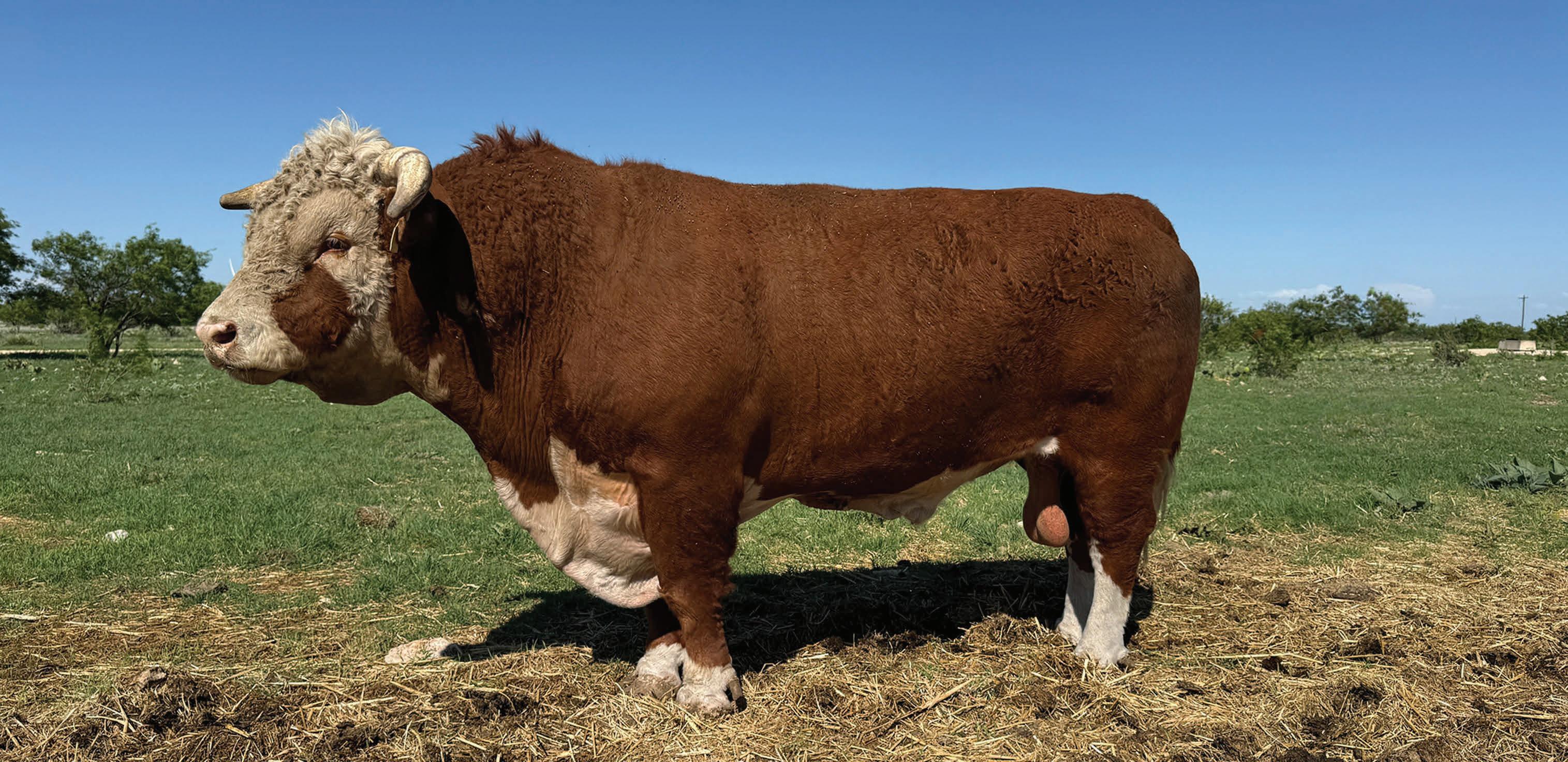
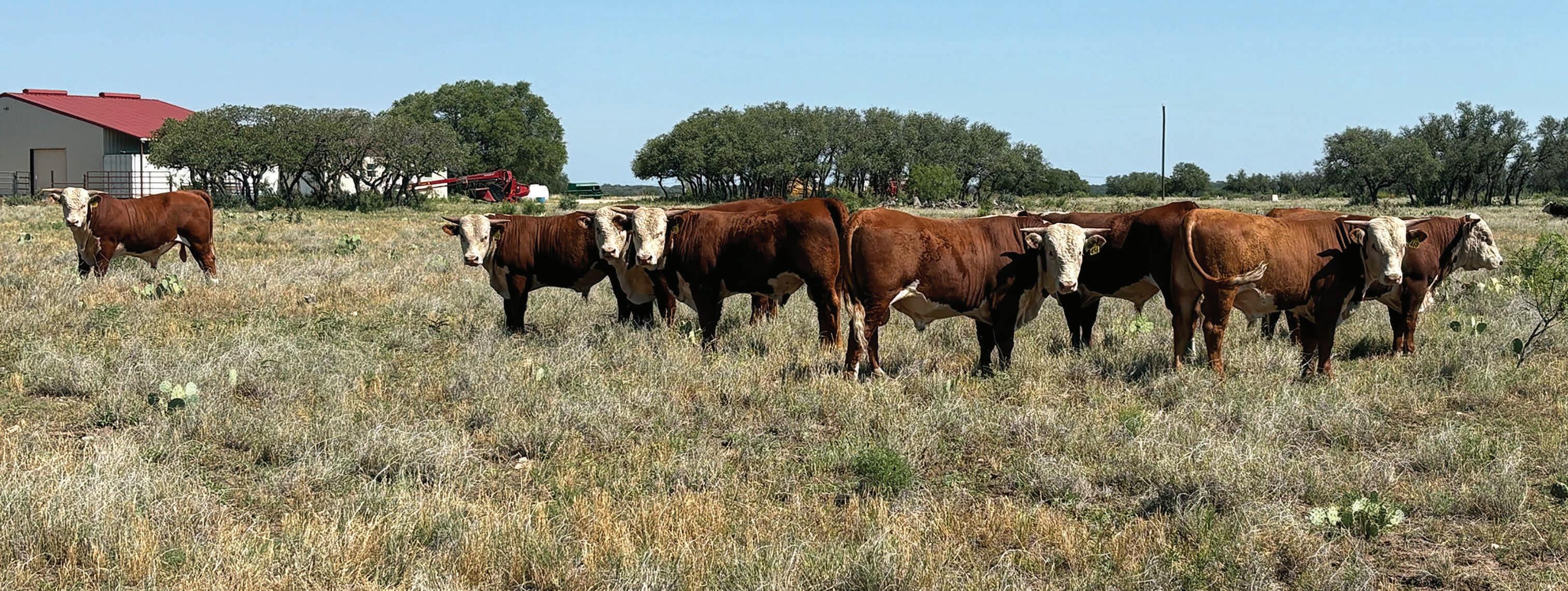

A conservation easement helps the Cornelius family keep their Matagorda County ranch intact.
By Lydia Saldaña
Photos courtesy of Texas Agricultural Land Trust
For more than 100 years, the Cornelius family has been working cattle on their family land near Sargent in Southeast Texas.
Herff Cornelius’ grandfather bought the original tract in 1917 and moved cattle from Markham to winter in the saltgrass there every year for decades. Herff’s father continued the ranching tradition after his father passed on, and the whole family was involved.
“My dad had eight kids, including me and my seven sisters, and we were the cattle crew,” Herff said. “Anytime there was cattle work to be done, he loaded us all up and we went there and worked. I remember a lot of my childhood being on horseback working cattle.”
E Cross Cattle Company is bordered on the south by the Intracoastal Waterway and has 4.3 miles of frontage on Caney Creek. It is a premiere piece of coastal prairie rangeland, offering productive grazing land and exceptional wildlife habitat. Like his father and grandfather before him, Herff is a hands-on manager of the property and treasures the land he stewards.
When his father died in 2013, followed by his mother’s passing in 2014, the family had a tough decision as
they contemplated the transfer of family land from one generation to the next. With seven sisters, and dozens of other family members to consider, it was not an easy decision. One thing they all agreed on was that it had to be a unanimous decision: either keep it all or sell it all.
About that time, Herff learned about Texas Agricultural Land Trust and how a conservation easement might help their family. “One thing led to another, and we began serious discussions about how we might keep this land together to benefit everybody,” Herff said.
It was a complicated series of discussions that involved multiple partners over several years, including the Texas Parks and Wildlife Department, the National Fish and Wildlife Foundation, the General Land Office and the U.S. Fish and Wildlife Service.
The fundamental issue was figuring out how the easement would be funded, so the family could benefit financially from keeping the land together and protecting its conservation values in perpetuity. The alternative would be to benefit financially by selling the land. There are vacation homes lining the other side of the creek bordering the Cornelius family land, foreshadowing the future of the ranch if the land was sold and developed.
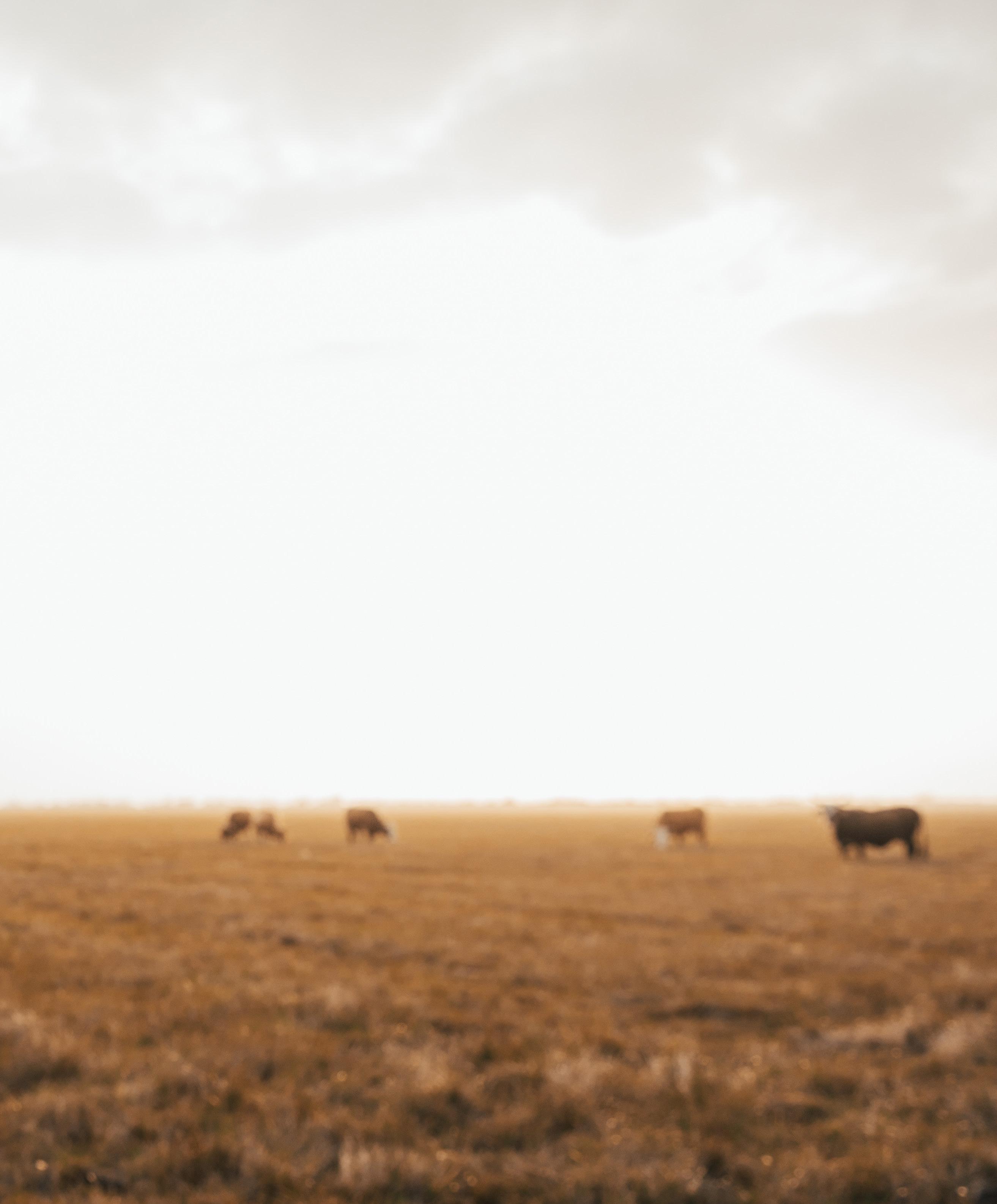
“My dad had eight kids, including me and my seven sisters, and we were the cattle crew. Anytime there was cattle work to be done, he loaded us all up and we went there and worked.”
— Herff Cornelius, E Cross Cattle Company

Numerous conservation partners got involved because of the tract’s significant natural assets and the property location adjacent to Matagorda Bay, which is a conservation priority for government agencies and conservation NGOs alike. Texas Parks and Wildlife Department officials recognized the property as an outstanding example of coastal wildlife habitat that would be a significant contribution toward a state, federal and private collaborative to protect as much pristine habitat around Matagorda Bay as possible.
That recognition led the department to nominate the project for funding from the National Fish and Wildlife Foundation’s Gulf Environmental Benefit Fund. The nomination and selection process took several years to complete, and in the interim, the appraisal grew stale and had to be re-done. The new appraisal revealed a funding gap, and Texas Parks and Wildlife turned to the General Land Office’s Coastal Management Program for assistance. Through dollars provided by the Gulf of Mexico Energy Security Act fund, the gap was closed. U.S. Fish and Wildlife Service also came to the table to assist Texas Agricultural Land Trust with due diligence costs associated with the transaction.
More than six years after the Cornelius family began considering the idea, the conservation easement finally closed in January 2023 — forever protecting 3,547 acres of precious coastal habitat.
“This transaction is a testament to some creative minds that came together to seek out every funding option available to make it all work,” said James Oliver with Texas Agricultural Land Trust, who helped shepherd the transaction through to closing. “When likeminded organizations and individuals are all pushing toward the same conservation goal, good things can happen. We are very grateful to the Cornelius family for hanging in there with patience and perseverance. Thanks to them, this land will be preserved for generations to come, benefitting us all by helping to keep our air and water clean.”
Like his father and grandfather before him, Herff will continue to work the land that has given his family so much. Thanks to the conservation easement held by Texas Agricultural Land Trust, his children and grandchildren, and those of his seven sisters, will have that same option.
“I think everybody’s just really happy that future generations will be able to continue to use this property for ranching, hunting and conservation of the wildlife we all enjoy,” Herff said. “Everybody is just very happy about that.” T C




The land is our legacy and on January 31, 2026, join us at Fall Creek Ranch in Granbury for a one-of-a-kind trail run across pastures, creek crossings, and wide-open country.
Every stride supports the Texas Agricultural Land Trust’s mission to conserve working lands. Whether you run the 5K, 10K, or Half Marathon—or cheer from the sidelines—you will be part of protecting the land, water, and wildlife that define Texas ranching.
JANUARY 31, 2026
Register Today! Early Bird ends November 7th.


By Kent Ferguson
Sand sagebrush is a native perennial, semievergreen shrub found on sandy soils from West Central Texas to the Rolling Plains, and the Panhandle region to far West Texas. It also grows throughout the western U.S.
Sand sagebrush is also called sand sage, silver sage and sand worm-wood. The plant:
• Reaches 6 feet tall and 4 feet wide; and has gray, thread-like leaves that are alternate and sessile, 1.5 to 3 inches long and 1/25 of an inch wide.
• Has lower leaves that are sometimes divided into several thread-like segments curving inward toward the stem.
• Has brown bark with a blue tint on older stems, while young stems are red on the lower portion and silver on the top. The bark will peel off into narrow strips.
• Flowers in the fall with adequate moisture, forming dense terminal panicles that are silver. They form achenes with four to five tiny ribs.
Sand sagebrush is not beneficial browse for whitetailed deer, but livestock will graze the plant if forage is limited. It is used for nesting and loafing cover by birds.
Scaled quail and various songbirds will use the fruit for food. Pollinators will consume the plant when blooming, too. It has also been used as an accent plant in landscaping projects.
Sand sagebrush will increase in density if pastures are overgrazed. Practicing suitable grazing management will keep the plant in check and prevent encroachment. T C
Kent Ferguson, a retired rangeland management specialist from the USDA Natural Resources Conservation Service, provides plant identification photo stories to help ranchers.







Determining hay quality begins with selecting the right probe to collect samples.
Hay probes come in two main types: push-type probes that are manually pushed into the bale, or drill-type probes that require a drill to collect a core sample. There are variations in design and ease of use with both styles, so it is beneficial to research options before purchasing.
Well-designed push-type probes are generally much quicker and easier to use than drill-type probes. However, producers with back issues or other challenges may find drill-type probes to be better options.




By Zoe Carmichael
As the fall bull sale season begins, one message is clear: Identifying a herd sire is more than a transaction, it is a strategic, long-term investment in herd genetics.
Leoma Donsbach, owner and founder of Data Genie LLC, was a featured speaker on this topic during Texas & Southwestern Cattle Raisers Association’s Ranching 101 webinar series. She shared practical insights with association members on setting breeding objectives, building a budget and making informed sire selection decisions.
“It’s not just about buying a bull anymore,” Donsbach said. “It’s about asking yourself, ‘Do I want this bull’s influence in my herd until 2040?’”
terms. Treating it as a long-term investment helps producers remove emotion from the equation.
“Too many people get caught up in the auction moment,” she said. “You just got outbid on bull A, so you turn around and buy bull B just to win. But did you make the right choice for your herd?”

Every bull purchase, Donsbach emphasized, should begin with a decision tree. That includes identifying breeding objectives, narrowing down breed choices and choosing a well-matched seedstock provider.
“You need to be honest about what you want your operation to look like in five, 10 or even 15 years,” she said. “And whether your current choices are setting you up to get there.”
Just like purchasing a truck or trailer, Donsbach said, the value of a bull should be considered in hard business
Donsbach stressed to the audience of cattle raisers that bull selection should begin at the kitchen table. Whether running five cows or 1,000, she encouraged producers to sit down with their family or partners and outline clear breeding goals. Then use those goals to guide every selection decision.
“The conversation should be brutally honest,” she said. “Take your emotions out of it and focus on the traits that move your herd forward.”
In addition to pedigrees, phenotypes and genomic information, Donsbach said it is also important to consider how and where the bull was raised. While genetics account for about half of an animal’s performance potential, the rest comes down to environment — forage availability, climate, health protocols and overall management.
by Kayla
Even the best genetics fall short if a bull isn’t managed under similar conditions.
“You might buy a bull from a breeder who manages cattle extremely well and their management practices help make up for any genetic limitations,” Donsbach explained. “But if your operation runs differently in the way that your environment, nutrition or stress levels don’t match, you may not see the same results.”
When bulls underperform after arriving on a new operation, it’s tempting to blame the animal or the breeder. But often, she said the issue is a mismatch in environment and expectations.
Donsbach encouraged producers to compare apples to apples by choosing seedstock providers who raise cattle under similar conditions or adapt their own management style to more closely mirror that of the seedstock source.
Analyzing data
After identifying breeding goals and the type of herd sire to achieve them, cattle raisers have greater access to data than ever before to make confident, informed decisions. One of the most valuable tools in the bull-buying process is expected progeny differences.
An EPD estimates the genetic value an animal is expected to pass on to its offspring, expressed as a deviation from breed average. It is important, Donsbach emphasized, to understand an EPD does not evaluate the animal itself, but rather the genetic potential of their offspring based on key traits.
“Why would anyone settle for below average if you only have a certain amount of investment to make in your genetic decisions?” she said. “Why would you choose a bull that ranked in the bottom of the class?”
Every EPD is a combination of pedigree, phenotype, genotype and progeny performance data. When those figures are genomically enhanced, producing what’s known as GE-EPDs, the accuracy increases significantly, Donsbach said.
“If a bull doesn’t have genomic data, you’re taking on more risk as a buyer,” she said. “That’s not a risk you should have to take in today’s environment.”
Donsbach also encouraged commercial cow-calf producers to take advantage of heterosis or hybrid vigor by crossbreeding strategically.
“Hybrid vigor adds pounds at weaning. It improves fertility, health and sustainability,” she said. “It’s a proven way to add value.”
For seedstock producers, outcross genetics can inject diversity. Whether raising Angus, Hereford, Simmental or another breed, Donsbach recommended using genomics to identify complementary outcrosses that bring genetic progress without sacrificing breed integrity.

At the heart of Donsbach’s advice to cattle raisers was a call to approach bull buying with intention, clarity and a long-term mindset. Whether running a commercial cowcalf operation or seedstock herd, the bulls purchased today will have lasting effects.
“The bulls we’ll sell in 2026 are already in our cows today,” she said. “The decisions have already been made. The question is, what do we do differently starting in 2027 or 2028?”
Donsbach encouraged producers to remember purchasing a bull is a business decision, not a competition with fellow buyers. The right herd sire isn’t the one with the most buzz in the ring, it is one that aligns with an operation’s goals, fits the environment and adds lasting value to the herd. T C
“Be honest with yourself about what you want your operation to look like in five, 10 or even 15 years.”
— Leoma Donsbach, Data Genie LLC

Sale features include several herd sire prospects that excel for calving ease, growth, marbling, docility and data.
Cooke County Fairgrounds, Gainesville, Texas
Selling 65 powerful 18-24 month old, ranch-raised Angus bulls ready to go to work! Including202-year-oldbulls.Sellingsonsof Identify,Clarity,FireballandWinchester.
Also featuring the Customer Appreciation Commercial Female Sale... top quality replacements from quality Lone Star Genetics!
Video and EPD spreadsheet available online 2 weeks before sale.
Calving ease, growth, marbling and docility.
Free delivery within 300 miles for purchases of $7,500 or more.






Bulls Bred for Performance but Raised on Limited Feed and Grass FERTILITY • EFFICIENCY • DOCILITY • SOUNDNESS • LONGEVITY
OCTOBER 13, 2025 12:30 P.M. AT THE RANCH SELLING: 67 Coming 2-year-old Bulls (53 Horned & 14 Polled) 12 Fall-Calving Cows (most calved by sale day)

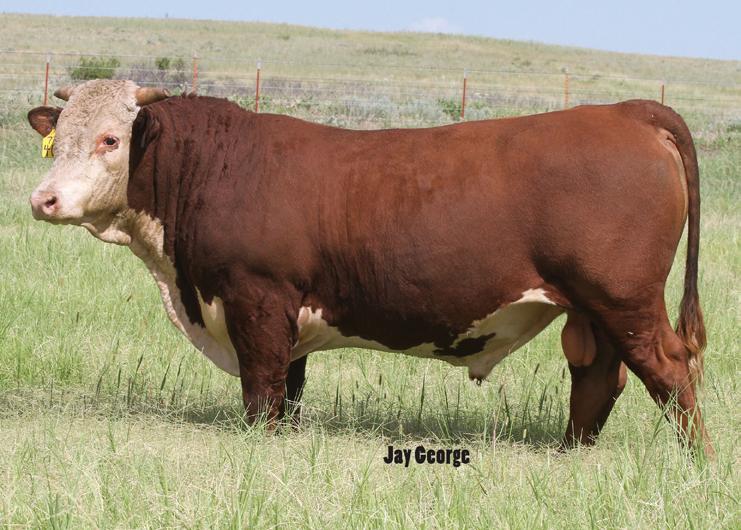



12.1


SIRE: IMR 33Z VICTOR 9084G ET MGS: CMF 59Z CONFIDENCE 204C

8099F MS ADVANCE 2092K ET {DLF,HYF,IEF,MSUDF} SIRE: IMR L1 5047C ADVANCE 8099F ET MGS: IMR 408 HARLAND 9038W ET


Cattle for Sale at the ranch by Private Treaty any time
Steve Wayne (325) 835-2531
Stephen (325) 226-4184 (cell) Logan Furlong, Ranch Manager (325) 650-8402 Box 645 • Mertzon, TX 76941 scoatesjr@yahoo.com www.coatesranch.com
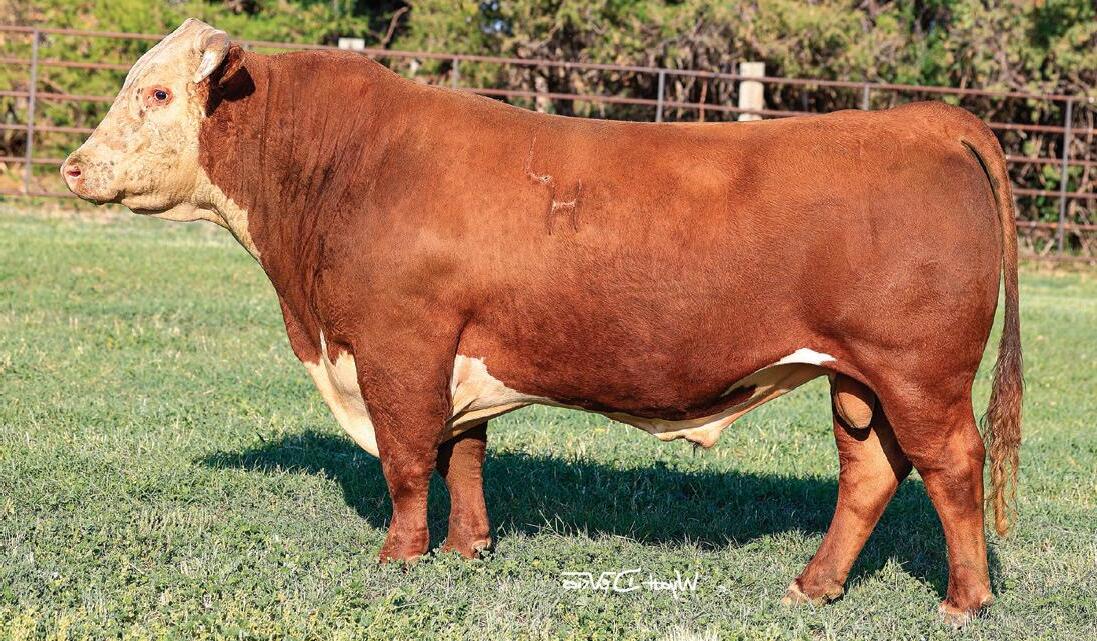
















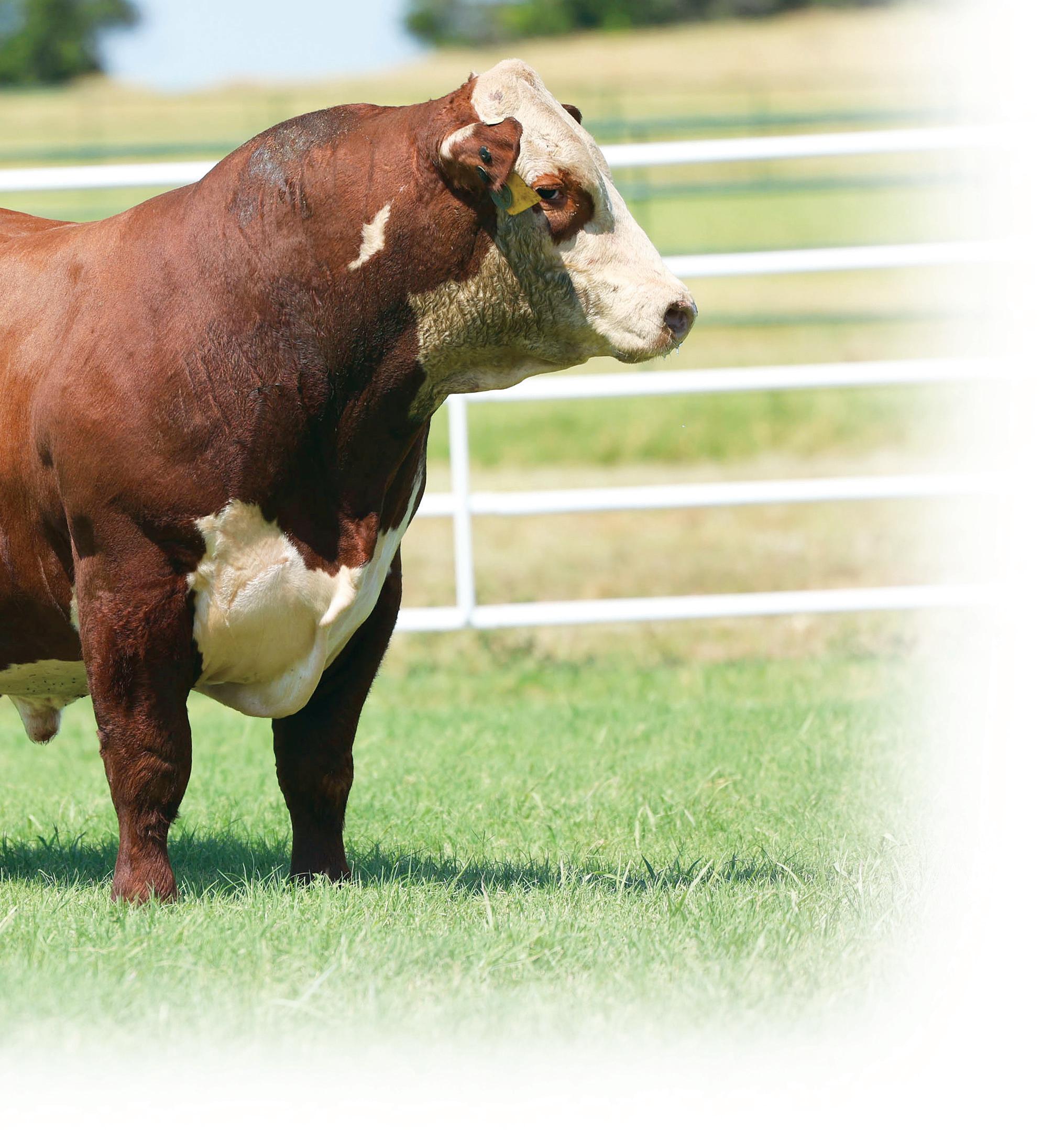

THURSDAY, OCTOBER 9, 2025
12 noon at the GKB Sale Headquarters …Desdemona, Texas
115 Coming 2-year-old Bulls Sell! 80 Hereford + 35 Angus, SimAngus & Red Angus GKB GUARDIAN 4192 AHA




Catalog available online and mailed on request — please call or text to request your mailed copy. Videos online prior to sale day. Since 1987. Second Annual

GKB RED LABEL 9060M
RAAA 4908056 • 3/24/24 • PB Red Angus
S: Shag Red Label 120
MGS: MLK Big Foot CED +9 /


GKB ADVANCE 4401M AAA 21300412 • 3/23/24 • PB Angus S: Huwa 7404 B Advance 9441 MGS: VAR Power Play 7018

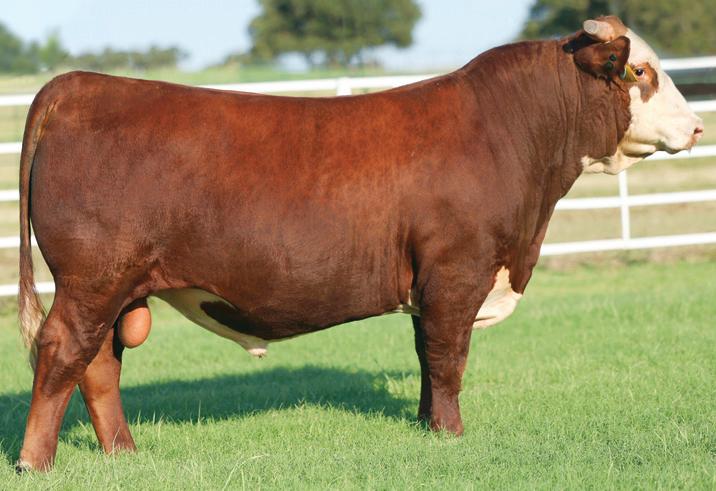
GUARDIAN

Laramie B293

GKB ROYALTY 4150M
ASA 4360492 • 2/22/24 • Polled 1/2 Simm,1/2 Angus S: GPG Royalty 219H
Baldridge Bronc

Gary & Kathy Buchholz, owners • Office (254) 440-1440
Gary Buchholz (214) 537-1285 • gary@gkbcattle.com Jay Creamer (254) 707-2199 • jay@gkbcattle.com Raymond Gushee (207) 256-7365 • ray@gkbcattle.com 7440 Hwy. 16, Desdemona, TX 76445 gkbcattle.com




Dustin N. Layton (405) 464-2455 laytond@yahoo.com Chisolm Kinder (405) 747-4683 laytonauction.com Sale Manager








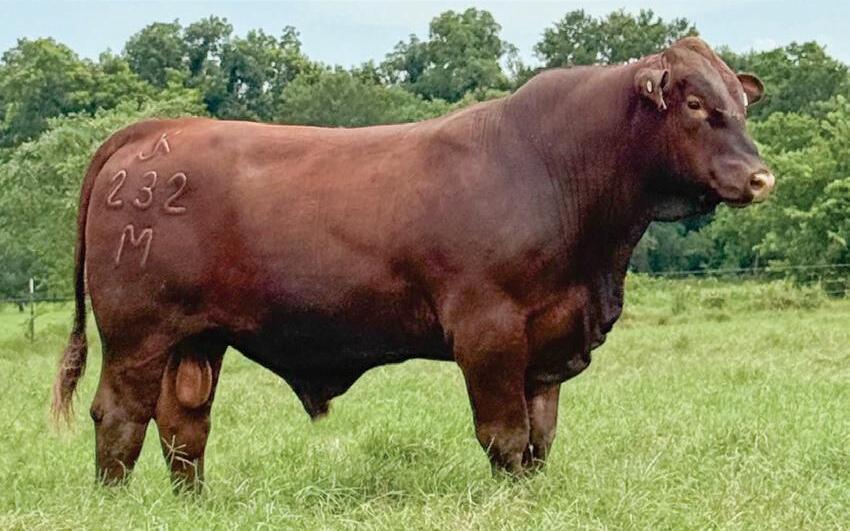











HeartBrand® Cattle: Leading the Way in Proven Akaushi Genetics!
HeartBrand Cattle delivers proven Akaushi genetics—a low-risk investment that expands opportunities for grid premiums and quality-based markets, leading to increased profits for you. Akaushi genetics improve:



Marbling and quality grade in just one generation
Fertility and longevity for lasting productivity
Hybrid vigor to strengthen your herd
With females, embryos, and semen available year-round—plus private treaty bull sales in the spring and fall—there’s always an opportunity to add more value with Akaushi genetics to your operation!




Your answer to real-world success for payday profits and a sustainable cow herd!



WEDNESDAY, NOVEMBER 12, 2025
11 a.m., Jordan Cattle Auction, San Saba, Texas
Horned, Polled & Homozygous Polled Hereford Bulls…Powerful…Docile…Efficient…Fertile…GE-EPDs
Progressive cattlemen have been choosing Barber Ranch bulls for over 10 0 years.
Wanna know the reason?
Our emphasis has always been on extra muscle in an attractive package. Our 2025 sale bulls sport impressive carcass EPDs to complement their performance. We offer a unique combination of calving ease, explosive growth and highly desirable carcass traits with extra good looks.



In addition to approximately 100 service-age Hereford bulls, our 2025 San Saba sale will feature approximately 50 head of spring bred registered Hereford heifers— all with genomically enhanced EPDs.

Brett Barber (806) 681-2457 Justin Barber (806) 681-5528 Terri Barber (817) 727-6107 Jacob Toombs (417) 399-0738
& Mary Barber office@barberranch.com 10175 FM 3138, Channing, TX 79018 barberranch.com

Catalog requests: Rylee.R.Barber@gmail.com
Barber Ranch is located 60 miles northwest of Amarillo, Texas. Visitors always welcome!


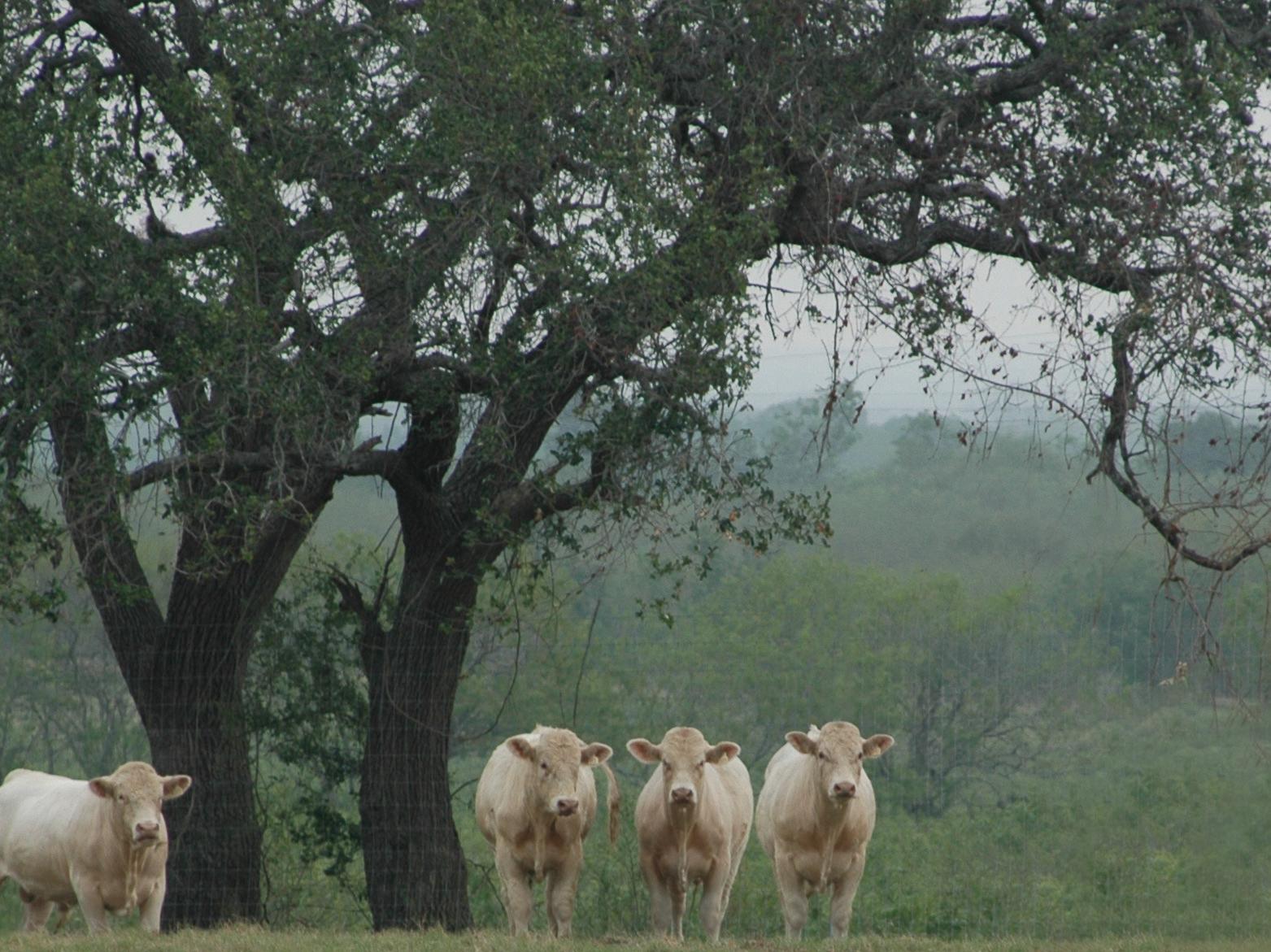
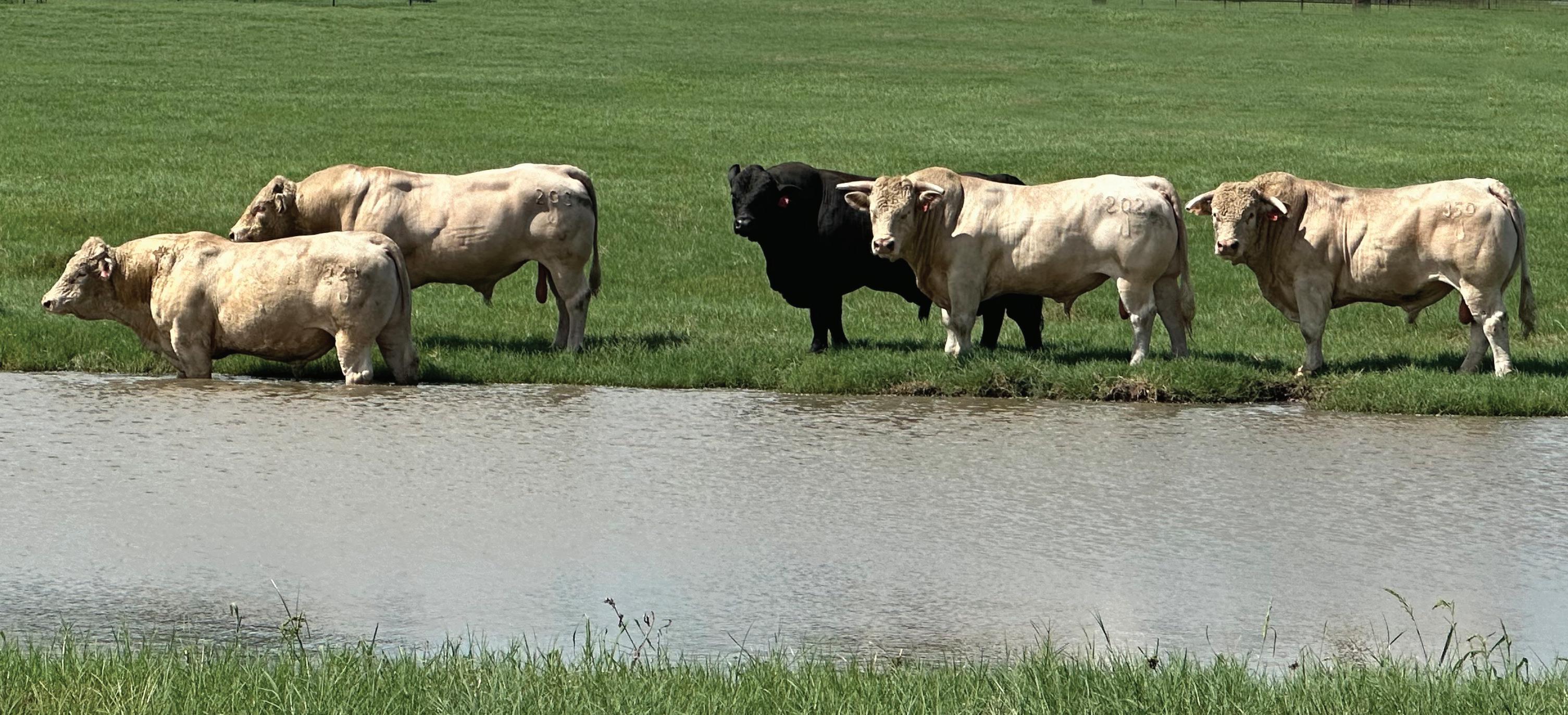










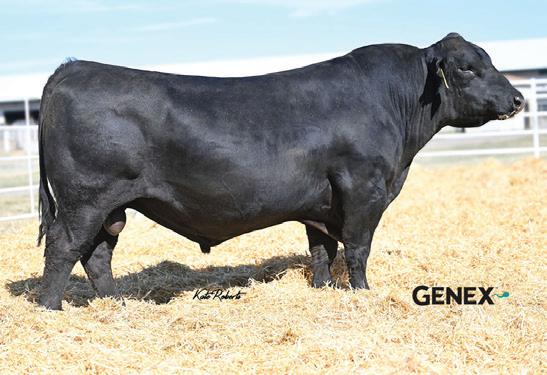










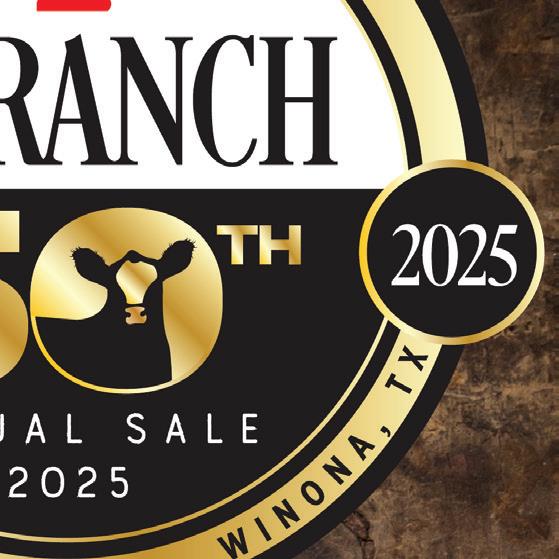














• 13-24 months of age







60 SIMMENTAL AND SIMANGUS™ BULLS

• Most are AI Sired by some of the top Simmental and SimAngus™ sires in the industry
70 SIMMENTAL AND SIMANGUS™ FEMALES
• 3N1s, Breds and Pairs, including Mature Cows
• Open Yearling Heifers ready to breed
• Many are AI Sired and selected out of the heart of the 7P program
25 SIMBRAH FEMALES

• Pairs and Breds, plus Open Heifers ready to breed
• Most are ½ Simmental ½ Brahman heifers resulting from the mating of productive 7P Ranch Simmental cows to elite Brahman sires
• Most are registered with the American Simmental Association and also eligible to be Golden Certified registered with the American Brahman Breeders Association Lunch served at 12:00 NOON











Why use Adams Ranch bulls? Why use Adams Ranch bulls?
This year, nearly 1,500 head of Adams Ranch
This year, nearly 1,500 head of Adams Ranch fed steers and heifers have graded fed steers and heifers have graded 21% 21% Prime, 73% Choice and 6% Select Prime, 73% Choice and 6% Select
If you’re looking to increase carcass merit, If you’re looking to increase carcass merit, come join us at the sale in person or online! come join us at the sale in person or online!


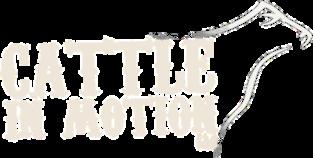





DECEMBER 18, 2025 - SALE STARTS AT 10:00AM (CT)
SALE LOCATION: JORDAN CATTLE AUCTION - SAN SABA, TX
OFFERING RED AND BLACK AGE-ADVANTAGED STABILIZER BULLS AND 20 SELECT AGE-ADVANTAGED RED ANGUS BULLS

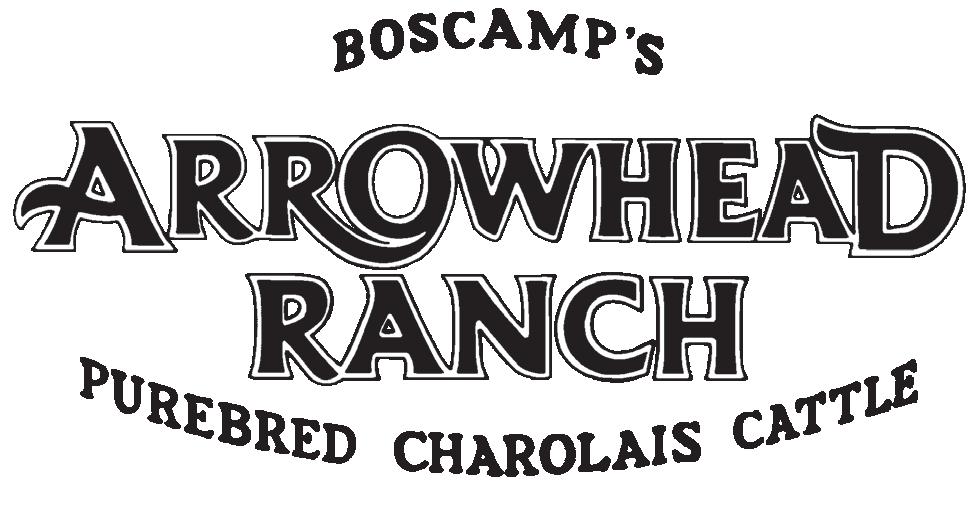












•







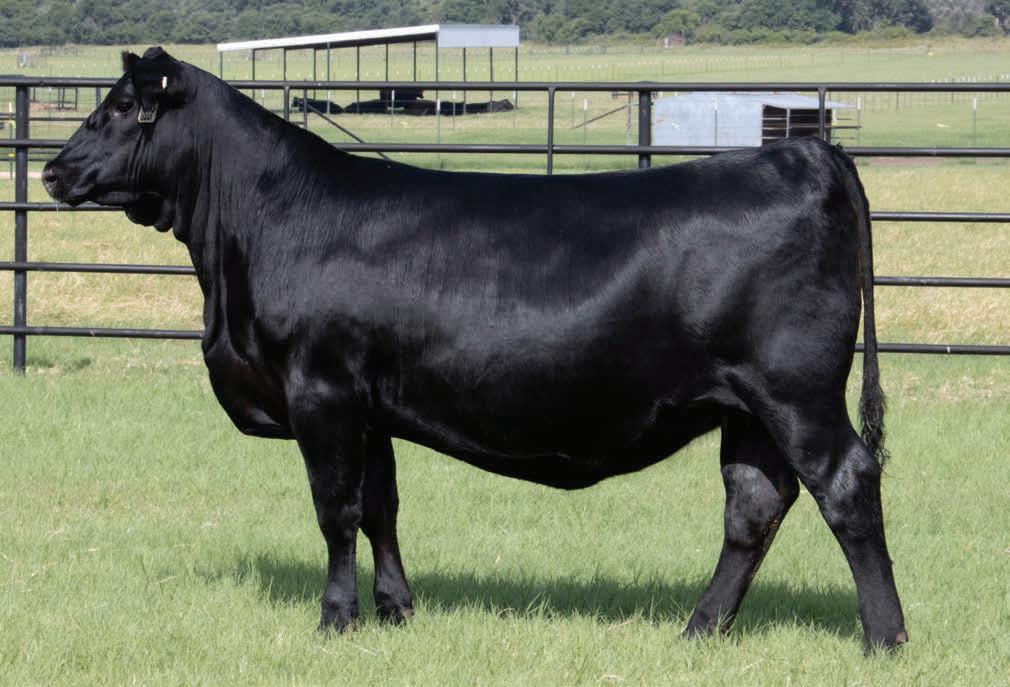







By Sarah Mullens
T. Michael O’Connor, of Victoria, was a young boy when he attended his first Texas & Southwestern Cattle Raisers Association meeting. He was eager to follow along with his father, Thomas M. O’Connor, and felt right at home at industry events — making lifelong friendships with other children who did the same.
“It’s not just an association; it’s an extension of your family,” he says.
A fifth-generation rancher, O’Connor has been involved in his family’s operations in South Texas and New Mexico for more than three decades.
“It is in my DNA,” he says. “I woke up one day, and here I am, a rancher. It has been very gratifying, more so because of the legacy and heritage.”
O’Connor is a 1977 graduate of Texas A&M University with a degree in agricultural range science. He says he was able to apply his education to what he had been taught on the ranch all his life.
“You have to be a conservationist in rangeland and water,” he says. “It’s gratifying when you can take those challenges and have a sustainable operation.”
Beyond ranching, O’Connor has more than 40 years of law enforcement experience. In 2005, he was sworn in as Sheriff of Victoria County and served four terms. In 2020, he was appointed and sworn in as a U.S. Marshal for the Southern District of Texas. O’Connor says he feels it is a calling to serve his community in this way.
O’Connor was elected to the Texas & Southwestern Cattle Raisers Association board of directors in 1987.
Throughout the years, he has served on the agricultural research, legislative, and tax and wildlife committees.
“Because of my lifetime association with TSCRA and my extensive experience in law enforcement addressing transnational criminal organizations, I was uniquely positioned to testify on behalf of TSCRA members who have been affected by these organizations traversing their ranches along the southwest border,” he says. “That allowed for an awareness to the governance groups both on the state and the national levels — and taking action.”
He says being involved with the association helps him and others remain educated and engaged with an ever-changing industry. He encourages newcomers to do the same.


T. Michael O’Connor has been involved with Texas & Southwestern Cattle Raisers Association since he was a young boy. Courtesy photos.
“The association is not only known for leadership in the state and nationally, they are also in tune with research and technology, especially at various land-grant institutions,” he says. “If you can be associated with not only the personnel of TSCRA, but also the membership, they will help give you some useful guidance.”
Staying resilient through the good times and bad, O’Connor has long understood that the family ranch was shaped and passed down by generations before him. He intends to do the same for the sixth and seventh generations in line.
“It was always told to me to understand these lands are not as much as your ownership as it is for the next generation,” he says.
O’Connor and his wife, LuAnn, have two children: Jane and Thomas. These days, his daughter and son both have careers and children of their own, but O’Connor says they are passionate about the ranch and believe in its future.
“I told my kids, whatever you do, wherever you go, just remember your heart and soul is of the land,” he says. T C
Sarah Mullens, a student at Oklahoma State University, was a summer intern through the Gilly Riojas Memorial Intern Program at Texas & Southwestern Cattle Raisers Association.

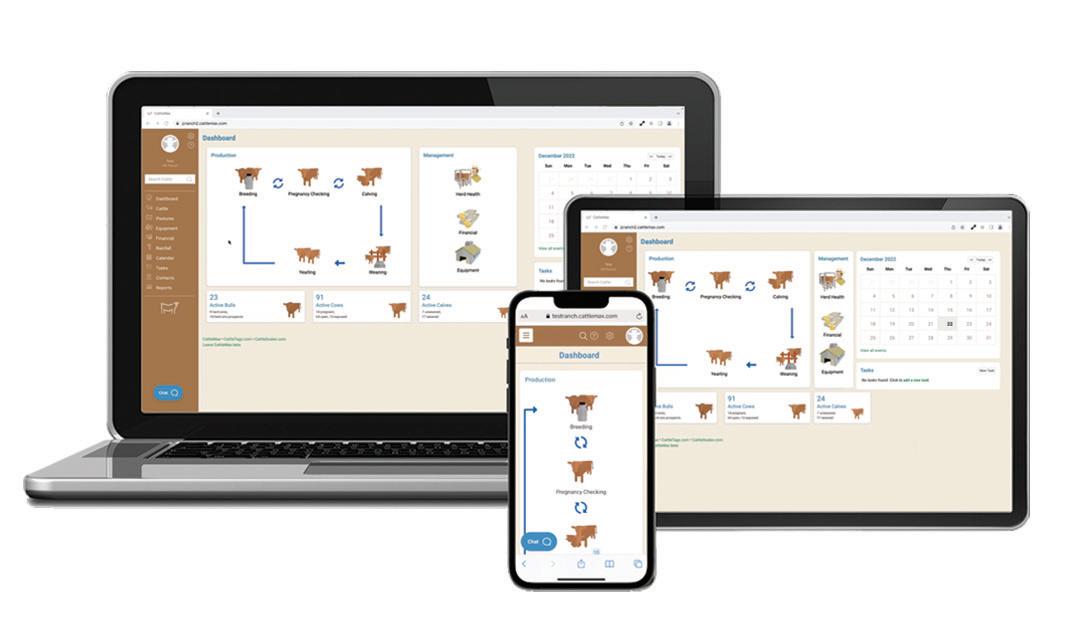
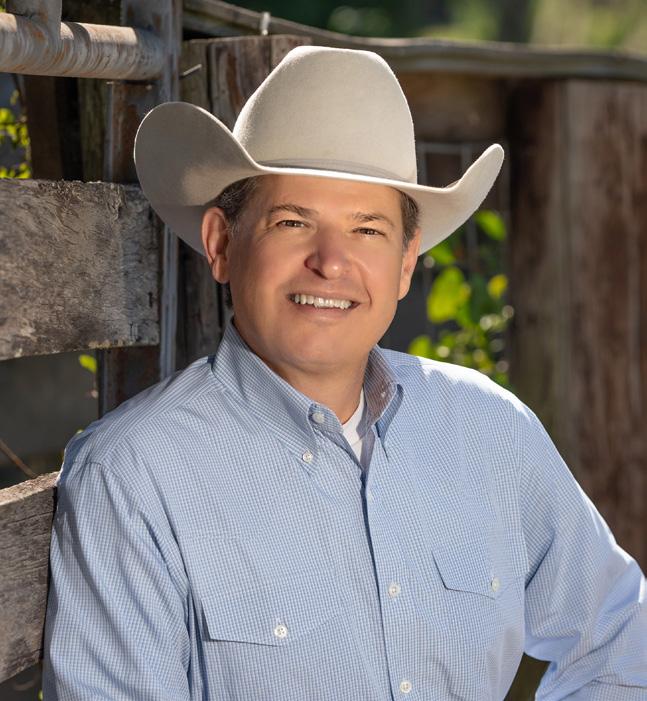
CARL RAY POLK JR.
President P.O. Box 155108 Lufkin, Texas 75915

STEPHEN DIEBEL
First Vice President 3907 Salem Rd. Victoria, Texas 77904

DAN GATTIS
Second Vice President and Secretary/Treasurer 213B W. 8th St. Georgetown, Texas 78626
James L. Powell San Angelo, 1988-1990
Tom Beard Alpine, 1994-1995
C. Coney Burgess Amarillo, 1997-1999
J. Mark McLaughlin San Angelo, 1999-2001
John E. Dudley Comanche, 2001-2003
Joe M. “Jody” Bellah, Throckmorton
Blake Birdwell, Canyon
E. S. F. “Swasey” Brainard II, Pampa
J. K. “Rooter” Brite Jr., Bowie
Donnell Brown, Throckmorton
Campbell Burgess, Amarillo
Deborah Clark, Henrietta
Lynn Cowden, Skellytown
Jake Cowen, Benjamin
J. B. Daniel, Crowell
James Henderson, Memphis
Bob McCan Victoria, 2003-2005
C.R. “Dick” Sherron, MD Beaumont, 2005-2007
Jon Means Van Horn, 2007-2009
G. Dave Scott Richmond, 2009-2011
Joe J. Parker Jr. Byers, 2011-2013
Clayton Henry, Wichita Falls
Brooks Hodges, Guthrie
Joe Leathers, Guthrie
Frank McLelland, Tahoka
Jeff Mitchell, Amarillo
Gage Moorhouse, Benjamin
Diaz W. Murray, Wichita Falls
J. Malcolm Shelton IV, Amarillo
Dale A. Smith, Amarillo
Jim Thompson, Breckenridge
Ross Thompson, Iowa Park
Wesley Welch, Lubbock
Pete Bonds Saginaw, 2013-2016
Richard Thorpe III, MD Winters, 2016-2018
Robert E. McKnight Jr. Fort Davis, 2018-2020
G. Hughes Abell Austin, 2020-2022
Arthur G. Uhl III San Antonio, 2022-2024
Kevin Busher, Winters
Charles M. “Charley” Christensen Jr., San Angelo
C.A. “Chili” Cole IV, San Angelo
Alan F. Curry, San Angelo
James H. Dudley IV, Horseshoe Bay
Amanda Dyer, Fort Davis
Johnny Ferguson, Big Lake
DA Harral, Fort Stockton
Ron Helm, Van Horn
Heath Hemphill, Coleman
Shelby W. Horn, Fredericksburg
Larry R. Horwood, Sterling City
Grant Jones, Rochelle
Mark W. Jones, Brady
W. Clay Jones, Brady
Ty Keeling, Boerne
Lorenzo Lasater, San Angelo
Brian T. McLaughlin, Midland
David L. Neal, San Angelo
Gerald Nobles Jr., Brady
James Oliver, Ozona
Wade Perks, San Angelo
Jessica Tate, Marfa
James Uhl, Fort McKavett
Cody Webb, Barnhart
C. Clark Welder, Fredricksburg
Ray W. Willoughby III, Eldorado
Ford Drummond, Pawhuska, Oklahoma
Edward Bordovsky Jr., Riviera
Austin Brown III, Beeville
W. Christopher Bush, Refugio
James Clement lll, Kingsville
David S. Crow, Corpus Christi
Dustin Dean, Floresville
David DeLaney, Kingsville
Robert “Bobby” Dobson, Birmingham, Alabama
James L. “Jamie” Donnell Jr., Fowlerton
J. David Eppright, Cost
Benjamin Eshleman III, Corpus Christi
Joseph B.C. Fitzsimons, Carrizo Springs
Robert “Robbie” Graff, D’Hanis
Parke Greeson Jr., Goliad
Bret Griffith, Del Rio
Heath Grigg, Kingsville
Marty R. Harris, Tilden
Anson Howard, San Antonio
William Whitby Jones III, Hebbronville
Leslie Kinsel, Cotulla
Claude Koontz, San Antonio
Steven J. Mafrige, Tilden
Richard Marbach, Victoria
Federico “Freddy” Nieto, Raymondville
T. Michael O’Connor, Victoria
Jason Peeler, Floresville
J.R. Ramirez, La Pryor
Michael Sasser, Corpus Christi
Lew Thompson, Pearsall
John E. Zacek, Victoria
Bill Cawley, Crockett
Wayne Cockrell, College Station
Herff Cornelius Jr., Wadsworth
Carlos Detering III, Houston
Gardner H. Dudley, Houston
Lloyd French IV, Houston
Cody Fry, College Station
Kelley Sullivan Georgiades, College Station
George Harrison, Bay City
Robert Hodgen, Houston
Colt Hoffmann, Marlin
Clay Kenley, Crockett
John Malazzo, Caldwell
Clive Runnells III, Austin
John Sumner Runnells III, Bay City
Tony Spears, Rosanky
John “Rocky” Sullivan, Galveston
Claudia Scott Wright, Richmond
April Bonds, Saginaw
Missy Bonds, Saginaw
John L. Cantrell, Cresson
Ian Chapman, Madill, Oklahoma
Hunter Crow, Dallas
James A. Dangelmayr, Muenster
Seth Denbow, Weatherford
Crawford Edwards, Fort Worth
John Greer, Henrietta
Jason Harlow, Dallas
Pete Hudgins, Sherman
Tom Johnson, Wortham
Ken Leiber, Fort Worth
Stefan Marchman, Fort Worth
William H. McCall, Fort Worth
Dan Nance, Haslet
Susan Roach, Fort Worth
Stephen S. “Steve” Sikes, Fort Worth
Bragg Smith III, Dallas
















































Texas & Southwestern Cattle Raisers Association directors represent six geographical regions across Texas and Oklahoma. Reference the special rangers page for a link to an interactive online map.



































William M. “Buck” Arrington, Pampa
Van Baize, Nocona
Bradford S. “Brad” Barnes, Fort Worth
Steve G. Beever, Pearsall
George Beggs IV, Fort Worth
Richard H. Bennett, San Antonio
Emry Birdwell, Henrietta
Mary Lou Bradley-Henderson, Childress
Chip Briscoe, Carrizo Springs
R.A. “Rob” Brown, Throckmorton
J.D. Cage, Muleshoe
Presnall Cage, Falfurrias
John W. Carpenter III, Dallas
Barrett D. Clark, Breckenridge
Martin W. Clement II, Kingsville
Thurman S. Clements Jr., Victoria
C.A. “Chip” Cole III, San Angelo
James T. Dangelmayr, Muenster
Nixon Dillard, Pleasanton
William C. “Billito” Donnell Jr., Alpine
Markham B. Dossett, Waco
Bob Drake, Davis, Oklahoma
James H. “Jim” Dudley, Comanche
Jay C. Evans, Dripping Springs
Trainor Evans, Mercedes
Leroy Ezer, Anahuac
Jim L. Gates, Pearsall
Richard Gates, Marfa
Mike Gibson, Paducah
Ronald J. “Ron” Gill, Chico
Frank Green, Liberty
W. H. “Billy” Green III, Albany
Milton S. Greeson Jr., Victoria
Thomas J. “Tommy” Haegelin, Concan
Dr. Philip C. Hardee, Beatrice, Alabama
Rafe Hargrove, Rotan
Tom J. Haynie, Navasota
Dr. Joe Pat Hemphill, Coleman
Ken Jordan, San Saba
Don Keeling, Fredericksburg
David W. Killam, Laredo
John Z. Kimberlin Jr., Dallas
Dan W. Kinsel III, Cotulla
Chris Lacy, Fort Davis
Steve C. Lewis, San Antonio
James E. “Jim” Link, Crowley
Coleman H. Locke, Hungerford
Ben Love, Marathon
Katharine Armstrong Love, Austin
Richard M. Lucas Jr., Houston
Robert B. Mansfield, Amarillo
Jon David Mayfield, Dublin
Jim McAdams, Seguin
James A. McAllen, Linn
William “Alan” McNeill, Beaumont
Len P. Mertz, San Angelo
Evalyn Moore, Richmond
Raymond E. Moore IV, Richmond
Bob Moorhouse, Weatherford
Tom Moorhouse, Benjamin
Beth Knolle Naiser, Sandia
Russell Noble, Ardmore, Oklahoma
Les Nunn, Pauls Valley, Oklahoma
Boots O’Neal, Guthrie
James Palmer, Roaring Springs
Rick Peebles, Baytown
Tim Pennell, Westhoff
Tom Perini, Buffalo Gap
Jim Peters, Quemado
Scott Petty Jr., San Antonio
Bill Phinizy, Gail
Frank Price, Sterling City
Gary Price, Blooming Grove
Mary Joe Reynolds-Montgomery, Fort Worth
Tom L. Roach III, Bozeman, Montana
Charles R. “Butch” Robinson, Navasota
Nolan Ryan, Round Rock
M. Stuart Sasser, Corpus Christi
Gordon E. Sauer, Fredericksburg
Wilson Scaling, Henrietta
Chris Scharbauer, Amarillo
Frates Seeligson Jr., San Antonio
Ed Small, Austin
Danny B. Stewart, Sterling City
Gerald Sullivan, Galveston
Stephen T. “Steve” Swenson, Dallas
Rick Tate, Marfa
Cliff Teinert, Albany
Richard Traylor, Batesville
Robert J. Underbrink, Houston
Tom Watson, Muleshoe
Dennis W. Webb, Barnhart
John Welch, Wolfforth
Richard Wortham, Austin
Ken Welch, Baird
Roger F. Welder, Victoria
A.B. Wharton, Vernon
W.C. “Billy” Williams, Mertzon
David W. Winters, Del Rio
Dr. M. R. “Mike” Wirtz, Brenham
Tom Woodward, Decatur
Bart Wulff, Dallas
Curtis A. Younts Jr., Belton


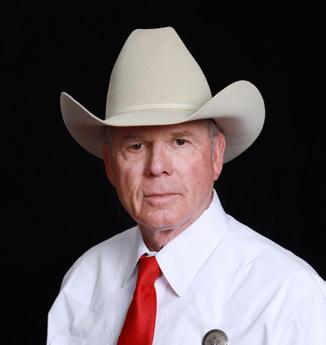




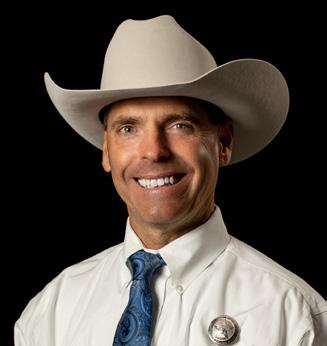


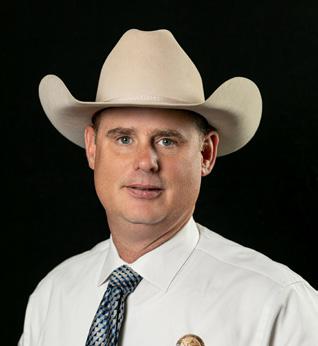







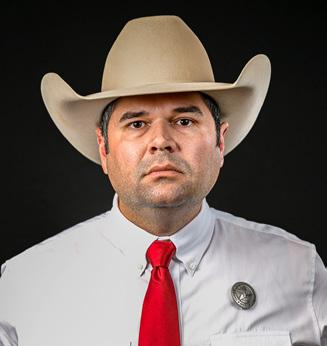

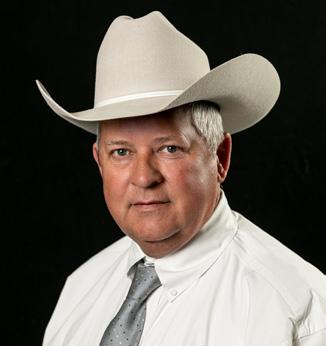







By Sarah Mullens
Robin Gibbs, a market inspector for Texas & Southwestern Cattle Raisers Association, never fails to bring the fun.
She covers auction markets across North Texas, traveling weekly between Gainesville and Paris. This year marks her 30th anniversary with the association.
“I’m a fun-loving girl,” says Gibbs, a Fort Worth native. “I walk around with a smile all day.”
One auctioneer even nicknamed her “Junebug” because of her upbeat attitude.
Livestock markets have always been familiar places because her in-laws owned a market in Bonham. Her husband, Jacky, briefly held the inspector title, but it was only a few months before he passed the torch.
“My husband asked if I could fill in because he was also the auctioneer and ticket rider at the sale barn,” Gibbs says.
She officially took on the job in 1995, and at the time, was the only female market inspector. Gibbs was also a new mother to her two children, Cody and Carson, who are now in their early thirties.
“It was really fun to go to the meetings with all the guys, and then there was little old me,” she says.
Throughout the past three decades, Gibbs has worked countless sales, sharpened her skills and gained friendships with people who she says make the cattle industry feel like home.
“Each sale barn that I go to is different,” she says. “You’ll meet different groups of people and different owners.”
With that in mind, Gibbs says she adapts to the unique rhythm of each livestock market. Over her years as a market inspector, she has learned valuable lessons, making her work more effective.
The use of technology has changed the game for Gibbs and market inspectors all over the Southwest, too.
She remembers how, not long ago, a report from a 1,500-head sale would’ve taken eight-plus hours to write up. Today, it’s three hours. “I love my computer,” Gibbs says. “I hope nothing happens to it; I pray over it all the time.”
While the cattle industry has evolved over the years, Gibbs says she is committed to her role as market inspector and the community she has built. After

decades of examining cattle and watching for theft, she has established strong rapport with cattle raisers and understands their operations.
“I know people’s brands,” Gibbs says. “One day I was at Gainesville and saw a man’s cattle come in with his brand on them; they were stolen.”
Recognizing that theft right away allowed for a faster response, and the stolen cattle were taken back to their owner that day.
“If I see something I know is not right, I will send my special ranger a message,” she says. “And they will do the same.”
Her positive impact on the cattle industry fuels her passion for the job.
“People ask me why I’m still doing this,” she says. “Because it’s fun. I like something to do besides sitting at my house playing with my own cows. I’m a people person; I like to meet all the people and talk to them.” T C

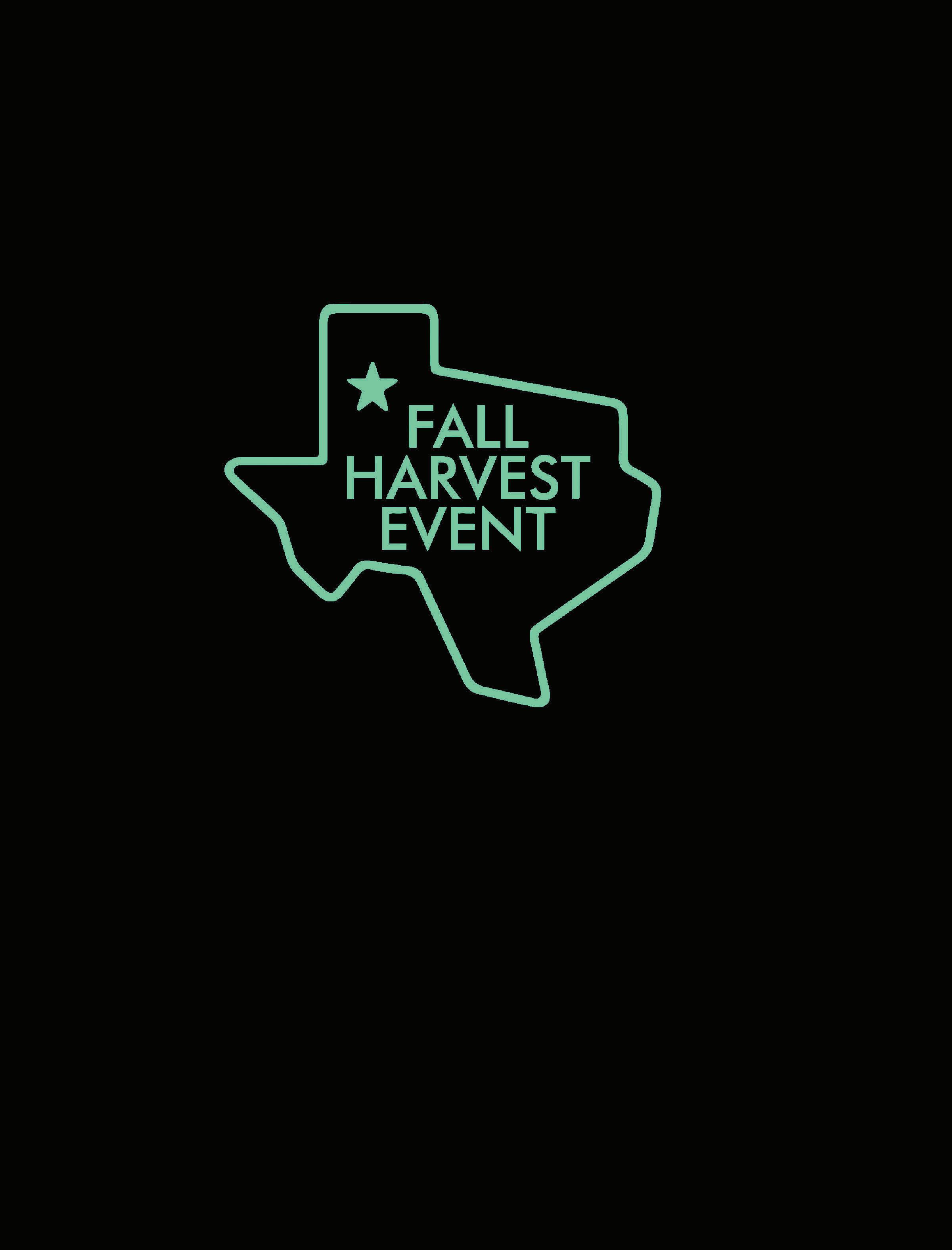


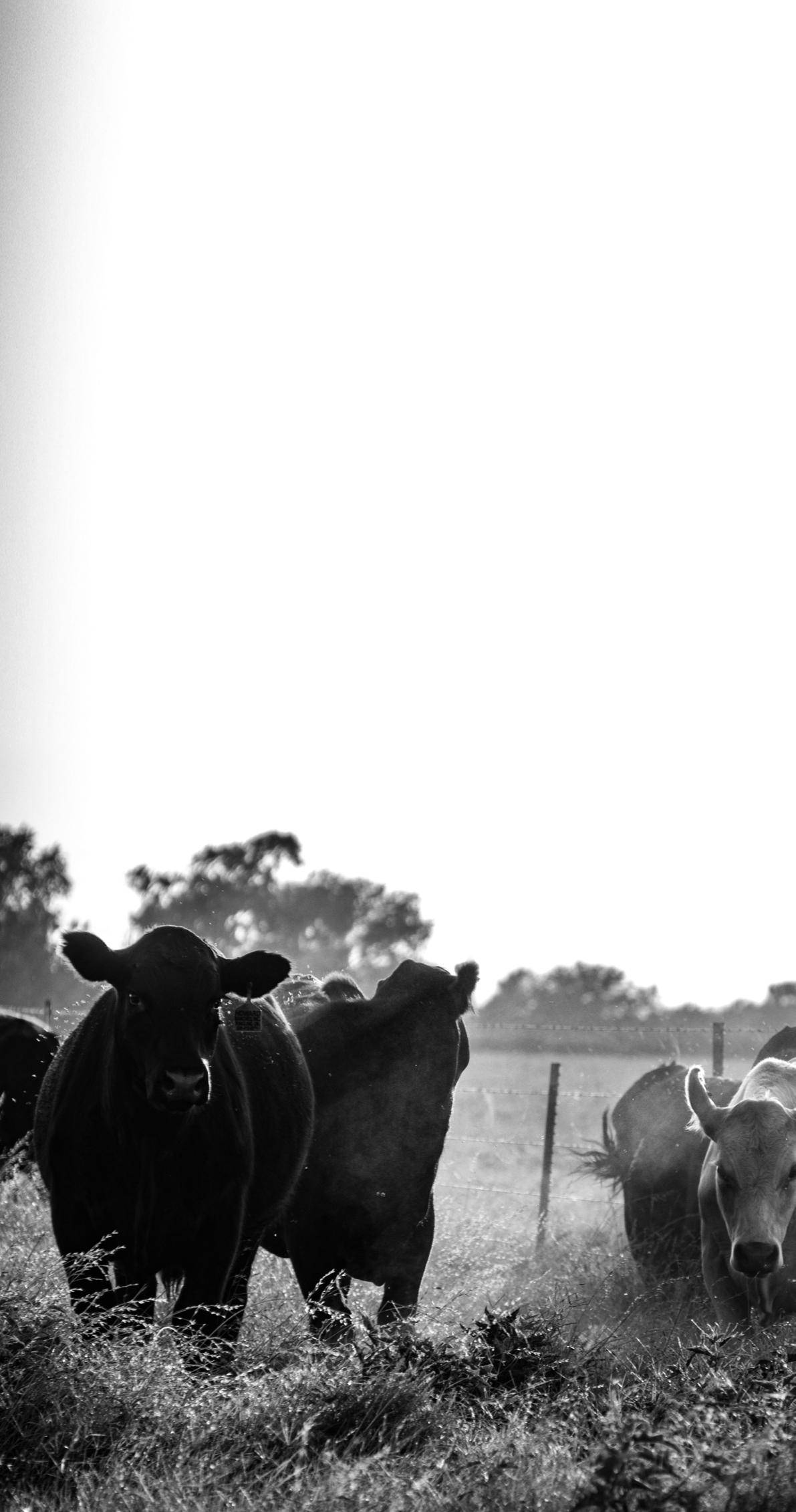
2M Cattle Co. Red Oak
4 Rockin’ P Ranch Beaumont
8K Bar Land & Cattle Co. College Station
A&A Ranch Corrigan
Austin Ackerman Salado
Alexa Alcala Houston
Brynlee Allen McLean
Anderson Cattle Co. Cleveland
Paisley Archer Allison
Amber Arriaga Los Fresnos
Ashton Van Arsdale New Caney
Agustin Ayon Mathis
Ayres Cattle Co. Waelder
Bryce Baca Pflugerville
Bar H Brangus Boswell, Oklahoma
Claire Barbee Hawley
Barbee Ranch Lindale
Samantha Barnard Springtown
JulieAnne Barrett New Braunfels
Brayden Bartosh Livingston
Amie Beetlitz Olton
Kyler Berry Clyde
Hailey Bicking Abilene
Bindseil Ranching Meadowlakes
Black Heart Ranch Kent, Washington
Alleigh Blackwell Iowa Park
Kenneth Blackwell Groom
Blake Studios Benbrook
Blanscet Cattle Co. Henrietta
Rylie Bolling Poolville
Book The Wild Houston
Brittley Bowers Amarillo
Hollis Boyer Christoval
Kelly Brady Keene
Teagen Braun Bartlett
Kelley Brisco Waco
Broussard Farm LLC Beaumont
BSW Cattle San Augustine
Jordyn Bundick Ganado
Caydee Butler Miami
Lauren Butler McKinney
Byrd House Cattle Petersburg
C&S Cattle Santa Fe
C7 Ranch Henrietta Bailey Caballero Lipan
Cantu Farm La Vernia
Chesson Ranch Hamshire
CKI Cattle Co. Slaton
Samantha Clark Elmendorf
Clark Ranch & Horses LLC Pawhuska, Oklahoma
Coastline Cattle LLC El Campo
Coffee Creek Ranch Weatherford
Ty Cook Ravenna
Maci Copeland Stephenville
Claire Corder Scurry
Daniel Corker Seagoville
Covenant Farm Winona
Criadero Paraiso Conroe
Crooked Path Ranch Kempner
Cross H Land LLC Littlefield
Andrea De La Cruz Laredo
Shelley Curry Kennard
Mollie Cutrer Wharton
D3 Land & Cattle Walnut Springs
Dancing Elk Alexander Ranch Mathis
Olievia Dangerfield Katy
David Cattle Pilot Point
Reagan Dejohn Palacios
Dennis Moreland Tack LLC Weatherford
Diamondback Ranch Malakoff
Denisse Diaz Livingston
Jaylie Dickey Mobeetie
Matt Doerge Henderson
Domingue Ranch Katy
Harlie Dorman Hillsboro
Double Cross Nelms Granbury
Double Diamond G San Marcos
The Double K Ranch Austin
Double O Ranch Lovelady
Double S Farm Lubbock
Duncan Ranches Fredericksburg
Terry Ellis Graham
Kamryn Elmere Grandview
Enchanted Oaks Ranch Freeport
Paul Engle Nacogdoches
Fannin Farms DeKalb
FCS Equipment Dallas
Fisher Cattle Co. Frankston
Layne Ford Waller
Wesley Ford Waller
Forth Place Ranch Cranfills Gap
Marly Fosler Amarillo
Cayden Fowler Kaufman
Francois Ranch Copperas Cove
Galvan Leather Pflugerville
Ganske Blackhereford Farm Flint
Gabriella Garcia Pharr
Paityn Garcia Bartlett
Chris Garcia Katy
Alexis Garcia Arlington
Rick & Amy Garrison Dallas
Philip Garvin Dallas
Coleman Glenn Bastrop
Richard Godare Hull
Madeline Gonzalez McKinney
Kailey Gonzalez Laredo
Kristopher Gorecki Miami
Owen Graham Cameron
Grand Fork Ranch Alba
Leland Green Cleburne
Green Trees Ranch Brazoria
Addison Griffin Kaufman
Thomas Groom Brownwood
Diego Guerra Rio Grande City
Nicolas Guerra Rio Grande City
Lyleen Guerrero Olton
Elliana Gurry Grandview
Wesley Haase Wichita Falls
Kambree Hall Bronson
Angela Hammond Angleton
Hadly Hand Henrietta
Hangin Oak Ranch Madisonville
Ethan Harris
Houston
Kayla Hazlett Canyon
Herzog Cattle Chilton
High Order Operations Shallowater
Casey Hoff Windthorst
Kelly Hoffman Ledbetter
Scott Parker Hollingshead San Antonio
Jimmy Holmes Austin
Tyler Hooten Garland
Jeremy Horton Naples, Florida
Doug House Jourdanton
Rance Howard Waurika, Oklahoma
Nathan Huggins Hico
Carlos Isasi Pharr
J Bar B Ranch Johnson City
Gilbert Jaime Montague
Jayda Jameson Roaring Springs
Tommie Jenkins Pineland
Jacob Jenschke Fredericksburg
Jernigan Interests LLC Round Top
Blaine Johnson Harper
Jones Cattle Eastland
Cody Jones Runge
Everett Jones Crandell
Jaela Jones Kaufman
Tyson Jones Westbrook
Bo Jordan Center
JX Howard Ranch LLC Iola
K-Feed Nazareth
K&G Farms Gatesville
K3 Ranch Graham
Ayshin Karayaka Katy
Clay Krause Amarillo
Emma Kuehler Argyle
L2R2 LLC Austin
La Reina Cattle Co. Eagle Pass
Last Resort Livestock Burton
Lazy BJ Ranch Crockett
Noah Lee Terrell
Braelyn Leftuich Kaufman
Shawn Leifeste Cameron
Rylie De Leon Crawford
Matthew Lerdy Kipp
Makinley Lesikar Inez
Ragan Levien Junction
Garin Lindsay Garrison
Log Creek Farms Coldspring
Travis Lopez Eddy
Justus Love Christoval
Darcy Luedke Bellville
Charlie Van Luevon Sanger
Lutz Farm & Cattle Cameron
Lytton Springs Cattle & Land Austin
M Bar A Ranch LLC Bowie
Madera Cattle Corsicana
Derrick Martin Amarillo
Cayden Martinez Katy
Matt Anderson Cattle Crockett
Joe McAdams Ardmore, Oklahoma
John McCullar Jr. Lovelady
Samantha McFarland Bastrop
McGee Ranch Bennington, Oklahoma
Frankie McKinney Childress
MD Ranch
Sherman
Evan Meagher Dallas
Erin Mehta San Augustine
Minerva Live Oak Ranch LLC
Taylor


Herefords are known as the efficiency experts for a reason. Herefords boost pregnancy rates by 7% and add $30 per head in feedyard profitability in a crossbreeding system. And Hereford genetics bring unrivaled hybrid vigor, longevity and disposition.
Moon Shadow Ranch Heath
Jason Morano Grah
Xavier Moreno Ranger
Jacob Mosley Kingwood
Sloan Moss Lubbock
Leroy Munoz Uvalde
Murray Rankin Farms Bigfoot
N7 Farms & Ag McAllen
Nalls Cattle Co. Edgewood
Leyah Nash Houston
Mason Neelley Vega
Mycah Nicholas Denison
NM Contracting LLC Mission
Normangee Ridge Conroe
Kutter O’Keefe Clarendon
Michael Otto Cypress
Macee Parkey Olton
Brittany Patterson Cypress
Pedernal Land & Cattle LLC Big Spring
Penshorn Cattle Co. LLC Schertz
Lydia Perayes Donna
Kadrian Perez Freer
Emma Peters Klein
Zaylee Peyton Dike
PHJ Ranch Operations Mullin
Shannon Pick Mount Calm
Keylan Poe Needville
Quinn Pool Pontotoc
Wesleigh Pool Orange Grove
Azalee Porter Montgomery
Ella Porter Montgomery
Justin Posey Brownwood
Patsy Potter Lindale
Prime Metal Building Dublin
Abigail Quintana Houston
R Bar W Falls City
R&J Farms Lindale
Rafter P Farm Cleburne
Vincent Rains Iowa Park
Raul Ramos Bedias
Rankin Industries LLC Jacksboro
RB Farms Kenny
Red Creek Ranch Crockett
Red Rock Cattle Co. Lincoln
RedRanch Houston
Braelynn Reeves Ganado
Grady Reinke Axtell
Helena Rendon Houston
Rich in Time Farm Gonzales
Kevin Rivera Krum
RO Ranch Eldorado
Robi Ranch Seguin
Rochelle Ranch Yantis
Rocking B Farms Belton
Romine Cattle Montague
Adres De La Rosa Alamo
Alethea Rosas Pharr
Ross Ranch LP Caldwell
Addison Rouse Kenedy
RS Cattle Winnsboro
Sidney Rutledge Ranger
Laney Sanders Kaufman
Shayla Sanders Marshall

Karina Sandoval Lovelady
Ethan Santos Mission
Katelyn Schaumleffel Katy
Seth Ralston Dalhart
Timothy & Jennifer Shelton Comanche
Shibler Limited Co. Farmersville
ShillinOut Ranch LLC Jacksonville
Megan Shrum Denison
Payten Shuping Hale Center
Silver Stache Ranch Cranfills Gap
Naomi Simmons Broaddus
Six Bar Six Ranch LLC Athol, Idaho
Brad Smith Dodge
Caeden Snodgrass Cleveland
Audie Speir Saltillo
Michelle Spoon Weatherford
Kaylin Stacey Livingston
Joe Stanfield Farmersville
Kinder Stanley Talco
Lukas Stifflemire Temple
Sutton Farm & Ranch Mineola
Wiley Swan Poteet
Margie Szczvek Hawley
T Bird Ranch Granbury
Taff Land & Cattle Gilmer
David Taylor Coldspring
Johnny Teague Tomball
Texas White House Cattle Operations LLC Bedford
Lilly Thomas Cleburne
Carly Thompson Houston
Sara Tilghman Crawford
Allison Torres Pharr
Gustavo Torres Eddy
Makinzie Tovar Ganado
Ben Troce Dike
Tumblin B Muenster
TW Wiley Fort Worth
Twin Creeks Ranch Wills Point
Amarachi Uche-Eboh Lubbock
Blaze Upton Vernon
Colt Upton Vernon
Kyle Vahlenkamp Miles
Paizlee Velasquez Grandview
Kase Vogler
Vega
Spencer Walahoski Canyon
Kealeigh Walker Ravenna
Kambre Ward
Whitney Emma Wesson Palestine
Nathan White Houston
Tanner Whitworth Terrell
Journei Wilburn Greenville
Jansyn Wilke Edna
Charles B. Wilkison Van
Richard Wiltse Pattonville
Wolf Ridge Cattle Gainesville
Taylor Woodward Lufkin
Wright Farms Gilmer
Macey Wunderlich Spring Branch
Wynn Ranches
San Antonio
Destiny York Allison
Young Ranch Burkett
Zajic Farms Ennis





Elkhart Horse Auction
Where: Elkhart
Phone: 903-764-1495
Sale Day: Saturday
Contact: Tiffany Patterson, 903-388-7288
Atascosa Livestock Exchange
Where: Pleasanton Phone: 830-281-2516
Sale Day: Tuesday
Contact: Marvin Bendele, 210-213-5890
Four County Auction
Where: Industry Phone: 979-357-2545
Sale Day: Tuesday
Contact: Lisa Sebastian, 979-270-3041
Muleshoe Livestock Auction
Where: Muleshoe
Phone: 806-272-4201
Sale Day: Friday
Contact: Leo Aviles, 956-437-3899
Beeville Livestock Comm.
Where: Beeville
Phone: 361-358-1727
Sale Day: Friday
Contact: Daniel Keese, 361-449-7942
Clifton Livestock Comm. LLC
Where: Clifton
Phone: 254-675-7717
Sale Day: Wednesday
Contact: Larry Brown, 254-265-1920
Meridian L/S Comm. Co.
Where: Meridian
Phone: 254-435-2988
Sale Day: Monday
Contact: Larry Brown, 254-265-1920
J & J Livestock Auction
Where: Texarkana
Phone: 903-832-3576
Sale Day: Saturday
Contact: Cheri Beal, 903-280-4554
Brazos Valley Livestock Comm.
Where: Bryan
Phone: 979-778-0904
Sale Day: Tuesday
Contact: Nina Nygard, 512-281-6753
Caldwell Livestock Comm.
Where: Caldwell Phone: 979-567-4119
Sale Day: Wednesday
Contact: Mark Nygard, 512-281-6330
Lockhart Auction
Where: Lockhart
Phone: 512-398-3476
Sale Day: Thursday
Contact: Nina Nygard, 512-281-6753
Bruce Overstreet Livestock
Where: Pittsburg
Phone: 903-856-3440
Sale Day: Monday
Contact: Michelle Willeford, 903-767-0670
Tri County Livestock Market
Where: New Summerfield
Phone: 903-322-4940
Sale Day: Saturday
Contact: Jerry Boulware, 936-465-1597
Coleman Livestock Auction
Where: Coleman Phone: 325-625-4191
Sale Day: Wednesday
Contact: Dave Williams, 325-669-2030
Cattleman’s Columbus Livestock Auction
Where: Columbus
Phone: 979-732-2622
Sale Day: Wednesday
Contact: Wes Martin, 281-782-4412
Comanche Livestock Exchange
Where: Comanche
Phone: 325-356-5231
Sale Day: Saturday
Contact: Michael Davis, 254-879-3121
The New Gainesville Livestock Auction
Where: Gainesville
Phone: 940-665-4367
Sale Day: Friday
Contact: Robin Gibbs, 903-227-0791
Coryell County Comm.
Where: Gatesville Phone: 254-865-9121
Sale Day: Wednesday
Contact: Ray Davis, 254-718-5512
Cattleman’s Livestock Comm.
Where: Dalhart
Phone: 806-249-5505
Sale Day: Thursday
Contact: Clifton Miller, 806-570-7439
Hereford Livestock Auction
Where: Hereford
Phone: 806-240-3082
Sale Day: Tuesday
Contact: Joe Bob Via, 806-452-9280
Cuero Livestock Comm.
Where: Cuero Phone: 361-275-2329
Sale Day: Friday
Contact: Kaylee Malatek, 979-942-0323
Texas Cattle Exchange
Where: Eastland Phone: 254-629-2288
Sale Day: Tuesday
Contact: Shondra Davis, 325-642-5542
Dublin Livestock Auction
Where: Dublin Phone: 254-445-1734
Sale Day: Friday
Contact: Mike Heck, 806-886-6554
Erath County Dairy Sale
Where: Dublin Phone: 254-968-7253
Sale Day: Friday Contact: Bob McBryde, 940-859-6217
Stephenville Cattle Co.
Where: Stephenville Phone: 254-968-4844
Sale Day: Wednesday Contact: Bob McBryde, 940-859-6217
Flatonia Livestock Comm.
Where: Flatonia Phone: 361-865-3538
Sale Day: Monday
Contact: Vance Weltner, 210-473-9099
Schulenburg Livestock Auction
Where: Schulenburg Phone: 979-743-6566
Sale Day: Saturday Contact: Vance Weltner, 210-473-9099
Floydada Livestock Sales
Where: Floydada Phone: 806-983-2153
Sale Day: Wednesday
Contact: JE Stone, 806-777-4396
Pearsall Livestock Auction
Where: Pearsall
Phone: 830-334-3653
Sale Day: Wednesday
Contact: Clarence Stevens, 210-415-0441
Gillespie Livestock Co.
Where: Fredericksburg Phone: 830-997-4394
Sale Day: Wednesday
Contact: Larry Bowden, 210-846-0380
Gonzales Livestock Market
Where: Gonzales
Phone: 830-672-2845
Sale Day: Saturday
Contact: JoGayle Stavena, 979-332-2186
Nixon Livestock Comm.
Where: Nixon
Phone: 830-582-1561
Sale Day: Monday
Contact: Landyn Maguglin, 361-492-9484
Longview Livestock
Where: Longview
Phone: 903-235-6385
Sale Day: Thursday
Contact: Paul Pruitt, 903-725-6200
Mid-Tex Livestock Auction
Where: Anderson
Phone: 936-825-3970
Sale Day: Thursday
Contact: Rick Faught, 936-442-1039
Navasota Livestock Auction
Where: Navasota
Phone: 936-825-6545
Sale Day: Saturday
Contact: Rick Faught, 936-442-1039
Seguin Cattle Co.
Where: Seguin
Phone: 830-379-9955
Sale Day: Wednesday
Contact: Elizabeth Cortez, 830-857-1945
Hamilton Livestock Comm.
Where: Hamilton
Phone: 254-386-3185
Sale Day: Tuesday
Contact: Bob McBryde, 940-859-6217
Gore Family Auction Center
Where: Silsbee
Phone: 409-782-0612
Sale Day: Saturday
Contact: Christy McCoy, 409-782-0612
Athens Comm. Co.
Where: Athens
Phone: 903-675-3333
Sale Day: Friday
Contact: Brandy Baughman, 903-440-4382
Edinburg Livestock Auction
Where: Edinburg Phone: 956-383-5671
Sale Day: Saturday
Contact: Coney Alvarez Jr., 956-437-3899
Hubbard Livestock Market
Where: Hubbard Phone: 254-576-2584
Sale Day: Monday
Contact: Patrick Romine, 254-723-0950
Sulphur Springs Livestock Comm.
Where: Sulphur Springs
Phone: 903-885-2455
Sale Day: Monday
Contact: Paul Pruitt, 903-725-6200
East Texas Livestock Auction
Where: Crockett
Phone: 936-544-2246
Sale Day: Tuesday
Contact: Cheyenne London, 936-222-3689
Big Spring Livestock Auction
Where: Big Spring
Phone: 432-267-5881
Sale Day: Wednesday
Contact: Bruce Brandenberger, 254-977-5763
Edna Livestock Auction
Where: Edna Phone: 361-782-7666
Sale Day: Monday
Contact: Galynn Mazoch, 979-578-1823
Kirbyville Auction Barn
Where: Kirbyville
Phone: 409-423-2612
Sale Day: Saturday
Contact: Erica Morgan, 409-509-1946
Gulf Coast Livestock Market
Where: Alice Phone: 361-664-4395
Sale Day: Tuesday
Contact: Ramiro Garcia, 361-460-0008
Johnson County Cattle Auction
Where: Cleburne Phone: 817-556-9090
Sale Day: Saturday
Contact: Lee Snyder, 254-707-1682
Karnes City Auction
Where: Karnes City Phone: 830-780-3382
Sale Day: Wednesday
Contact: Douglas Brunet, 830-708-6537
Karnes County Livestock Exchange
Where: Kenedy Phone: 830-583-2574
Sale Day: Thursday
Contact: Elizabeth Cortez, 830-857-1945
Cattlemen’s Livestock Comm.
Where: Paris
Phone: 903-784-2238
Sale Day: Saturday
Contact: Lana Caldwell, 903-908-0530
Paris Livestock Auction
Where: Paris Phone: 903-739-2575
Sale Day: Wednesday
Contact: Robin Gibbs, 903-227-0791
Hallettsville Livestock Comm.
Where: Hallettsville Phone: 361-798-4336
Sale Day: Tuesday
Contact: Kaylee Malatek, 979-942-0323
Giddings Livestock Comm.
Where: Giddings Phone: 979-542-2274
Sale Day: Monday Contact: Nina Nygard, 512-281-6753
Lexington Livestock Comm.
Where: Lexington Phone: 979-773-2922
Sale Day: Saturday Contact: Nina Nygard, 512-281-6753
Buffalo Livestock Comm.
Where: Buffalo Phone: 903-322-4940
Sale Day: Saturday Contact: Cheyenne London, 936-222-3689
Raywood Livestock Market
Where: Raywood Phone: 936-587-4941
Sale Day: Monday
Contact: Harvey Williamson, 963-334-5325
Groesbeck Auction & Livestock
Where: Groesbeck Phone: 254-729-3277
Sale Day: Thursday
Contact: Mallory Steen, 903-390-0594
Live Oak Livestock Auction
Where: Three Rivers Phone: 361-786-2553
Sale Day: Monday
Contact: Marvin Bendele, 210-213-5890
Jordan Cattle Auction
Where: Mason Phone: 325-347-6361
Sale Day: Monday
Contact: Warren Ottmers, 830-669-2262
West Auction
Where: West
Phone: 254-826-3725
Sale Day: Thursday
Contact: Ray Davis, 254-718-5512
Union Comm.
Where: Hondo
Phone: 830-741-8061
Sale Day: Monday
Contact: Clarence Stevens, 210-415-0441
Milam County Livestock Auction
Where: Cameron Phone: 254-697-6697
Sale Day: Friday
Contact: Rick Faught, 936-442-1039
Nacogdoches Livestock Exchange
Where: Nacogdoches Phone: 936-564-8661
Sale Day: Thursday
Contact: Michael Witcher, 936-556-0992
Corsicana Livestock Market
Where: Corsicana
Phone: 903-872-1631
Sale Day: Tuesday
Contact: Katy Webb, 903-388-4390
Carthage Livestock Auction LLC
Where: Carthage
Phone: 903-693-6361
Sale Day: Tuesday
Contact: Lori Blankenship, 936-234-3441
Livingston Livestock Exchange
Where: Livingston Phone: 936-327-4917
Sale Day: Saturday
Contact: Harvey Williamson, 963-334-5325
Lonestar Stockyards
Where: Amarillo
Phone: 806-677-0777
Sale Day: Tuesday
Contact: Gary McClellan, 806-334-0517
Emory Livestock Auction
Where: Emory
Phone: 903-473-2512
Sale Days: Tuesday & Saturday
Contact: Brandy Baughman, 903-440-4382
Calvert Livestock Co.
Where: Calvert
Phone: 979-364-2829
Sale Day: Friday
Contact: Ray Davis, 254-718-5512
Hunt Livestock Exchange
Where: Henderson
Phone: 903-657-2690
Sale Day: Monday
Contact: Samuel Steadman, 318-617-1141
Jordan Cattle Auction
Where: San Saba
Phone: 325-372-5159
Sale Day: Thursday
Contact: David Munden, 325-456-7253
Center Auction Co.
Where: Center
Phone: 936-598-4395
Sale Day: Wednesday
Contact: Michael Witcher, 936-556-0992
Triple G Livestock Auction LLC
Where: Rio Grande City
Phone: 956-437-1988
Sale Day: Friday
Contact: Coney Alvarez Jr., 956-437-3899
Tulia Livestock Auction
Where: Tulia Phone: 806-995-4184
Sale Day: Thursday
Contact: Tommy Thompson, 806-690-4080
Abilene Auction
Where: Abilene Phone: 325-673-7865
Sale Day: Tuesday
Contact: Dave Williams, 325-669-2030
Stone Livestock Comm.
Where: Mt. Pleasant
Phone: 903-575-9099
Sale Day: Tuesday
Contact: Paul Pruitt, 903-725-6200
Producers Livestock Auction
Where: San Angelo
Phone: 325-653-3371
Sale Day: Thursday
Contact: Bruce Halfmann, 325-315-5972
Southwest Livestock Exchange
Where: Uvalde
Phone: 830-278-5621
Sale Day: Thursday
Contact: Clarence Stevens, 210-415-0441
Mort Livestock Exchange
Where: Canton Phone: 903-287-6386
Sale Day: Special Sales Only
Contact: Paul Pruitt, 903-725-6200
Brenham Livestock Auction
Where: Brenham
Phone: 979-836-3621
Sale Day: Friday
Contact: Lisa Sebastian, 979-270-3041
El Campo Livestock Exchange LLC
Where: El Campo
Phone: 979-543-2703
Sale Day: Tuesday
Contact: Galynn Mazoch, 979-578-1823
Wharton Livestock Auction
Where: Wharton
Phone: 979-532-3660
Sale Day: Wednesday
Contact: Megan Stavena, 979-320-4228
Wichita Livestock Sales
Where: Wichita Falls Phone: 940-541-2222
Sale Day: Wednesday Contact: R.C. Langford, 832-330-7279
Decatur Livestock Market
Where: Decatur Phone: 940-627-5599
Sale Day: Monday
Contact: Rebecca Benson, 940-389-6382
Winnsboro Livestock Auction
Where: Winnsboro Phone: 903-365-2201
Sale Day: Friday
Contact: Alan Pruitt, 903-725-6200
Graham Livestock Comm. LLC
Where: Graham Phone: 940-549-0078
Sale Day: Monday
Contact: Ronnie Ober, 817-371-7071













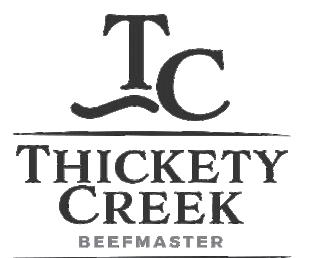






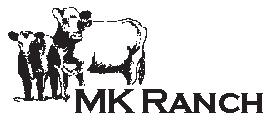






CHAROLAIS BULLS
One or a truckload - Give us a call SW&S Cattle Company Don and Kathy Schill 903-388-1342 • Donie, Texas
T HOMAS CHAR O LAIS, INC . P.O. Box 595 • Raymondville, Texas 78580

Mitch Thomas: 956-535-0936
Tonnyre Thomas Joe: 956-535-0942 thomasra@gte.net www.thomascharolais.com


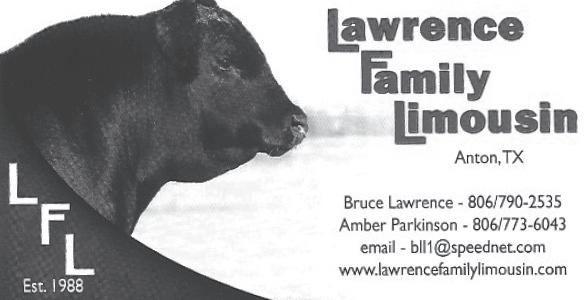

Ranch located six miles north of Big Lake, Texas on Highway 137.
Steve Wayne Coates Box 645 Mertzon, TX 76941 325/835-2531
Registered Polled Herefords
McDade, Texas Rusk, Texas 512.970.1595 512.970.3588
www.DoubleDiamondHerefords.com





TX 75762
903-520-0390 mbpga@aol.com
903-530-8551 wtnca@aol.com
“Registered Herefords Since 1938” Email: john@dudleybros.com

Theuret Herefords Horned Bulls and Females

John 325-642-0745 Tom 325-642-0748 Comanche, Texas; Ph 325-356-2284


923 Hillside Ave. Canadian, TX 79014 806-323-2906 lee@indianmoundranch.com www.indianmoundranch.com Lee & Jacqui Haygood
CR 165, Kenedy, TX 78119 theuret@sbcglobal.net 210-315-0103
J .T . E chols DVM P.O. Box 709 Breckenridge, TX 76424 Of: (254) 559-9739 • Cell: (254) 559-0156 muleshoeranch@gmail.com
“Quality Registered Herefords” Est.1921 – Bulls for sale at all times out of good milking cows Office: 512-446-6200 Cell: 979-218-0065






Santa Gertrudis


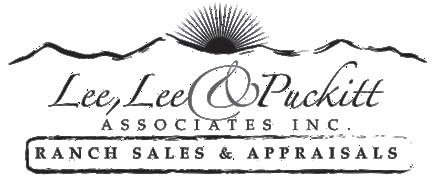


641-4771
BRIGGS RANCHES P.O. Box 1417 Victoria, Texas 77902 361/573-7141
Traylor Division San Roque DivisionSan Carlos Division Bloomington, TX Catarina, TXRio Grande City, TX Joe Jones-Manager • 361/897-1337





AND LIVESTOCK –
± acres a few miles southeast of Tucumcari, NM in Quay County. A total of 112.3 ± acres irrigated, 107 ± acres of native grassland, and 40 ± acres of dry farmland is combined with a 20’

or Red Simbrah • SimAngus HT • SimAngus
ATTLE C OMPAN Y Joe & Beth Mercer 327 CR 459, Lott, TX 76656 • 956-802-6995 bethmercer1974@gmail.com • www.filegoniacattle.com

(806) 983-7225 mbl. / fosterbros@att.net
David & DarLee Foster (806) 652-3824 (806) 983-7221

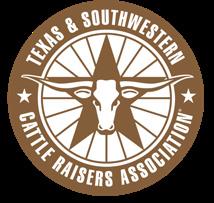
With crisp, clean markings, you can personalize Allflex Custom Tags with a logo, promote practices and sort cattle by combining colors with custom text.
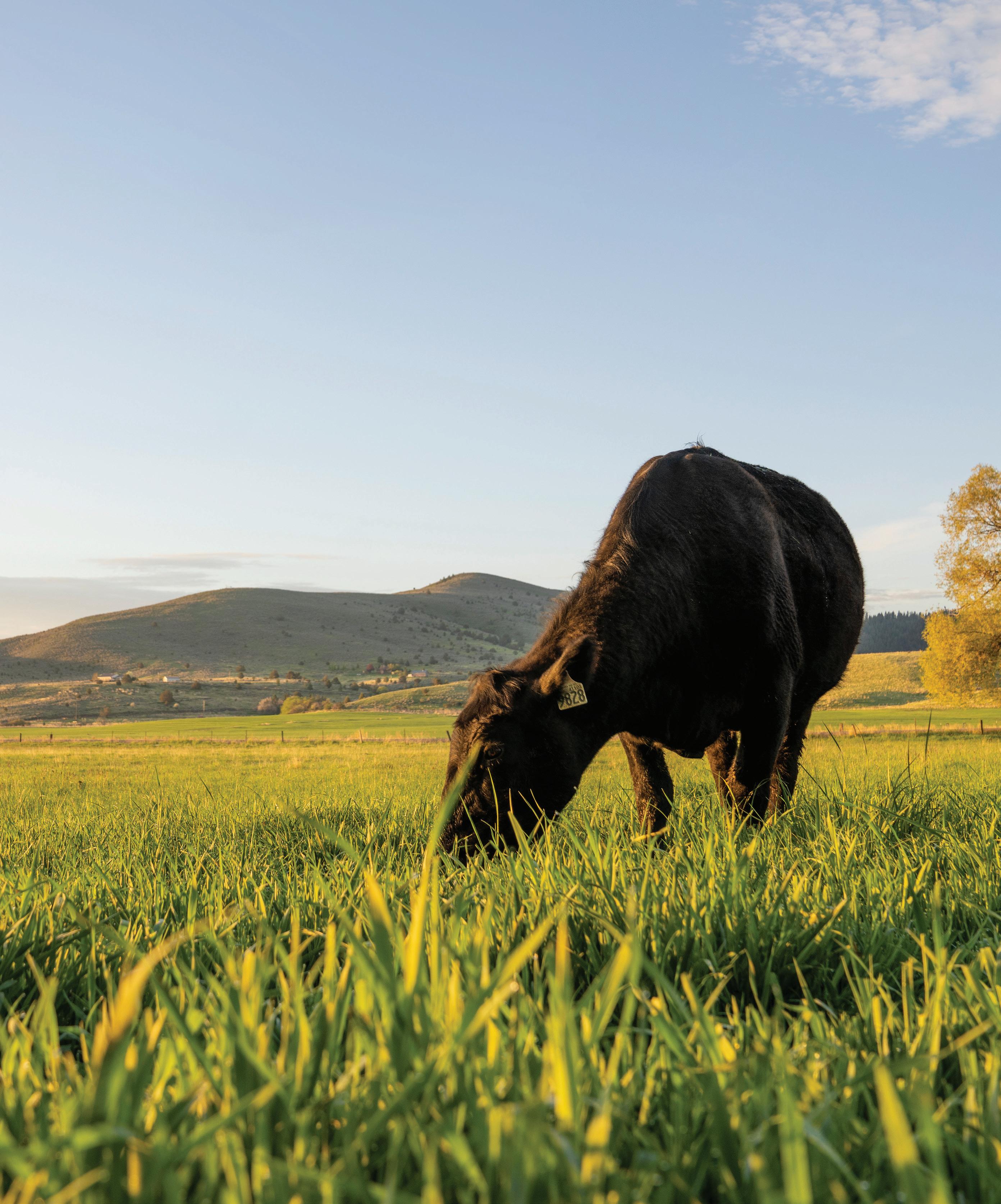

WEDNESDAY, OCT. 1
TSCRA Young Cattlemen’s Conference and Spring Internships Applications Due
Halfmann Land & Livestock: 2025 Annual Fall Sale Where: Miles When: 1 p.m.
THURSDAY, OCT. 2
Dudley Bros: 64th Annual Bull Sale Where: Comanche When: 12 p.m.
Bayou Creek Ranch: 7th Annual Production Sale
Where: Lone Grove, Oklahoma When: 1 p.m.
On the Road with TSCRA: New World Screwworm Education Where: Producers Coop, Bryan When: 6 p.m.
SATURDAY, OCT. 4
TSCRA & TCU Ranch Management Football Tailgate Where: Fort Worth When: TBD
TUESDAY, OCT. 7
McKenzie Land & Livestock: 2nd Annual Fall Bull Sale Where: Fort Stockton When: 1 p.m.
TUESDAY, OCT. 7 -
WEDNESDAY, OCT. 8
R.A. Brown Ranch: Bull, Female & Quarter Horse Sales Where: Throckmorton
THURSDAY, OCT. 9
Special Bull Sale
Where: Jordan Cattle Auction, San Saba When: 10 a.m.
GKB Cattle: 2nd Annual Fall Bull Sale Where: Desdemona When: 12 p.m.
TSCRA Ranch Gathering Where: Westhoff When: 5:30 p.m.
SATURDAY, OCT. 11
Thomas Charolais: 24th Annual Bull Sale Where: Raymondville When: 1 p.m.
SUNDAY, OCT. 12TUESDAY, OCT. 14
Texas Cattle Feeders Assoc. Annual Convention Where: Fort Worth
TUESDAY, OCT. 14
Powell Ranch Herefords: 28th Annual Production Sale Where: Fort McKavett When: 12:30 p.m.
TSCRA Ranch Gathering Where: San Angelo When: 5:30 p.m.
WEDNESDAY, OCT. 15
12th Annual Hill Country Youth Heifer Sale Where: Jordan Cattle Auction, San Saba When: 11 a.m.
THURSDAY, OCT. 16
TSCRA Ranch Gathering Where: Fredericksburg When: 5:30 p.m.
Wilks Ranch: Elite Female Sale Where: Eastland When: 6 p.m.
FRIDAY, OCT. 17SATURDAY, OCT. 18
Strait Ranches & Hefte Ranch: 2025 StraitHefte Tried & True Production Sale Where: Streetman
SATURDAY, OCT. 18
Beefmaster Beef-on-Forage Genetics: Bull & Female Sale Where: Brenham
MONDAY, OCT. 20
TSCRA Ranch Gathering Where: Buffalo Gap When: 5:30 p.m.
TUESDAY, OCT. 21
Ranching 101: Disease DefenseRecognizing & Treating Common Illnesses Where: Online When: 1 p.m.
SATURDAY, OCT. 25
44 Farms: Fall Bull Sale Where: Cameron When: 10 a.m.
Fall “Best of the Best” Replacement Female Sale
Where: Jordan Cattle Auction, San Saba When: 10 a.m.
South Texas Hereford Assoc.: Fall Bull Sale & Pride of Texas Female Sale
Where: Beeville Livestock Comm., Beeville When: 12 p.m.
Oak Creek Farms: Fall Brangus Bull Sale Where: Chappell Hill When: 12:30 p.m.
7P Ranch: 50th Annual Fall Production Sale Where: Winona When: 1 p.m.
Nipp Charolais: 17th Annual Bull & Female Sale Where: Wilson, Oklahoma When: 1 p.m.
TSCRA & Texas Tech Football Tailgate Where: Lubbock When: TBD
SUNDAY, OCT. 26TUESDAY, OCT. 28 Farmer Veteran Stakeholders Conference Where: Waco Convention Center, Waco
WEDNESDAY, OCT. 29
TSCRA Ranch Gathering Where: Leonard When: 5:30 p.m.




S
U
W
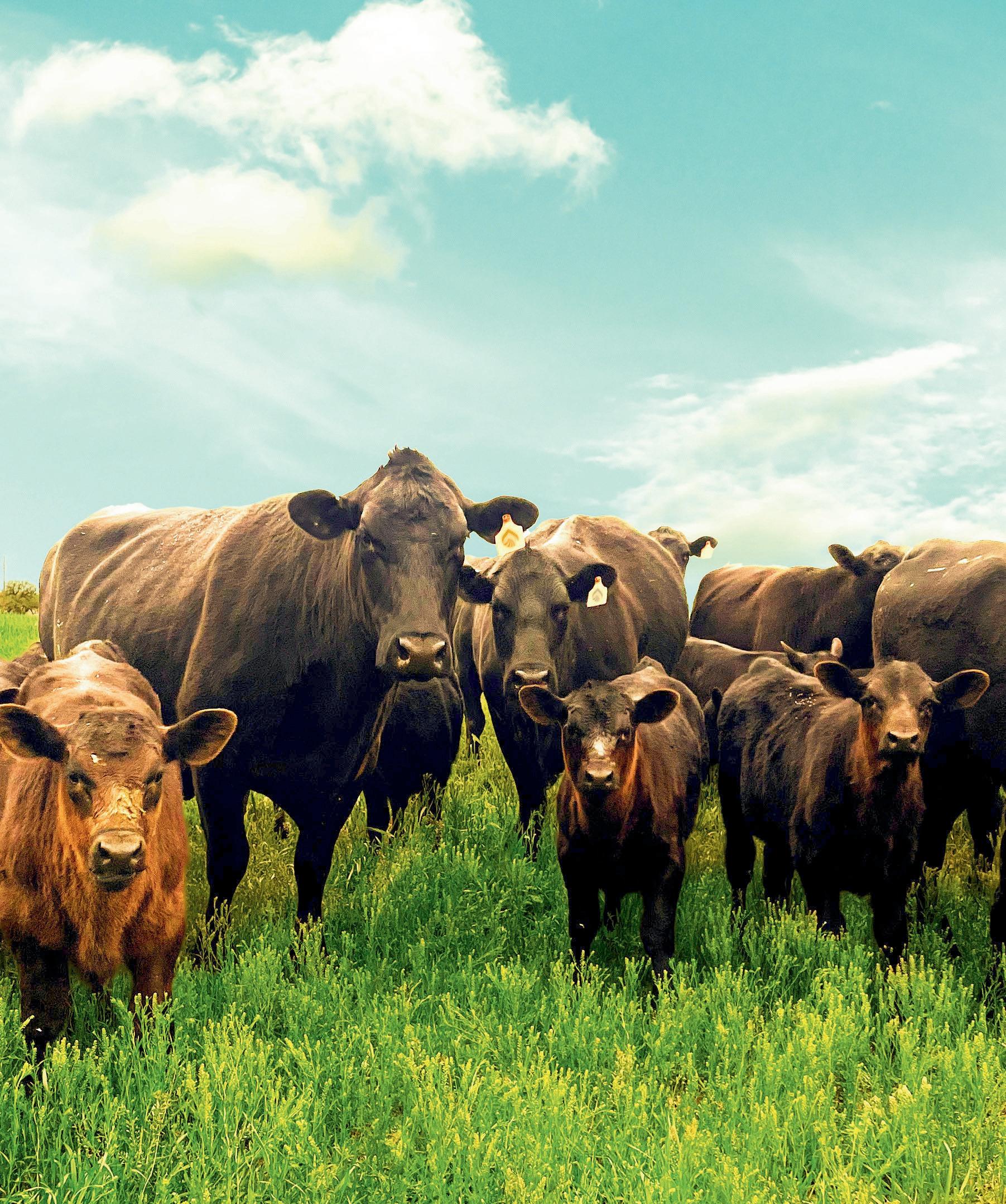









A century ago, writer A.L. Spellmeyer shared a prediction that a land boom and population increase was headed to West Texas and the Panhandle.
“The Marfa and Alpine districts have fine grass, and the Panhandle is one great sea of fine cattle, waving milo and profitable cotton,” Spellmeyer wrote. He projected the city of Amarillo would quadruple its population in the next five years, along with many others.
“The development of pending irrigation problems along the Canadian will ensure the permanency of that Texas prosperity and growth,” he said.
Featured on the cover was 10-year-old Maxine Mayes and her horse, Fritz. She was the daughter of Mr. and Mrs. H.R. Mayes, San Angelo, and granddaughter of J.A. Todd, Muskogee, Oklahoma. T C
“Several years ago I made the switch to Nelson Tetraploid Ryegrass from Gulf ryegrass. NO WAY I’m going back to Gulf... Nelson increases forage production and extends grazing days. With Nelson, the ranch is producing more Beef, and that means more dollars to our bottom line ... with only a little extra seed cost. The extra production from this switch to Nelson really helps to reduce our costs. (fertilizer and fuel costs)
I’m staying with Nelson Ryegrass! NO WAY I’m going back... My cattle like it... and so do I!”

Carlos Bonnot - DVM
Bonnot Ranch • La Ward, Texas


